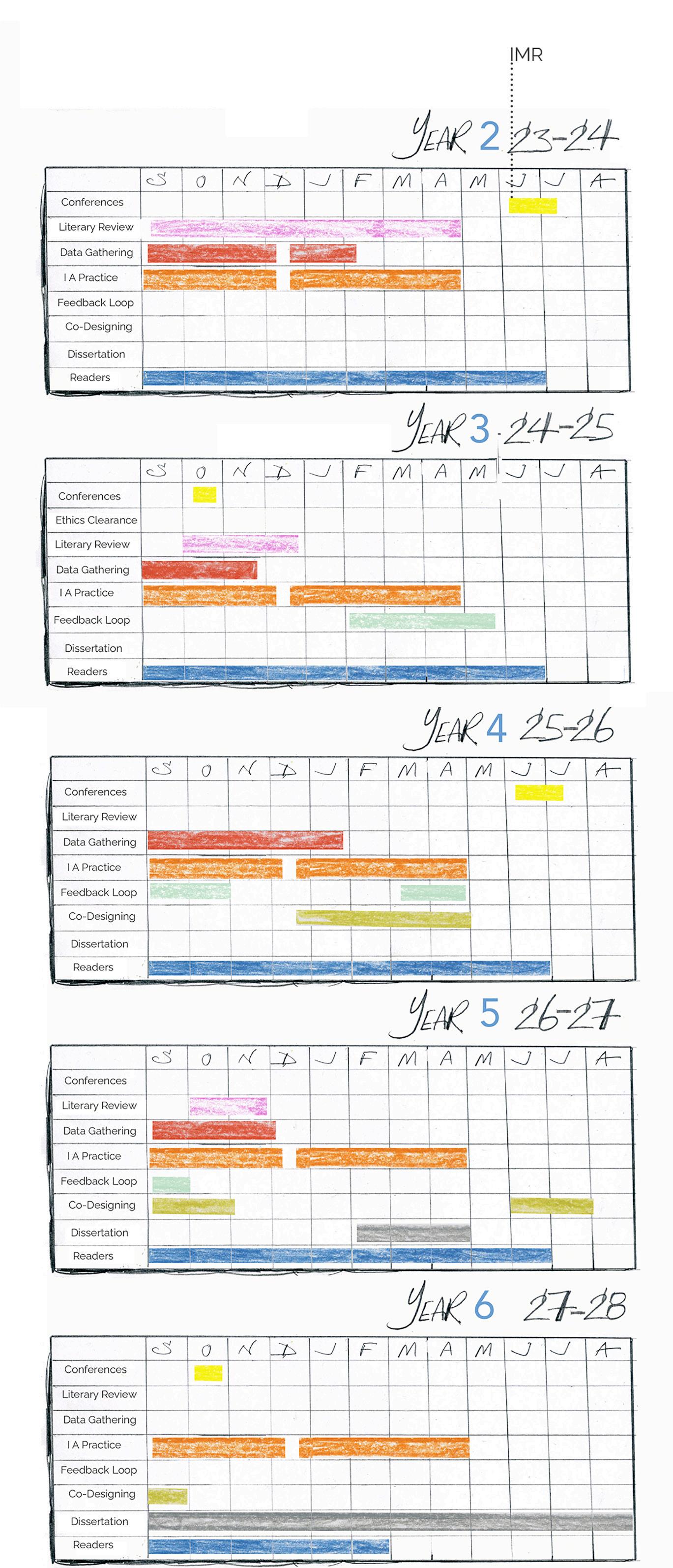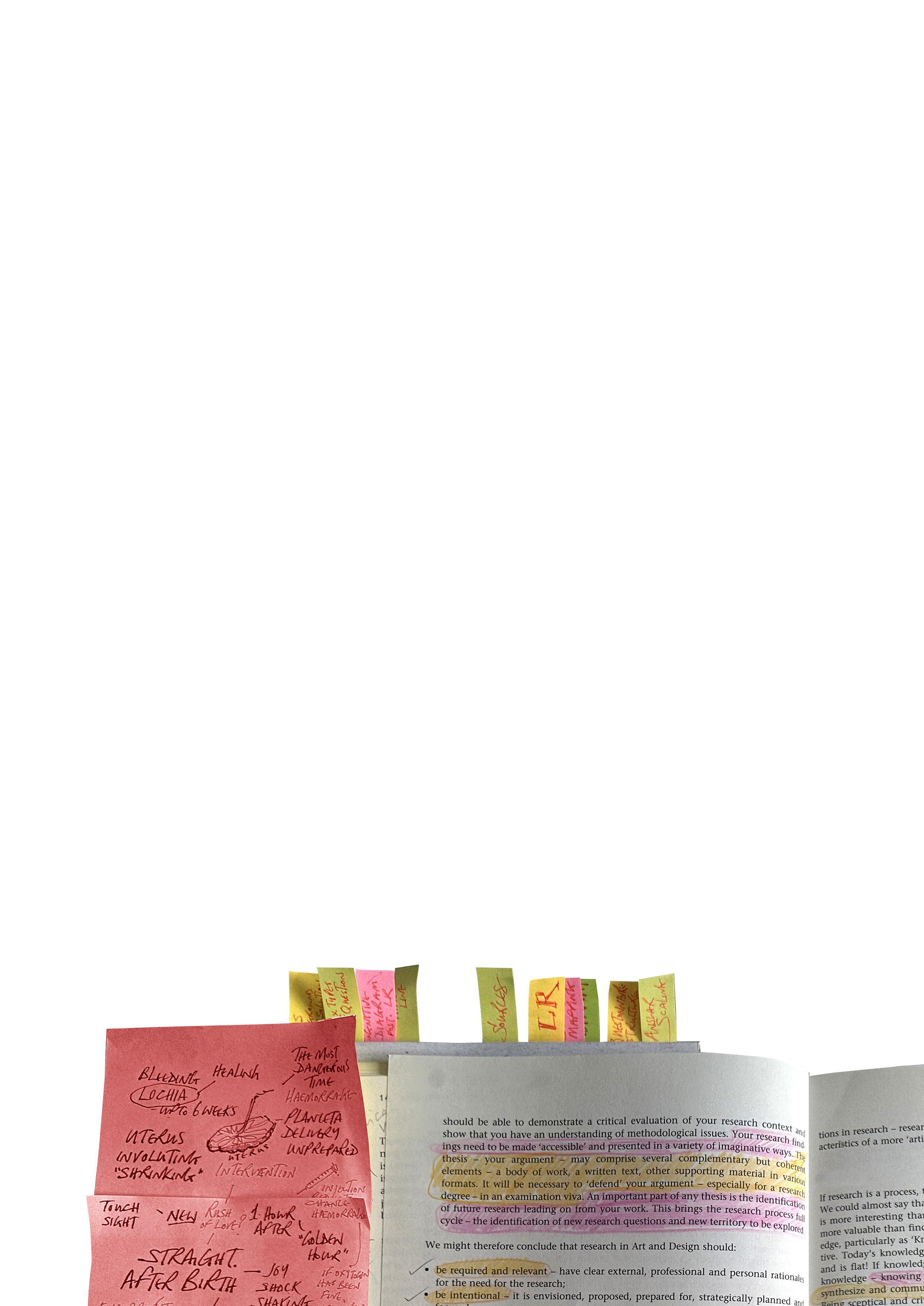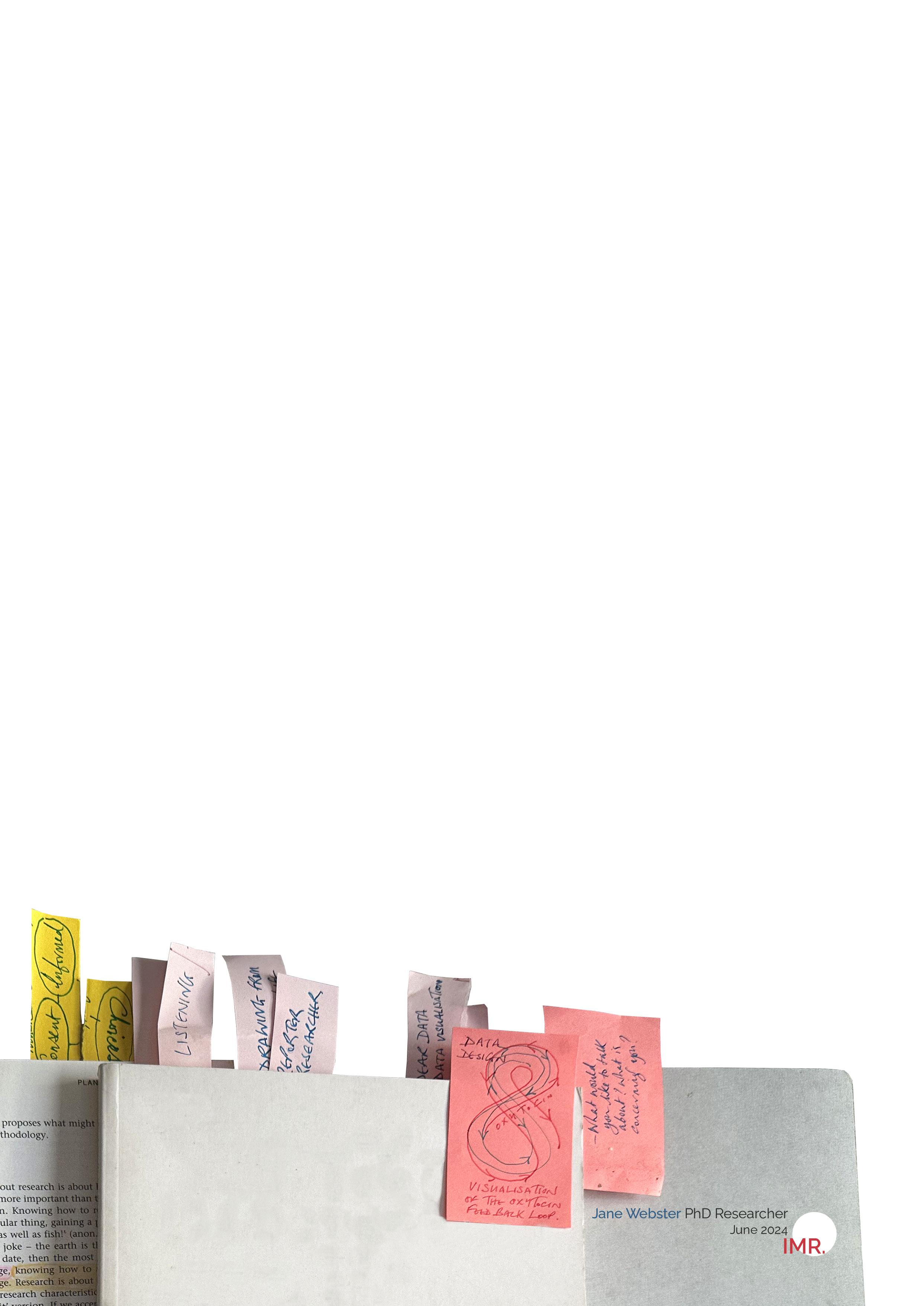
CONTENTS:
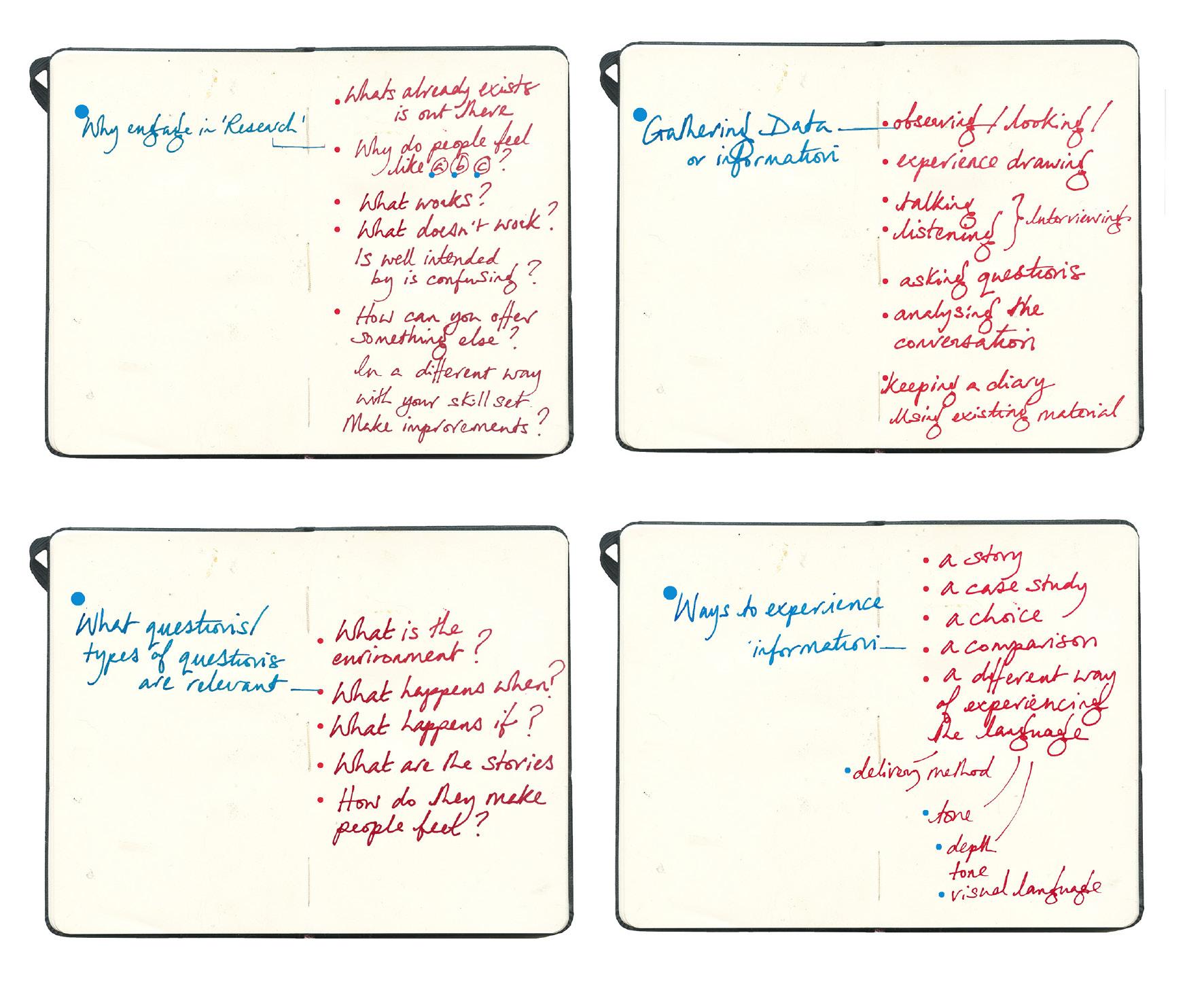
Page 1...Birth Stories Abstract
Pages 2-5...Tutorials from Academic your 2023-24.
Page 6-7...are.na digital platform for connecting ideas and building knowledge
Page 8-27...Literary review
Pages 28-29...Categories of books from the literary review
Pages 30-31... Annotated categories of books from the literary review
Pages 32-36...Television programme review
Page 37...Review of Badassmotherbirther’s Instagram page
Page 38-41...Written and visualisation of Literary review
Pages 42-43...Conferences, applied to, accepted and attending
Page 44-45...Practice based research - Illustration Animation Practice
Page 46-48...Talking with Emily McMorrow- Maternity worke
Page 49...Mental Canvas
Page 50-51...Drawing for animation frames
Pages 52-53...Animation key frames
Page 54-55... Drawing for animation frames
Page 56-57...Animation principles and processes
Page 58-59... Drawing for with Sennelier oil bar
Page 60-62... Drawing for animation blood test film
Page 63..I.P. Refelction continued, Research ‘Ball’ diagram
Page 64...Alys post- birth feedback
Page 65... Reflections from IMR presentation Birth Stories-PhD Timeline
Birth Stories‘How can confidence and choice be encouraged in the experience for birthing Mothers through Illustration Animation practice?
“There’s no such thing as a normal birth- every birth is a story.” Emily McMorrow Maternity Support Worker KMU.
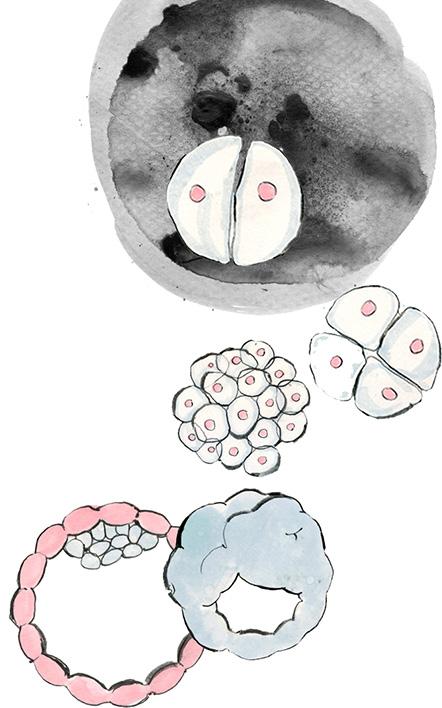
As a practice-based PhD, this research project aims to illuminate women’s perceptions of a ‘normal’ birth experience or story. In collaborates with Kingston Maternity Unit (K.M.U.) and West Middlesex Hospital (W.M.H.) South London, UK. The ‘Birth Stories’ research project aims to highlight and evaluate how illustration animation practice, as a documentary research method, can acknowledge and communicate diverse perspectives of the childbirth experience.
We are striving to offer innovative interdisciplinary visual approaches to empower women to make informed decisions at all stages of the birthing journey—the key to developing meetings with K.M.U.’s clinical staff and drawing at W.M.H. through the Chelsea and Westminster Plus Arts Charity.
These experiences shed light on how childbirth does not align with their initial expectations or the predetermined canonical version for many women. Pregnant women are encouraged to consider a detailed birth plan - identifying birthing location, ideal pain relief options, birth partners, the holding /feeding of the baby post-delivery.
However, many women experience their baby’s birth considerably differently from their’ birth plan’, resulting in an unexpected story. Many factors can determine the narrative of any birth experience pre-during and postpartum.
Through documentary conversations and drawing pre- and postpartum, we aim to familiarise and empower women through female experience and perspective. Conflicting information can result in less satisfactory childbirth experiences; increased knowledge of choices and confirmative experiences have potential to contribute to a more transparent birth story.
From the research so far, we have established women ‘play down’ the trauma experienced by seeing haemorrhaging and long-drawn-out births as being ‘par for the course’ and not needing to be recognised as requiring recovery time. Through drawing, the research investigates why accurate birth information is guarded and why the choices of how one’s expected birth story can take a different route and not the perceived or expected reality.
Abstract Updated: April 2024
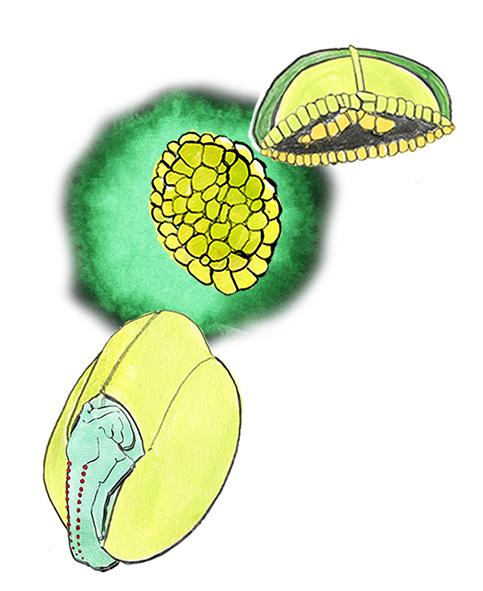
“I am assuming that as this is still an early stage of the PhD narrative, the breadth of looking at a subject through the title question comes before the depths of what those findings are and how they can be developed into a design process that will be useful to my intended audiences” Yes absolutely! I think everything up to upgrade can be considered an early stage, but we will want to move towards getting some of those deeper investigations going as they are develops. Discussing which aspects of your research you might want to dig into further would be a good topic for our next meeting.
Do you think that telling some of the stories, or excerpts of the stories, related in the first column might be an element of the work you produce for the PhD? As primary research, these interviews already do a good job of underscoring the complex and individual nature of every birth. The comments about dismissing the traumas that can be caused by aspects of birthing and the lack of acknowledgement of the time needed to recover also made me think of the pressure women can often feel to return to work quickly, and the more general, inherently ableist, expectation of constant productivity everyone is subject to.
“I find that sometimes it can feel that you are continuing to “empty” yourself advice and information to students” – as it’s the end of term I identify very strongly with that statement!
The Birth Rights Collection conference sounds great! And graphic medicine, I’ll be submitting something to that too. The website is now live, proposals due January 26th
Interviews / text reports
I really like the way you frame the stories you’ve been telling us through interviews and text reports, things like calling it “listening with Justine Howlett” rather than “interview with Justine Howlett”, and the comment “three new babies have been safely delivered in this reader” on the first page. The fact that your excitement at seeing these new lives being created, and the supportive nature of the relationship you have with their mothers, is strongly evident in the conversations, feels important. I don’t mean just as a “nice, touchyfeely” flavour to the research, but actually as an important part of your methodology. Approaching your topic from a starting point of empathy and care improves the quality of the research. It’s obvious from all of the documentation in the readers that it means you get better, richer responses from your primary research subjects. But it’s also important to how you think about the project, making sure that the mother’s experience is centred. You do all of this stuff naturally, of course but when you get
to writing more formal accounts of your methodology I think it needs to be emphasised as not just morally and emotionally but also intellectually important. Justine mentioned access and who is able to advocate for themselves. For me it was interesting that you introduced her desire to be well-informed during her pregnancy in direct connection to her level of education – already indicating a link between the social capital possessed by graduates and their ability to self-advocate. The bit in the conversation where you explained to Justine what you’re doing with the animation was great – more of that please!
Practice
That would probably be my main overall comment. It feels a bit odd to be giving you advice that we probably both give to our students all the time, but I think the role of practice could be interrogated a bit more here. You explained to Justine that with the animation drawings you were searching for a visual language that balanced accuracy and softness. That might feel very obvious to you, but I found it useful to read in terms of understanding what you were getting out of producing that work. I think it would be worthwhile doing more written reflection on your practical experiments and documentation. This can comment not just on visual language but on choices of subject matter. There’s a strong focus on the details of biological processes (in general, I think, but maybe particularly so in this reader). It would be interesting to read some comments on what understandings you get from visually recording and interpreting this sort of subject matter, as opposed to, say, making drawings of environments or events that are actually a direct part of the birthing experience (like your earlier drawings of rooms and equipment at Kingston maternity unit). What different “ways in” to the project do these different drawing exercises give you?
(I’m not saying you haven’t included commentary on the practical work, there is a fair bit in here, but it can tend towards the descriptive – giving context to the Hunterian collection, for example, or explaining what stages of pregnancy are captured in different drawings)
Reading/secondary material
There isn’t really much point in reproducing newspaper articles (PP.23–24), better to just include references and give a summary of what you found interesting/useful about them, with a few quotes to back up your commentary – like what you’ve done with the books.
Some substantial texts on PP.29–30. Kitzinger seems to have struck a chord, and I’m sorry to hear that it took you a long time to get through The Story of Pain, but also pleased to hear that you’ve got a lot out of it!
I like the fact that Michael Stafford’s book had been recommended to you by a previous interviewee, and that most of your commentary on this book consists of visual analysis. Those two features give a sense of continuity and development, and we start to get a feeling of different aspects of research working together. As part of developing the literature review it will also be a good idea to try to get an overview of illustrated, or at least visually led, material that is offered to expectant mothers to support the birthing process. I don’t mean stuff like that Dr Spock book, but trying to find examples of things like bespoke plan is produced by the Positive Birth Company (mentioned in the first Times article) – what do these plans look like? How are they presented? What sort of material and information do they cover? That might take a bit more digging, as it’s less easily available, but would be informative, I think.
Meeting with Kate
Nothing to add here – she knows the stuff much better than I do! In fact I learned something about the details of how ethics applications are processed at Kingston by reading it!
Tutorial notes and feedback from meeting with Geoff Grandfield and Dr John Miers. 15/01/24.
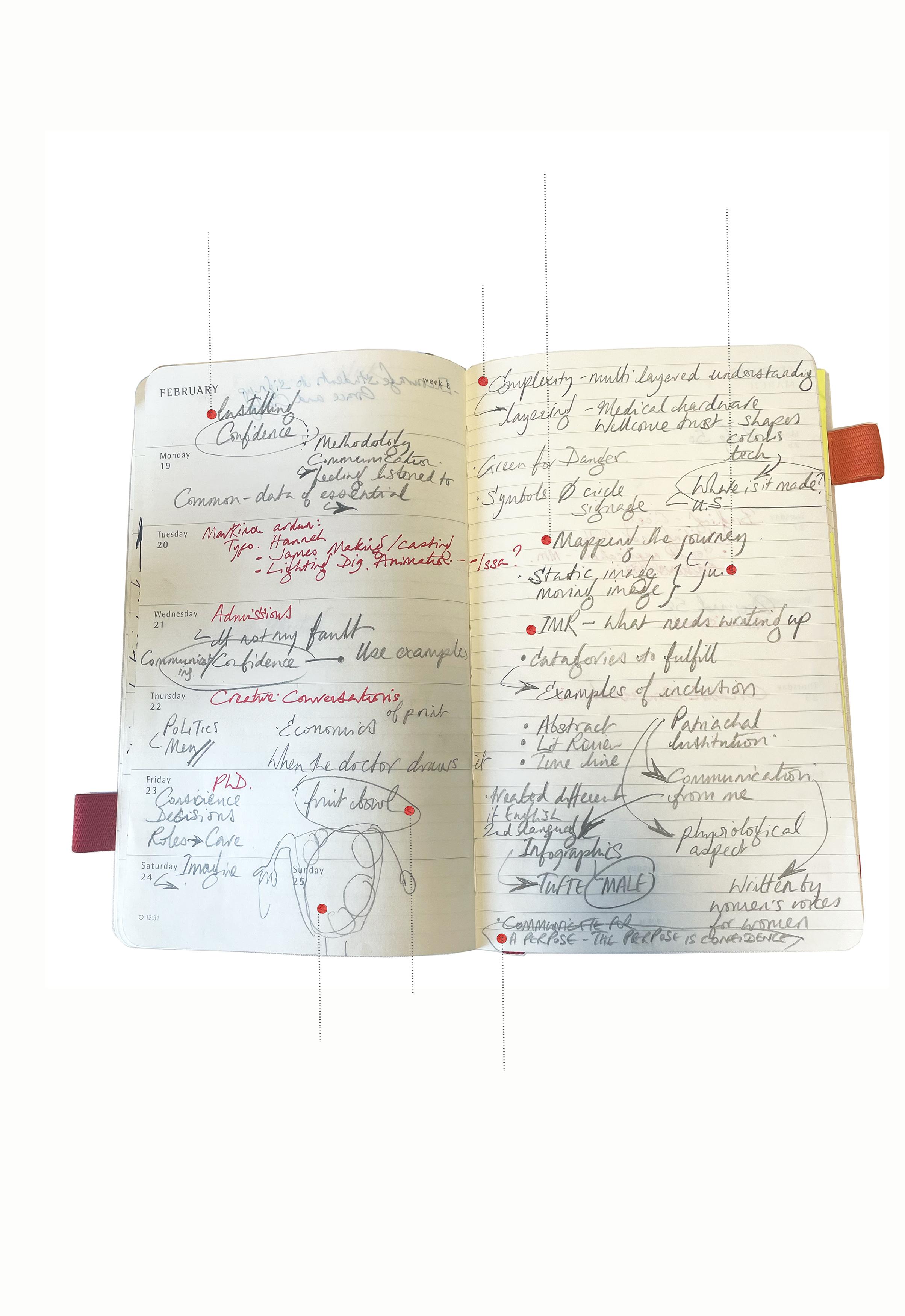
Maturity means that you’ve got a handle on life. It means that you understand, and it keeps returning to that same question, which is a great question: what do you wish you knew now? So that’s such a fundamental thing, that thing about where does confidence come from? So this whole thing about the growth and support of realistic self-confidence is one of the critical things you’re examining here. And you should articulate that in your IMR. GG/JM
Lots of us have experienced a medical professional draw a diagram for us. I’ve mentioned that when the doctor draws something or the consultant goes, “I don’t want you to Google this.” JW
You just said a brilliant line, “like when the doctor draws it.” That would be a fascinating thing to explore—the action of doctors drawing diagrams. GG
Because I had one when I was waiting to have my hysterectomy, and it’s, I think, for lots of women, everything that is described to you that’s wrong with your reproductive organs is always associated with some fruit bowl. JW
I’ve been looking at is how my teaching has fed into this and vice versa, so looking at the Re-present project, so the illustrated reader through that, and then looking at, taking examples of student work, of how, like the testing of that, and this was interesting, I did a workshop, revolved around the content of a research project, so this was a test of the methodologies I am using in my PhD and how these can apply to establishing a student’s extended research project. Looking at why we have different interests, what is it content-wise? This was a workshop with Level 6. So stories, what books, what films do you like, what stories do you enjoy? Do you like writing your own fiction, poetry, or historical figure that you want to know more about? Issues: what do you care about? What’s under explored or not known about? to explain or teach, how and who for? JW
So if you look at things like Green for Danger, the film where they mix up the oxygen, nitrogen, and so on, it’s colour-coded. Think how people also use symbols so that they would put a circle on something. So, shape the signage of ‘being able to help people navigate the medical journey.’ It’s a great phrase, ‘mapping the journey.’ It’s like you’re going on a road trip, could it be through a series of medical procedures, where they can be different types of junctions, traffic lights, and decision-making? GG
Why are female reproduction parts compared to a fruit bowl? Is it that women are supposed to be familiar with the contents of domestic shopping bag? A fruit bowl - out on the table and up for grabs?—the relationship between fruit and the human scale. It is used as a comparable form throughout your pregnancy and beyond. For example- today, your baby is the size of an apple pip, a grape, an avocado the length of a banana, then a cucumber. Finally, we move into the territory of a pineapple and a majestic watermelon. JW
I think it’s a suite of packages that your health, this is my ideal thing, that your health care provider could go, before you have this procedure, look at this, just watch this. One of the things I spoke about before is the gestational diabetes test, where women go to it, and don’t realise that having a glass of orange juice and a bowl of Cocoa Pops is a good breakfast. Then blood sugars look high, so it costs to get them back in for a blood test for gestational diabetes. Then they might not have read the leaflet that if you eat gum, it procedure doesn’t work because your stomach started doing the digestive process so that there’s lots of money wasted on parts of that in the NHS that if the communication was slightly better yeah or was more accessible. JW
I’m trying to determine whether it works better as a sequence of not moving or moving. JW
It’s worth documenting in your research because there’s a big difference between static and moving images. GG
I’m working with two hospitals that are both in South West London and is working with what are the questions that the stakeholders through the women that are accessing those services finding difficult to understand and from the other side. I am looking at the communication questions from the patients side and that of the medical care givers side.
A dovetail of both perspectives.
JW
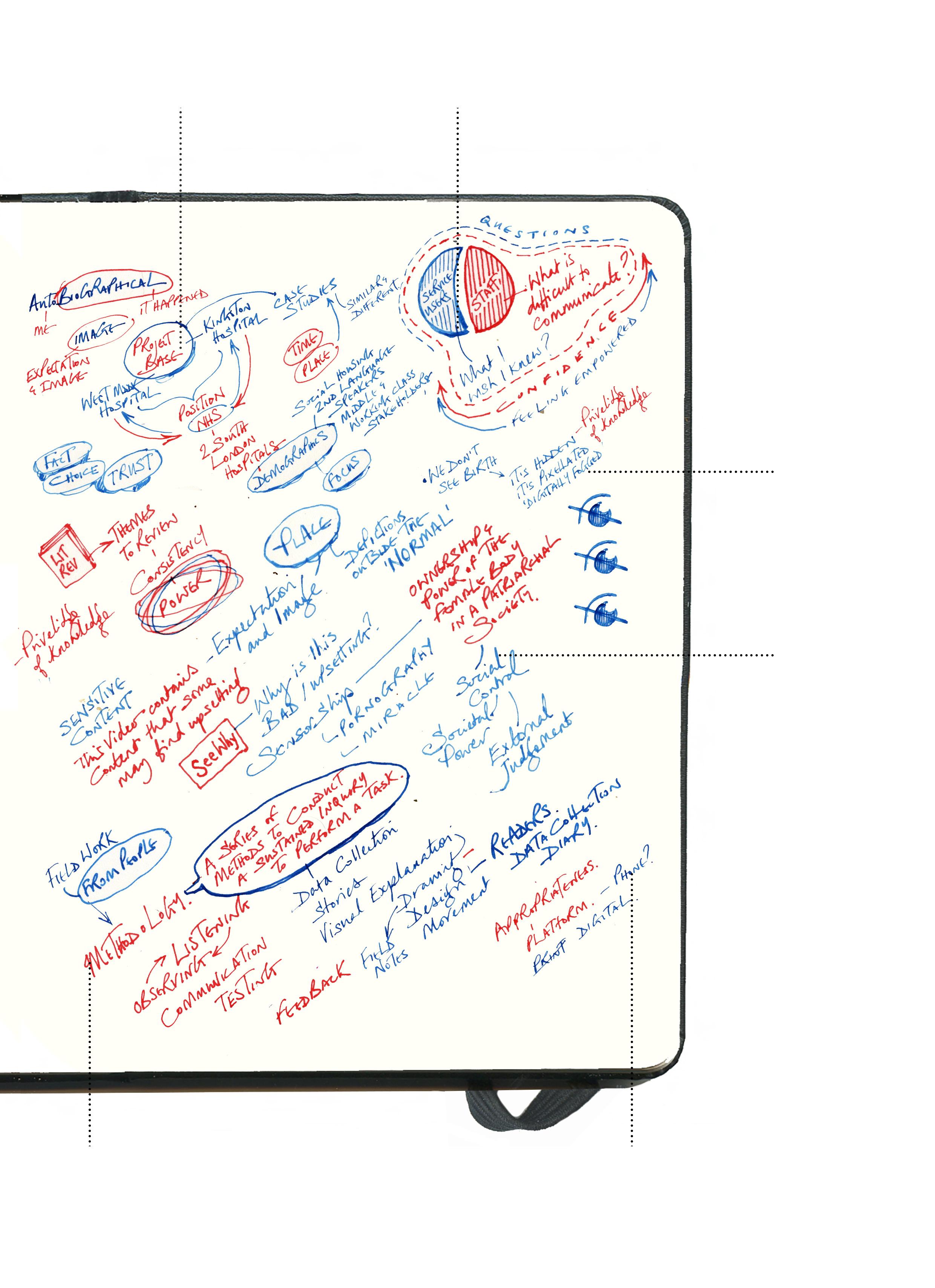
Methodology- What is your methodology?
Is it emerging from your research activity?
Why are the questions you mentioned in the two sides of the maternity suite important to the project
The questions put forward by:
*The patients/ service users
*The staff delivering the information -JW
About pregnancy, birth and post-partum.
Listening/ storytelling/ documenting drawing/ designing/ animating/ communicating/ Readers/ data gathering -GG
That’s an obvious and essential statement to include early in your IMR. However, you write up the IMR, which should almost be an introductory line because that really nails it. If both limits it, it gives your inquiry a focus with clarity. South London has comprehensive cultural and economic provisions.
GG
Notes from Meeting with Geoff Grandfield considerations for the Internal Monitoring Report
In Western culture we don’t see birth. You have cited programmes and platforms that cover up birth- using pixels or blurring. You show how it is covered by signs that deem it inappropriate to be seen. Who chooses to label that as being offensive or not appropriate? Is this patriarchal choices been made on behalf of women. These are huge double standards and a conflict of interest to the public.
GG
I find it the double standard of being able to easy access pornographic content of an object entering a woman’s genitals with one click, to being visually told that the use of a vagina as a means to birth a child as offensive a bizarre double standard. How does the sign of an eye with a cross through it effect the recipient of that information. It feels that you are being presented with information that is wrong, shameful or even dirty. What is the message we are sending out to our daughters? This is completely backwards.
JW
What role do the readers play? Are they a diary? A linear time line of information gathered? A portal for this? Where are the knowledge gaps? And what vessel or form can this take to address the original contribution to knowledge?
GG
*Neonatal ICU communication
*Mid-line abnormality formation
*Placental formation and delivery JW
The listening sessions with the pregnant women and new mothers seem like an important part of the process. To echo John’s encouragement to articulate this more formally within the account of methodology I would suggest you start by writing 1000 words on: How do these conversations impact my creative decisions when I put pen to paper?
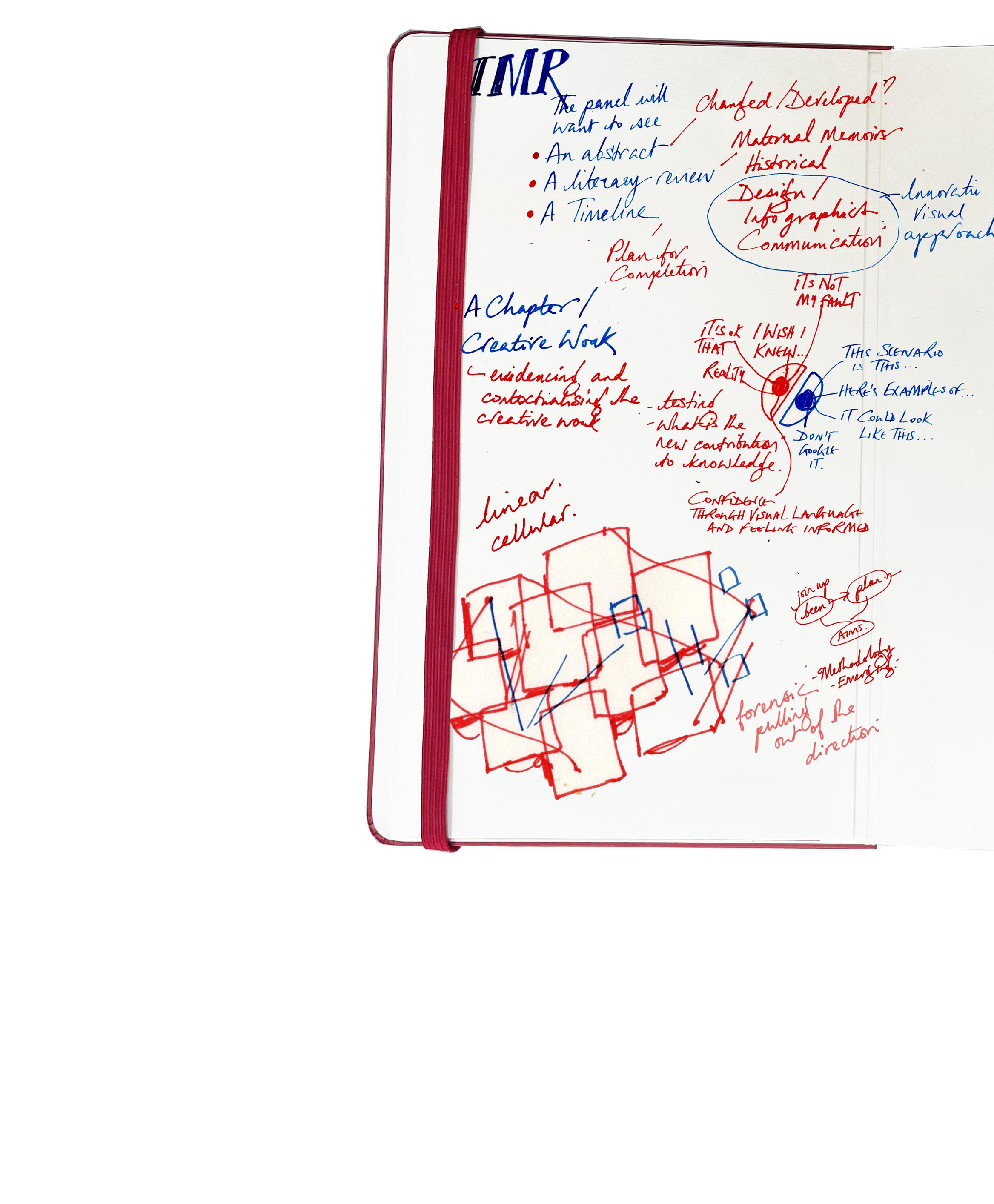
Take us on the circuitous journey though your imagination and process of conceptualising the work and articulate some specific examples of how the knowledge you’ve uncovered in these listening sessions has wormed its way into your approach to the illustration practice. John also highlighted the section of Reader 4 where you discuss with Justine your aim of combining medical accuracy with ‘softness’ which you define against the ‘hard language’ of infographics or the ‘plastic language’ of CGI. I think I can see what you mean when I look at your work in the readers, but what the complementary writing in a practice research PhD can do is articulate some of the strategies for designing this ‘softness’ and then connecting it to the method of the listening sessions
and perhaps to the conversation you had with the head of ethics at Kingston Hospital who asked you ‘Why do you want to scare people?’ How might the project achieve the opposite, and what assumptions was she making that might warrant critique?
Also, have the listening sessions and the process of communicating with these women about their fertility, pregnancy, birth, and new motherhood sent the research into different directions that you hadn’t anticipated? This writing might start to connect the sections of the praxis triangle in a new way.
A couple other thoughts:
•Your fruit bowl analysis in your tutorial notes is spot on. And is the fruit there in the apps so we have something innocuous and ‘familiar’ to catch our eye before we scroll down to the abject (and often very ‘plastic’ to borrow your term) illustrations of foetal anatomy?
•I was struck by the quote from Kitzinger you cited in your session with Alice. ‘Birth is set apart from the rest of women’s lives
and accepted as a matter of specialist knowledge.’ I see clear links between this cultural ringfencing of birth and your intention to create illustrations with medical accuracy, softness, and a ‘sense of design’ that make the process of learning about •birth a more pleasurable aesthetic and therefore accessible experience… not just science homework.
•I am speaking at the Birth Rites Summer School in July. It seems to be a four-day ordeal(!), but if you fancy a trip to Kent you could apply for funding to attend as it might be good networking and relevant to your research. I’m excited to see the collection: ‘Birth Rites is a collection of contemporary art on childbirth. The first of it’s kind in the world. It was housed in the Mary Seacole Building in the Midwifery School at the University of Salford from 2009-2017 and King’s College, London from 2017 - 2021, across four buildings on Guy’s Campus. The collection is currently housed at the University of Kent and comprises photography, sculpture, painting, artist books, print, wallpaper, drawing, new media and film.’
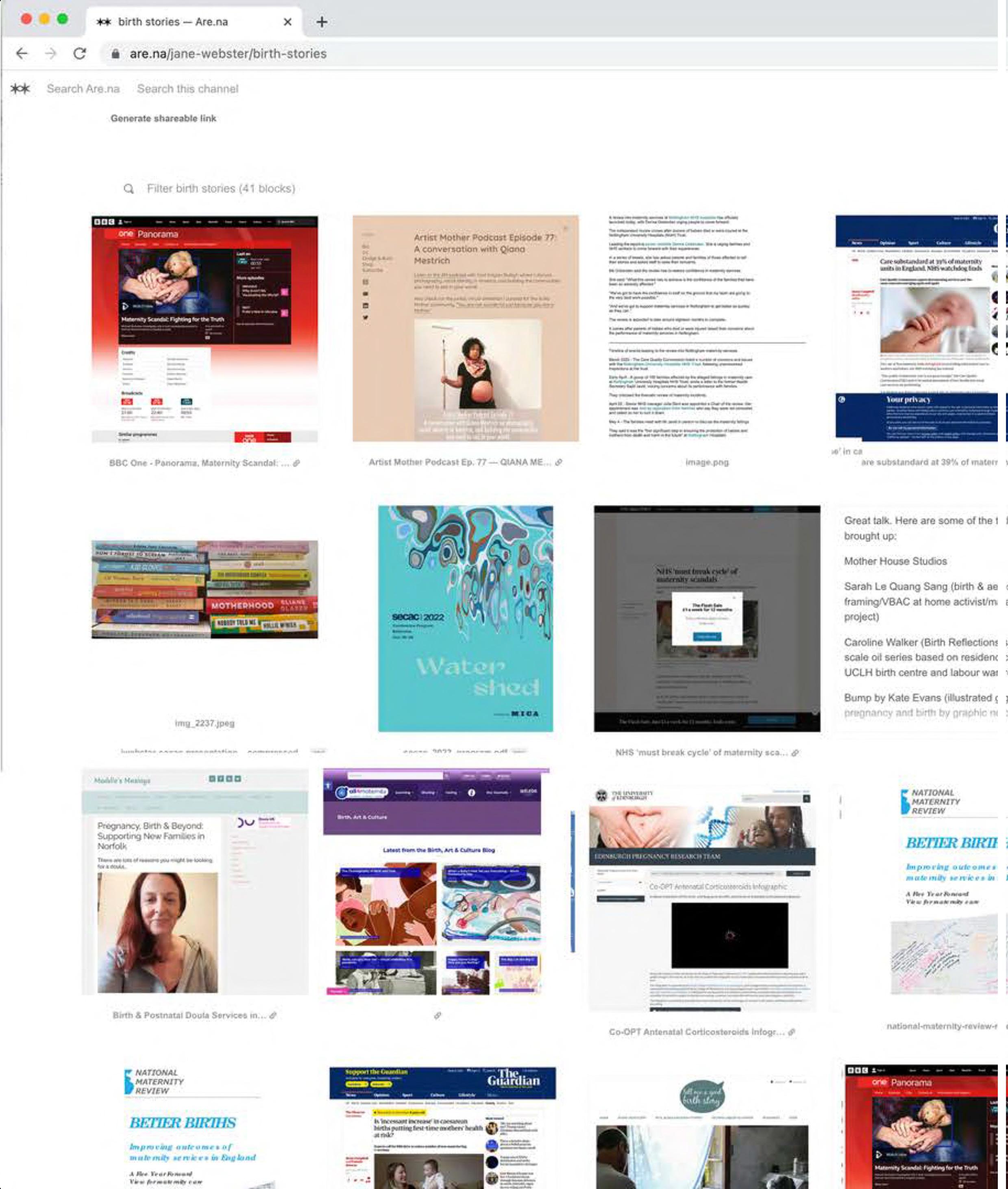
Screen grab of JW/BS **are.na page:
Are.na is:
An online software for saving and organizing the content that is important to you/ a tool kit for assembling new worlds from the scraps of the old.
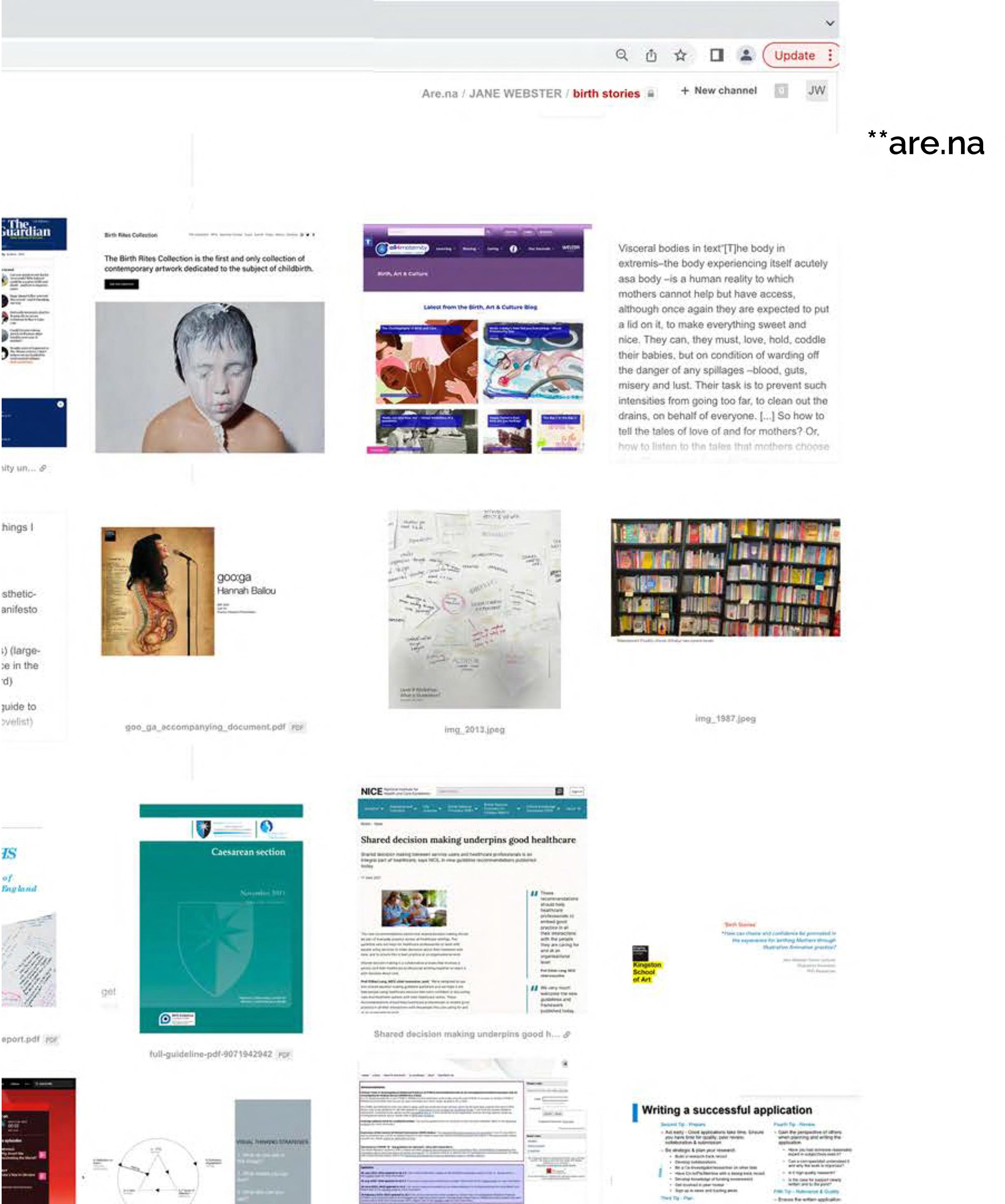
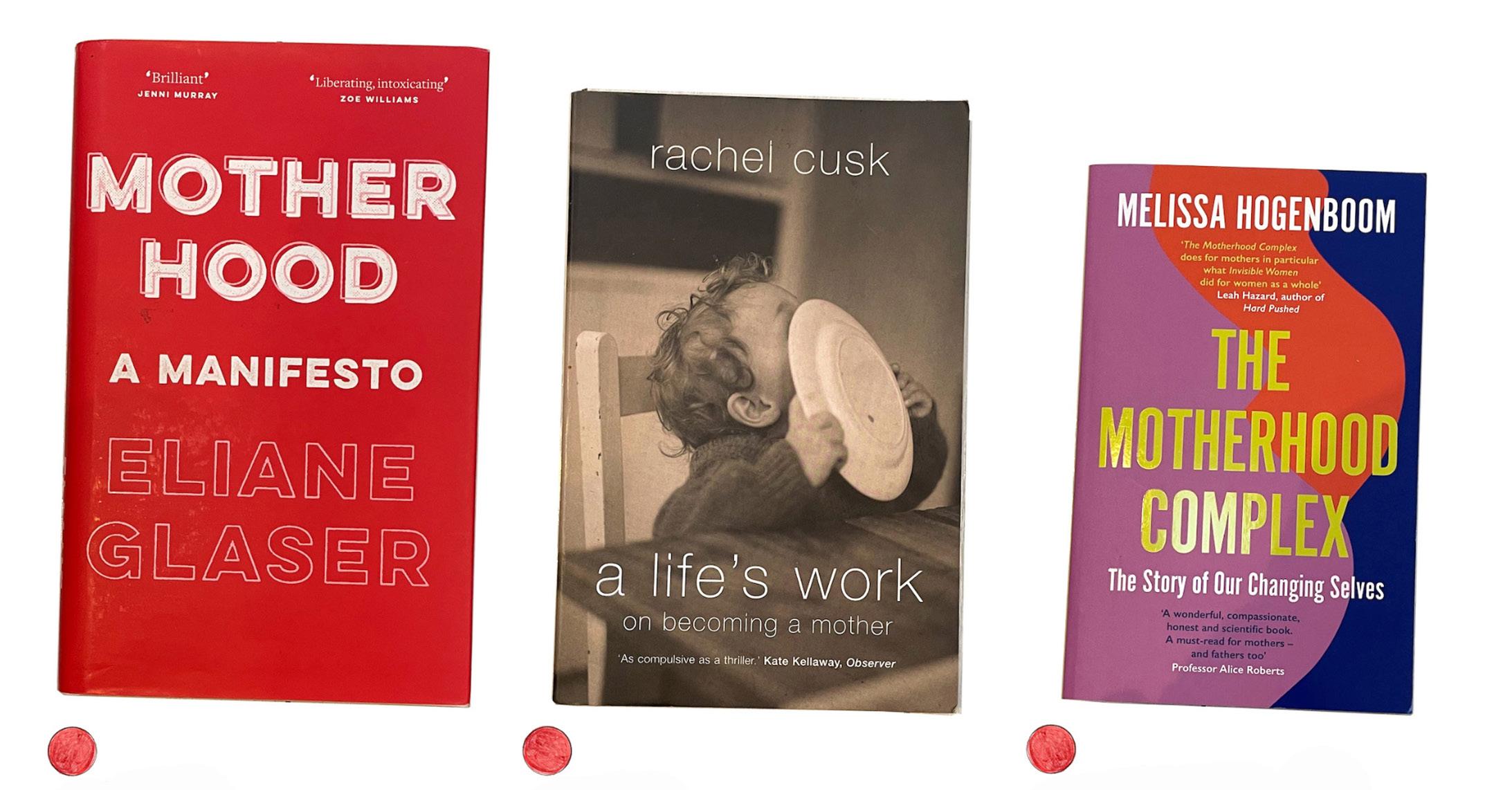
MOTHERHOOD
A Manifesto
Elaine Glaser 2021
ISBN 978-0-008-31188-9
Harper Collins
Eliane Glaser writes a book that explores the guilt, drudgery and the responsibility of child rearing. ‘Its the most important job in the world.’ According to anyone’s opinion in a public park. So why isn’t it paid? Where is the public recognition? Glaser explores these questions through her rigorous book, including the many facets of giving birth and the enshrined birth plan and the notion of what agency women have in childbirth. The effects of not being listened to and the con- sequences that has on different women of different demographics. Her book analysis the historic and contemporary injustices of motherhood. The ‘notes on references’ section provides an excellent reading list of historical articles, memoirs and experience. She cites every book and magazine article that has gone into the research of her book. Pointing out the range of view points that contradict very aspect of motherhood. How we are ‘Dammed if we do, and dammed if we don’t. She also points out numerous resources that will benefit the research journey I am on, from birth trauma to tocophobia, geriatric motherhood, pay issues, how the NCT bench march is completely unachievable and not a credible way to live. We are bullied and guilt tripped, then asked to reign in our ambitions and get on with it without the right support. 8.
A Life’s Work
On becoming a Mother
Rachel Cusk 2002
ISBN 1-84115-487-3
4th Estate
I read Cusk’s book whilst pregnant in 2005. At the time I was appalled by her acerbic honesty regarding the tedium and relent- less of early motherhood. It can’t be that bad? She’s probably a terrible person? This was the way I nervously navigated the pages of grief for her freedom lost. The boredom of the long days, but short years that spill out in a new monotony of existing. I have since reread her book n beginning this PhD. It is so honest and poignant. It demonstrates all that is stacked up against women who take time away from a career that they have established, to spend time in this huge state of flux, contradiction and judgement by any and everyone who is willing to point out the failings that are there bubbling below the surface of any new mother. You are not allowed to say-‘God this is dull.’ The nearest I have seen this is presented as a car sticker quoting, ‘Baby I’m Bored.’ A humorous take on the ‘Baby on Board,’ boastful declaration of ones ability to procreate. Glaser cites Cusk’s memoir as a seminal text, in it’s lack of apology and space for subsequent authors to speak candidly and honestly about what goes on behind the ‘high walls’ of pregnancy, birth and motherhood.
The Motherhood Complex
The Story of Our Changing Selves
Melissa Hogenboom 2021
ISBN 978-0-349-42657-0
Little Brown
This is cited a the ‘motherhood version’ of Invisible women, the author is a BBC award winning science journalist this book explores the stats, and how they are stacked against us. She celebrates the success and the strength of women. The writing style, whilst scientific in its leaning, is upbeat and feels empowering. She focuses on identity and how society and its gendered perception of motherhood impacts so dramatically on our sense of self. The vulnerability of women during labour and birth. Mental health, delayed PTSD, and PND sensitively through women’s stories or case studies. The appalling maternity leave on offer in the UK in comparison to our European counterparts. We are screwed and then “screwed again.” Pumping milk at work in a sickroom isn’t ideal- most mothers will agree to that fact. Hogenboom completes her excellent study of the maternal land- scape with an insightful chapter ‘Different Mothers’ how culture shapes up. It looks at the way we are bringing up babies and how our influences and behaviours shape babies and children. In a similar way as Elaine Glaser’s book ‘Motherhood , A Manifesto.’ This book completes with an informative bibliography and acknowledgements for further reading.
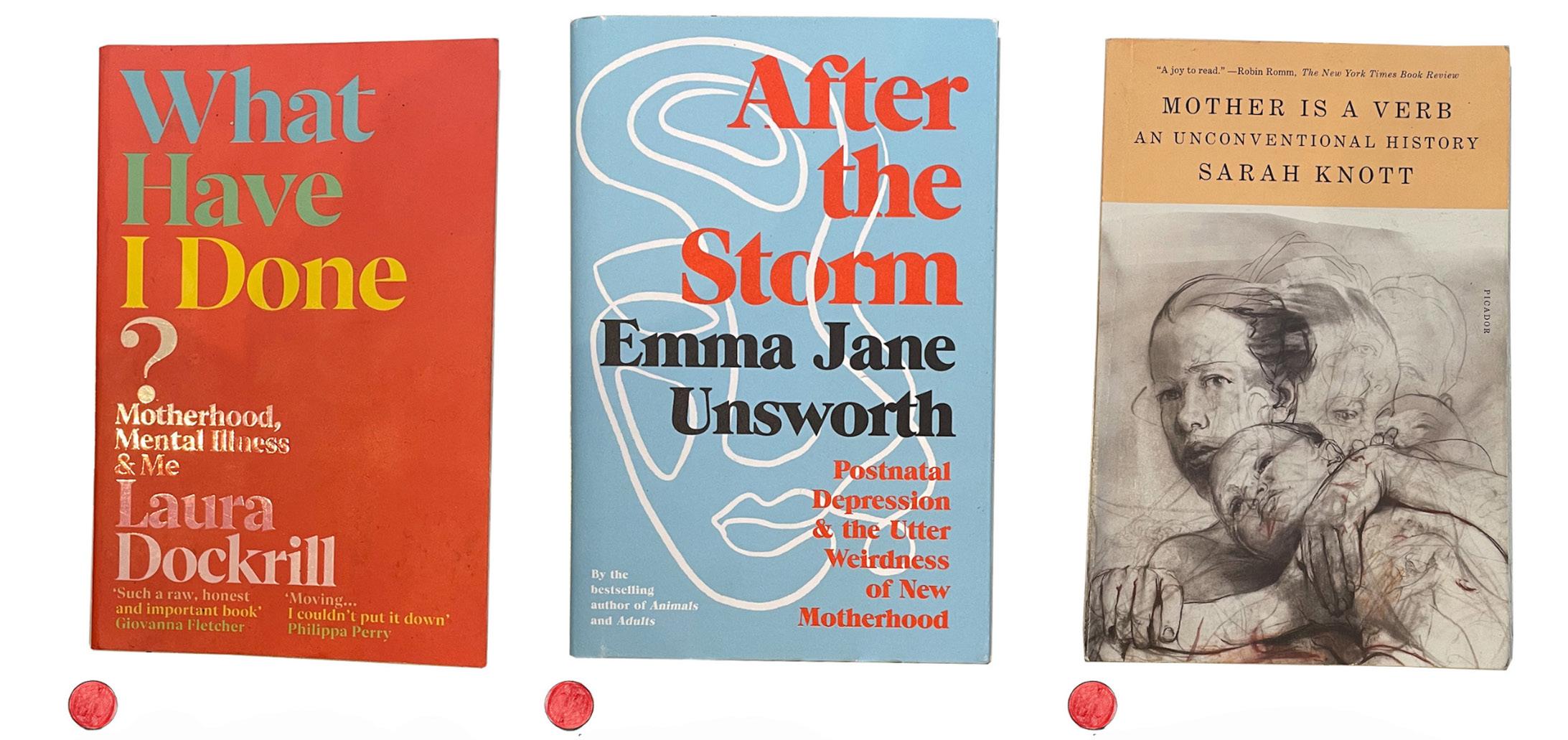
What Have I Done?
Motherhood, Mental Illness and Me
Laura Dockrill 2020
ISBN 978-1-529-11254-2
VINTAGE
Dockrill’s open novel takes us into the space where exhaustion, anxiety and being overwhelmed escalates and tips over into a post partum psychosis. She uses her book as a platform to articulate about the stigma and to break the silence around post partum mental health. In a society where motherhood is often presented in a fetishised way from the outside. She spends two terrifying and traumatic weeks in a psychiatric ward, away from her family. This book tells the truth around this illness, the shock and the shame of the experience of when motherhood does not follow its expected path. Dockrill’s book in its darkness remains warm and hopeful. She provides a comprehensive guide to help other mothers and an A-Z of self care which is relevant to everyone. She initially did not want to publicise her illness. She had not suffered mental health issues before she gave birth. Her book is due to be adapted into a TV drama. Post-partum psychosis affects around 1 in 1000 new mothers, a surprisingly high number for a condition that is not really on any new mother’s radar.- it’s certainly not mentioned in any NCT class I attended. This memoir is another example of the untold and misinformation that sits within our culture of over realistic standards for new mothers.
After the Storm Postnatal Depression & the Utter Weirdness of New Motherhood
Emma Jane Unsworth 2021
ISBN 978-1-788-16654-6
Wellcome Collection
Unsworth names her unflinchingly raw book as part memoir, part resource. This is exactly what it is. She describes her journey post giving birth in 2016, with wry wit and honesty. Exploring the dark experience of feeling engulfed and overwhelmed with a new baby. She bravely and quite shockingly admits giving the baby a ‘sharp shove’ in a moment of sheer desperation when her partner has gone away for three nights, and she is stuck with the baby alone. She looks at the patronising way motherhood and alcohol consumption are perceived in going hand in hand. Its 5pm, so Mummy needs a glass of Chardonnay. Why in our society are we not supported as new mothers? She is particularly attuned to looking at how motherhood is seen as a threat to hers and other’s creativity. A new father is not made to feel that her has to choose between his artist identity and being a ‘good’ parent. This book looks candidly at how we are expected to behave women who have given birth- especially as creative people. Whilst being aware that as a white woman, she is of privilege, she asks why are we so judged if we are a bit messy? The word ‘weirdness’ certainly resonates with me.
MOTHER IS A VERB
An unconventional history
Sarah Knott 2019 ISBN 978-1-250-25129-9
This was my summer sanctuary reading as my 16 year old awaiting his GCSE results and challenged our first post pandemic family holiday. Swinging from the relief of not being a new ill equipped parent, I realised we are always that as the form of motherhood morphs into each new form as a lava lamp does. A similar shape forms, never repeating itself. Knott’s book amasses the range and perhaps more importantly the missing parts of the narratives around the recording of the history of pregnancy, birth and the postpartum experience. The historical elements are interwoven with Knott’s new experiences of motherhood. The guilt of writing the book and not being with her newest child is punctuated through her book. Her ‘Giving Birth’ chapter examines her experience at the same time as examining analogies that make sense of the experience. “Early contractions are like small waves at a beach. The pain is like a red hot poker.” reports a twentieth century milliner. “Like a fine electric needle outlining one’s pelvis.” “Labour is being on a rack, as if each limb were divided from the other.” (Seventieth century Puritan gentlewoman.) “Pushes move like wind preceding an avalanche.” “It was a night that would kill a horse.” (a Yorkshire womanhorses were the only form of transport.) It seems that everyone is in agreement that when the head crowns, “It’s a ring of fire.
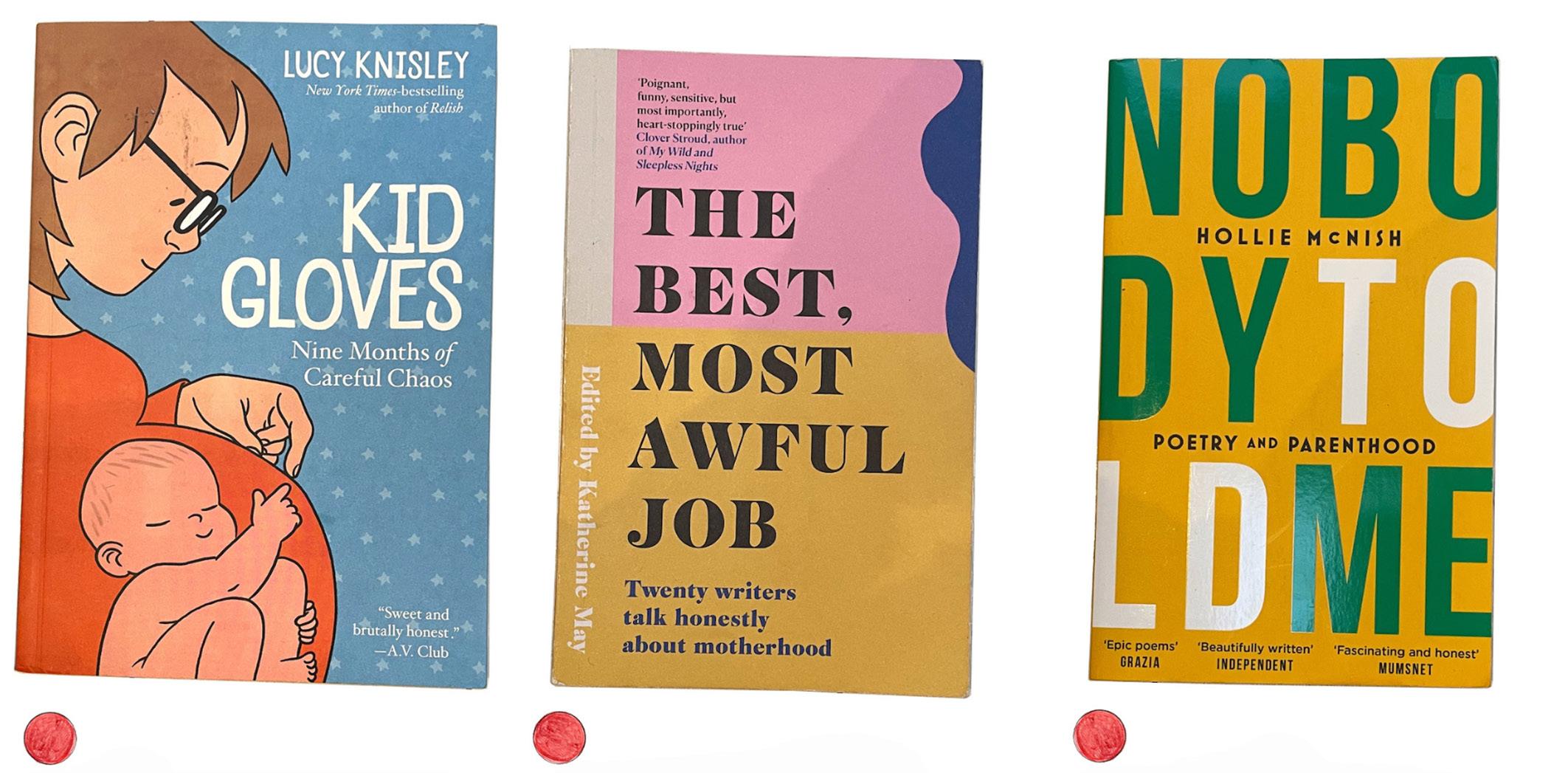
The best, most awful job
Twenty writers talk honestly about motherhood
Edited by Katherine May 2020
ISBN 978-1-78396-594-6
Elliott & Thompson
Knisley’s third book circumnavigates the idea of pregnancy from all angles. As a teenager - it is too early to be pregnant and go to an array of responsibilities to avoid being so. Suddenly, there is a rush when you meet the right person to parent with or when your age starts to catch you out, and your fertility becomes more questionable. She documents her journey of miscarriage and prays to the baby to ‘stay, stay, stay,’ inside. Knisley’s illustrative language is beautiful in her line, colour palette, and use of her memoir’s visual and narrative framing. Everyone has a stake in pregnancy in the advice offered by research from books and online medical professionals looking after you both. To the lady at the bus stop to comment on your size and ask if you are carrying twins? She has a difficult birth after an arduous and precarious pregnancy. Her birth bears no resemblance to the planned natural experience, and she does not meet her baby for two days post-delivery. Clever visual techniques of draining colour and sections written from her partners’ perspectives aid this brilliant and honest book. The memoir is peppered with historical and feminist information throughout the book. I will analyse Kid Gloves and BUMP as a submission to Graphic Medicine 2024.
This book took precisely the journey from our home to meet my family in Norway after later start to join them with the in-laws. I can do a week, but not two in the wider family environment. Twenty writers create a range of view points from the lens of their experiences. ‘What your Mother didn’t tell you,’ by Leah Hazard from a midwifery perspective follows the introduction. “Bilateral paraurethal grazes: three words that make every midwife wince, cross her legs and tut with sympathy. We know the broken glass pain. Pour a jug of water when you wee. Keep your pads in the freezer. We are able to probe gently with gloved, searching fingers, pushing back petals of flesh to find the damage done- damage your mother never told you about, or at least not in these terms. She might have said, ‘I tore,’ or ‘I was cut;’ she might h ave told you it was ’never the same down there.’ She might in all likeliness said nothing.” This book is diversely and wincingly inclusive. Poignant, funny, including McNish’s contribution of being told she was able to accommodate a penis six weeks postpartum. “What about all the things I actually want to do?” This is a fantastic book offering a range of voices and expertise in the choices and approaches we have as people bringing up children.
NOBODY TOLD ME
Poetry and Parenthood
Hollie McNish 2017 ISBN 978-0-349-13451-2 Blackfriars Books
McNish publishes her thoughts and poems in a diary form. She starts at Kings Cross in the toilets on her way to Glastonbury one month pregnant. The book follows her child to her third birthday. The baby arrives on page 77. Nine months, 2 weeks. 24 hours of labour, 7 birthing positions, 2 parents, 1 baby- 4 hours old 10am. “I think I have joined a secret club, why did nobody tell me this before?
The news of the baby’s safe delivery is received with the female honesty of polite Gran, “Oh Hollie I’m so glad you’re ok Fucking horrendous, isn’t it?” Auntie: “Shit- ting a watermelon?” Mum, a nurse of 30 years, “bursts out crying and cannot speak for heavy sobs and apologies.” When McNish writes about her inability to sleep when the baby sleeps her book made me cry. I’m thinking about how I also lied to say I had slept when I couldn’t. Remembering the lonely nights of feeling like you are the only person awake in the whole world, looking at your sleeping baby and partner, and feeling the urge to ‘want to smash his face in.’ This statement highlights the isolation and loneliness that can be felt in the early stages of parenthood. How can everyone else be getting this spot onwhereas I feel so on my own. Will it ever get light again, and when it does it’s just another day of the same thing.
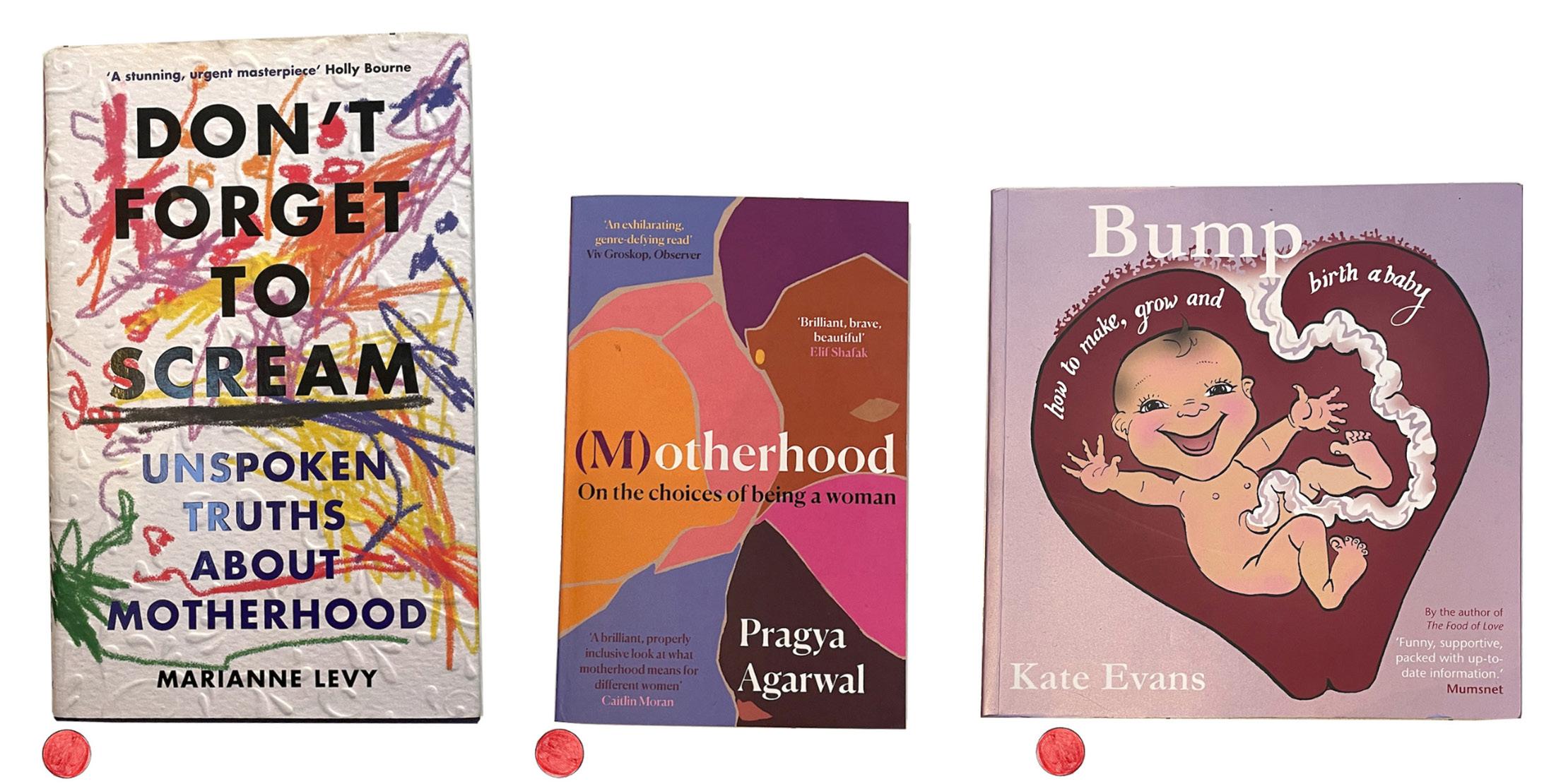
Don’t Forget To Scream
Unspoken truths about Motherhood
Marianne Levy 2022 ISBN 978-1-4746-2365-0
PHOENIX
Levy’s career has taken her through the journey of comedy and writing children’s books. She felt compelled to write this book as she describes as being ‘lovingly angry.’ Her book explores the spaces where we are shut down when we talk about birth: people walk off if you describe the reality of a birth narrative. As new parents, we censor ourselves to the ears of others, whether they be happy grandparents or even health visitors when communicating that everything is ‘fine.’ The first line of her telling book -’My story us unremarkable. In 2014, I had a baby, my daughter. In 2018, I had a son. What followed was astonishing to me.’ Her book is told in five parts. She is witty and wry in her observations of the visceral and exhaustive nature new parenting holds to the ridiculous of the dumbed down naming of baby and toddler products and the ‘activities’ and classes middle-class parenting encourages, from ‘baby massage/ signing/ swimming/ songs and stories- the list is extensive. The tat targeted at you as being essential for you being the best version of being ‘Mummy.’ You become a travelling camp site ready for any eventuality. I would have been reassured that I was not the only one feeling so disassociated and unable to access this feeling from reading these books named ‘matrescence.’
(M)otherhood
On the coices of being a woman
Praya Agarwal 2021
ISBN 978-1-83885-321-1
Canongate Press
Agarwal’s timely book explores societal obsession with women’s bodies and their choices whether a woman chooses not or too become a mother. She is an angry woman- quite rightly so with the patriarchy over women’s bodies. Young, newly married, she gives birth to a daughter that she is forced to leave in India. Following her graduation and wanting to make a lifebfor herself that doesn’t replicate her mother’s, she moves to England to complete her PhD and becomes pregnant again, aborts the baby, subsequently she is deeply traumatised by this experience and her and her husband try to conceive. They try IVF, they use a surrogate. Her twin daughters are born in Delhi 8 weeks early. Her book is a mash up of being a memoir, it is interspersed with facts and stats about women’s and societal expectations of motherhood, it could be read as a manifesto for women to reclaim their bodies from the intervention of men. It explores women’s identity if they are not mothers. The obsession of the body clock. She has a very complex journey to her becoming a mother, which has in turn provided her with the content of this very moving and honest book. The description that ‘this is a book about motherhood. This is a book about bodies. This is a book about choices.’ We are in a place of privilege if we have these as choices
How to make, grow and birth a baby
Kate Evans 2014
ISBN 978-1-90843-435-7
Myriad Editions
This book starts with a range of very positive testimonials from midwives on how important, beautiful, brilliant, fun, accessible and important book. All of which I agree, as the content is excellent and it is probably the most aligned book in spirit of the communication of the journey into pregnancy, birth and motherhood. She candidly looks at conception, loss of a baby, understanding your own fertile window and creating a new life. I find the illustrative language and the design of this book problematic. The book straddles an odd feel of graphic novel, text book from school. Illustrations are all mono - which presumably is due to keeping print costs lower are digital in the tonal colouring. Straddling a cartoony ‘infantilised’ tone. Big heads, small bodies. My main issue they feel irritatingly inconsistent. Or the imagery feels as if it was rushed in its production. This lack of continuity is distracting from the important content and the book’s intention. This may be over critical? as the chapters and range of information is so well informed and covers such a breath of ground. You can’t take 25 years of looking at creative work out of reflection on such a well meaning publication. I will be presenting a comparison with ‘Kid Gloves’ as memoirs in Graphic Medicine conference to be held in Ireland- July 2024.
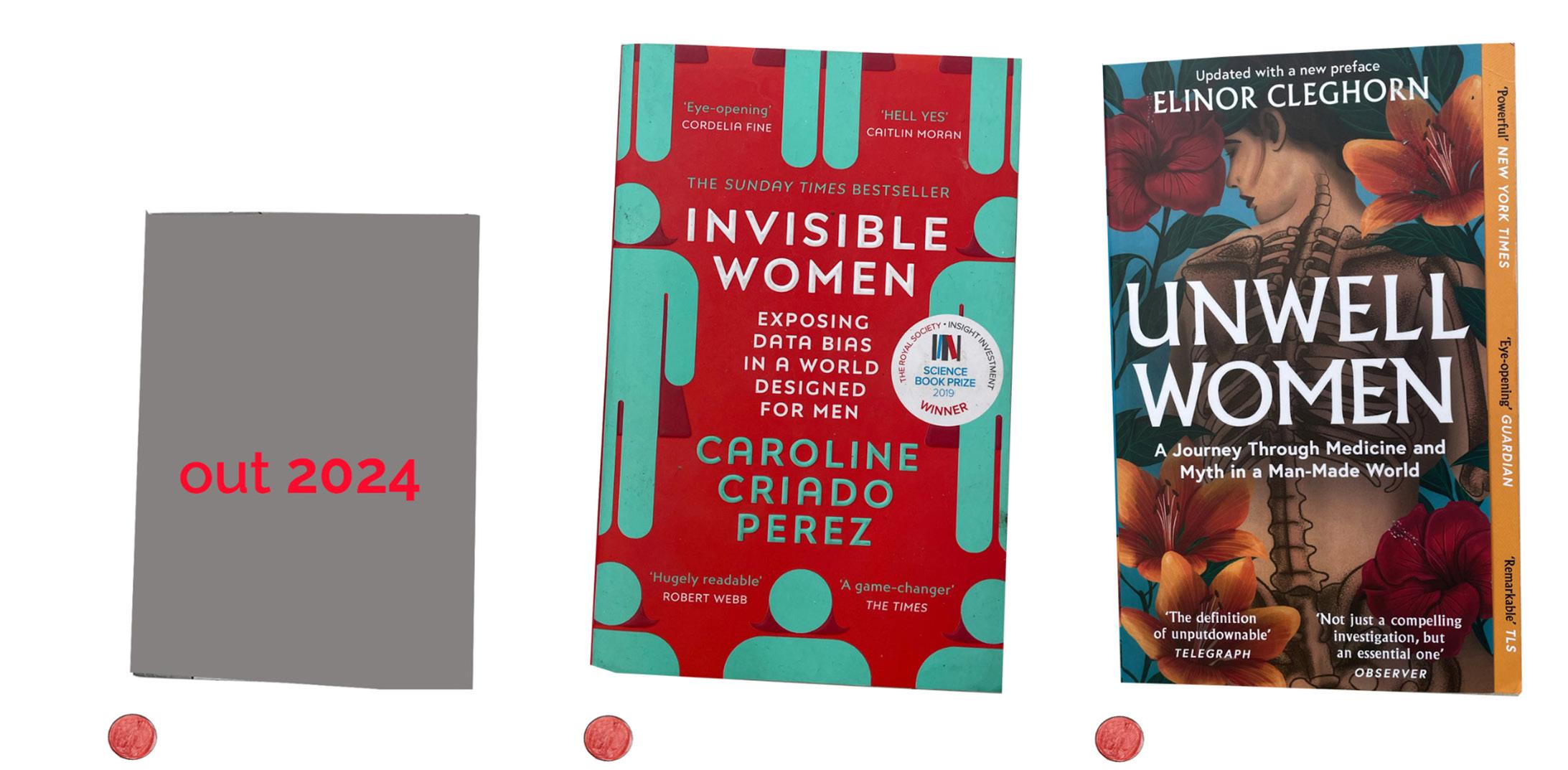
Invisible Women
Exposing Data Bias in a World Designed for Men
Caroline Criado Perez 2019
ISBN 978-1-78474-172-3
Vintage Press
Dr Andrzej Harris and Emma Szewczak
This book is presented and described as ‘a powerful and urgent exploration of how institutionalised misogyny through research and medicine has “betrayed half the world’s population”
As women we live in a world where many of the things we interact with and put into our bodies are designed fir men. This book is terrifying in that still medicalisation testing is ‘advised’ to be tested on half of the world’s population, mind bogglingly it remains not a be a legal requirement. How can this be ok, when you may weigh half as much as another male patient? Our phones are too big, seatbelts are designed for us to die 47% higher in a serious road accident. Drugs are tested on people potentially twice your weight and size. Data bias is the cause for this as it largely excludes women from studies. Surely, it’s time for this to change. This book highlights the system of discrimination faces by and the effect this has on their daily lives. Author Caroline Criado Perez is an award winning activist and campaigner for women’s rights. This book will make you very angry and disappointed in the ingrained societal misogyny that exists surprisingly in the Western developed world and how it affects us daily. It is presented as case studies. Illustrating how we work count- less hours for free, are undervalued and in some cases in danger. On top of that we have to birth babies with heads too big for our pelvis’.
Unwell Women
A Journey Through Medicine and Myth in a Man
Made World Elinor Leghorn 2021 ISBN 978-1-47461-685-0 W&N
This book is not dissimilar to Invisible Women, in highlighting the truth behind women being ignored and abused. In this case by the misogyny in Western medicine. Based in America and the U.K, Cleghorn’s research and book goes back 2000 years of history from Hippocrates to 21st Century medicine. The book chron- icles her journey of being diagnosed with Lupus developed from her second pregnancy and taking 10 years to gain that diagnosis, gave her the momentum to research Lupus in the 19th Century. The book has eighteen chapters and three parts. Women’s pain and mistreat- ment over centuries is featured in stories of individuals experiences. Women being forced to have syphillis tests before marriage, enduring botched abortions and being held to the economics and the pain of menstruation. This book is fascinating and enraging. Women being controlled and crazed by wondering wombs, lack of sexual freedom and the dismissal of pain as being hysterical, unexplained and psychogenic. After waiting 9 years for a hysterectomy and being fobbed off, this book comes as no surprise. I think many women will see themselves the pages.
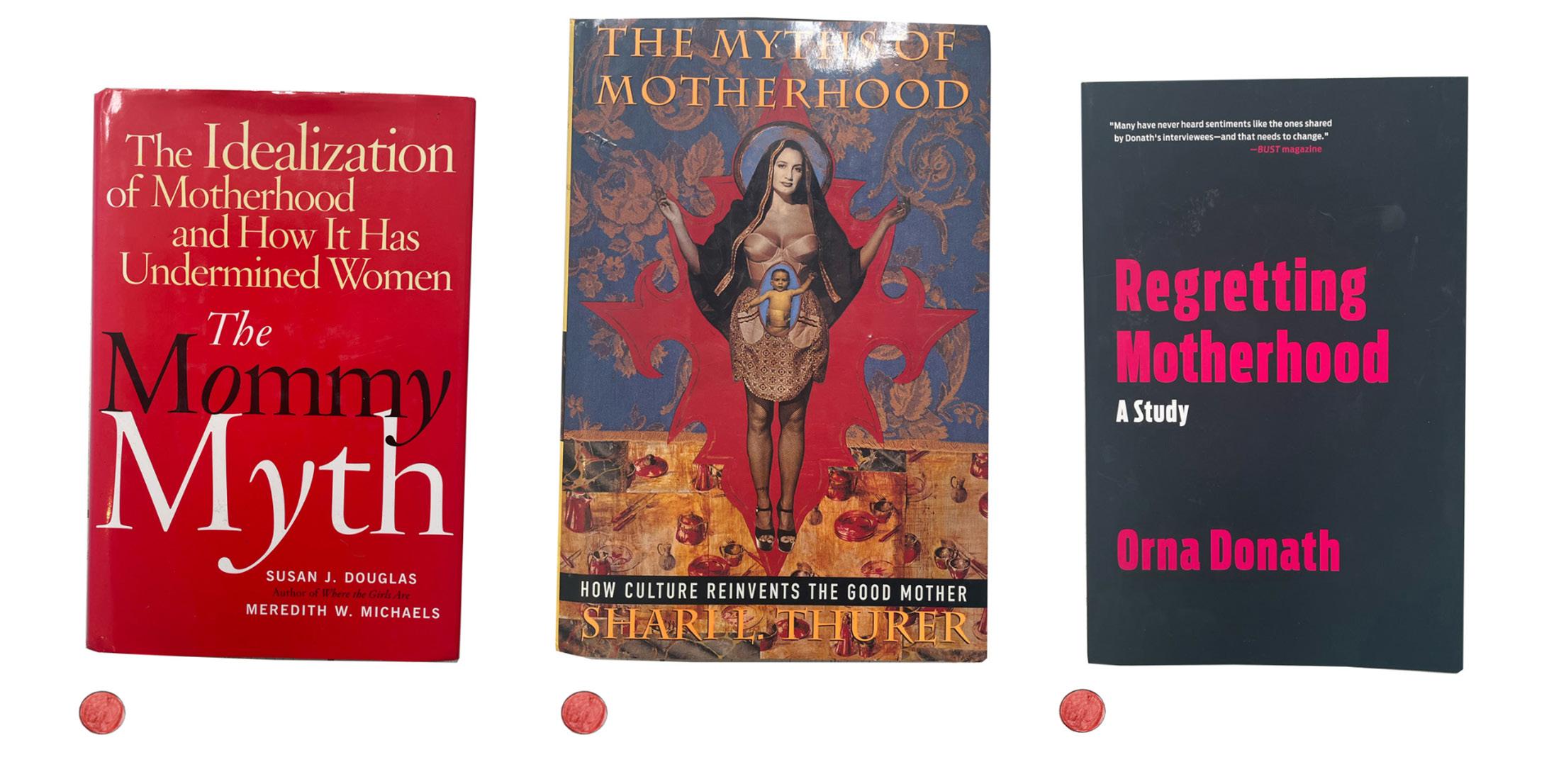
The Mommy Myth-
The Idealisation of Motherhood and How It Has Undermined Women
Susan J. Douglas & Meredith W. Michaels 2004
ISBN 0-7432-5999-8
Free Press
Susan J.Douglas wrote this book in 2004, and it is still spot on, or in fact, feels more relevant now than perhaps 19 years ago. I wish I knew of her writing when I became a mother. Her acerbic wit and observation of the conflicting messages we are all fed are all in the chapters. If you don’t want to be a mum, you’re bad; if you don’t enjoy every single second with your kids and yearn for more, you’re bad; if you don’t find each snot-stained and paint-smeared second of motherhood the most richly rewarding experience of your entire life, you’re worse. This book exposes the myth and tells us all to be real people, not desperate carbon copies of fetishis-ed ‘celeb’ perceptions. This book is written from an American perspective and from reviews it seems that this book is well received by women wishing to navigate the pros and cons in child-free living. This book is geared around exploring how society’s ideas and fickle nature have created problems for Mothers, but also how a space can be reclaimed and a reminder that your life and that of your dependants are yours, and you have advocacy in he way you choose to navigate the landscape. She fantastic referencing for her book from pre- 2004.
The Myths Of Motherhood
How Culture Reinvents the Good Mother
Shari L. Thurer 1994
ISBN 0-395-58415-9
Houghton Mifflin
This book is dedicated to all good Mothers and her daughter, beginning with the quote from The Tempest- ‘Good wombs have bourne bad sons.’ I am half way through this book. It is rich with content fro a psychologist’s point of view. The introduction navigates how as mothers we feel our behaviour or feelings damage our children, how it’s difficult to take pride in our competence. Judgement, anxiety, frustration, neurosis - I am only only the third page of the introduction! This book is dense and complex. The chapters include mothering- The Old Fashioned Way, History begins and ends, The sublime and the ridiculous- The classical Mother. Sa- cred and profane callings: The Medieval Mother, Father knows best: Early modern Mom. The Exaltation of Mother: 18th & 19th Century Mother. The final chapter named Fall from Grace: 20th Century Mother. This will be my summer reading as it appears to be such a key text. Again, a great resource of further reading pre- 1990’s. I’ll be back with this book and the benefits and relevance of its content.
Regretting Motherhood A Study
Orna
Donath 2017
ISBN 978-1-62317-137-7
North Atlantic Books
She not only said this out loud, but wrote a book on it and it was published and it’s available to read. In a society where motherhood is fetishised and glam- ourised through media, social media and advertising I found this fascinating. The book published in America and written by an Israeli- Jewish writer. The book derives from a sociological study for her doctorate. The book is made up of unflinching interviews of women’s experiences of politics of regret, reproduction and motherhood. Regretting Motherhood by no the children and the conflicting emotions that brings. The fear of then children finding out. Feeling obligated to care, fantasies of vanishing and living with an illicit emotion. How these women have reached out to other Mothers to find a space and community to talk about these complex emotions. How women have found numerous mechanisms to cope with the feelings including humour and glibness. The endnotes of further reading for the project are excellent: Including
‘ Qualitative Interviewing’ in Handbook of Interview Research: Context and Methods ads. J. F. Gubrium & J. A. Holstein. Susan Maushart, The Mask of Motherhood: How Becoming a Mother Changes Everythingand Why We Pretend It Doesn’t. (New York: Penguin Books 1999.
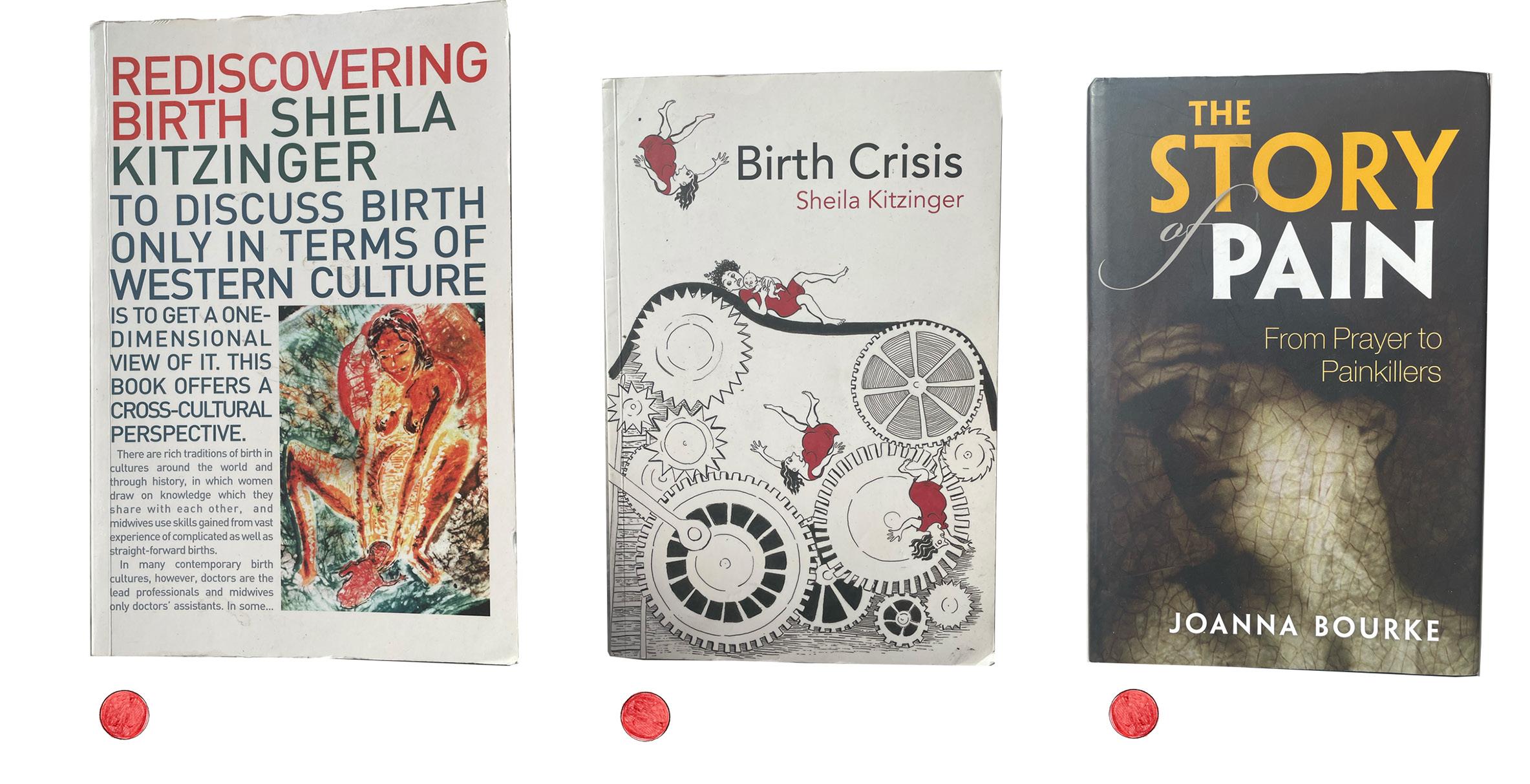
Rediscovering Birth
To discuss birth only in terms of western culture is to get a one dimensional view of it.
Shelia Kitzinger 2000
ISBN 978-1-905177-38-7
Little Brown
This book explores how much we can learn from other cultures and histories about how we support birthing women through the journey of pregnancy. Traditionally, in some cultures, women give birth in a woman’s space, rarely in a clinical environment. They are encouraged to move around, not to be strapped down with a CTG reading in a passive position. Sheila Kitzinger is a well-known feminist, childbirth advocate, campaigner and author. An MBE, she was passionate about women being provided a birth that they choose. Her books advocate that mothers not at high risk should be offered a home birth. The chapters of this book cover the feelings that a new pregnancy generates within the family and community. The policing of women’s bodies through behaviour, diet, alcohol consumption and exercise. The origins of women supporting other women through the birthing process. The importance of midwife-led care that is not rushed. The importance of sonography and scanning to build a relationship with a baby in utero and how culturally early scans are not wholly available due to choices of favoured sex and lineage of the baby. This book is eye-opening and has led me to read another six of her texts. My previous understanding of Kitzinger’s work was misplaced in thinking she was a hardcore natural drug-free birth warrior.
Shelia Kitzinger 2006
ISBN 0-415-37266-6
ROUTLEDGE
This book was published in the same year as my first experience of giving birth; this book examines thousands of hours of women’s experiences and testaments. This book focuses on the range of their experiences and choices and her depth of understanding of the maternity system. It is a distressing read, with accounts of women expecting to ‘pull themselves together’ after a traumatic experience. Her research at the time of publication, ‘One in Twenty new mothers is diagnosed with traumatic stress after childbirth.’* The chapters of the book extensively cover how hospitals are time-based machines, where if your body hasn’t complied with the norm - interventions to speed things up are often presented to the mother at a time of fear, discomfort and pain. Kitzinger explores how birth is turned into an ordeal through women being treated like products moving through a factory production line. She uses many harrowing quotes from women’s lived experiences of trauma and feeling ignored and labelled neurotic women, feeling that they were not informed of questions and decisions being made for them. Episiotomy’s healing is slower and more damaging to a woman than managed perineum tearing. Many references and quotes within this book are and will be essential to my developing research and thesis.
*j.Czarnocka and P. Slade, ‘Prevalence and predictors of post-traumatic stress symptoms following childbirth.’
The Story of Pain
From Prayer to Painkillers
Joanna Bourke 2014 ISBN 978-0-19-968942-2 OXFORD
This book has taken me most of the summer to get through. Academic Joanna Bourke writes the book. It’s rich in historical context and content, focussing a lot on the role of religion and the experience of the Western perspective of pain. It explores how pain has been politicised in the chapter titled ‘Sentience,’ Exploring how the perceived perception of the pain threshold of the unborn embryos and fetus’ was brought into play in the late twentieth-century debates about abortion. This chapter also explores women’s perceived relationship with pain from the Eighteenth century to the present, how women were used to pain -from the blows of the ruder sex. Childbirth is alluded to being the reason women handle pain differently in the day-to-day in comparison to men. The Story of Pain is a fascinating read, academic in tone, although witty and wry. The most relevant chapter for my research is the last chapter, which focuses on pain relief. Pain relief, such as the properties of nitrous oxide, was known as early as 1800.- However, the usage of the drug as post-surgery pain relief wasn’t taken up for another half a century. Bourke writes that this had to do with societal attitudes and concerns about ‘the democratic distribution of happiness.’ The chapter explores physicians’ reluctance to use pain relief, fretting over the negative side effects of rendering a patient lifeless during an operation. Is pain required, and is it necessary for the healing and recovery process?
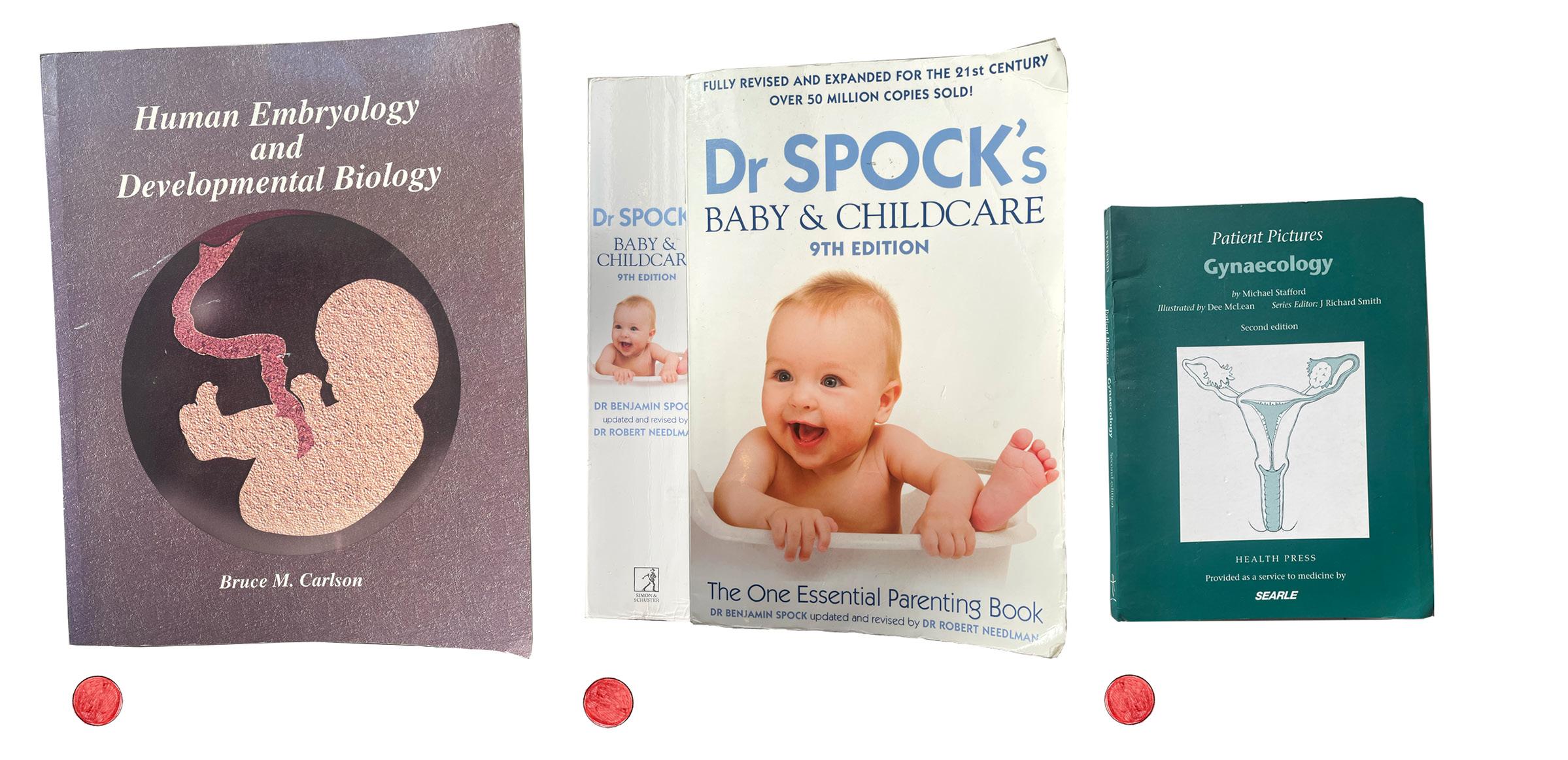
Human Embryology & Developmental Biology
Bruce M. Carlson
ISBN 0-8016-6415-2 Mosby
I have had this book since 1995, from my M.A. When researching ‘how medical conditions can be communicated through wearable and soft materials.’ This time was pre/ early internet and googling information. The publication is written for medical student’s use and reference. It covers exactly what it says on the tin and provides in-depth clinical guidance and 456 illustrations, many of them in the photographic form of some rather harrowing images of when things do not go to plan in fetal development. It has proved a valuable guide to the details of understanding how a pregnancy forms— starting with Early Development and the Fetal-Maternal Relationship; it takes the reader through the forming of sperm and the maturing egg or ovum—the formation of the range of body systems with comparisons to other species, newts and rates. The language is medical and not for the general public. This textbook has provided the science lens of embryonic and fetal development. In terms of looking at what is missing in the visual communication of early pregnancy and how the blastocyte changes into the trophoblast, which implants into the ready lining of the womb in day six. There are many visual examples of this stage- what I cannot find is an example of moving image which does not jump from this to the embryo growing out into the uterine cavity.
Dr Spock’s
BABY & CHILDCARE
Dr Benjamin Spock 1945
Updated by Dr Robert Needlman 1988
ISBN 978-0-85720-526-1
Simon & Schuster
Extraordinarily, this book has sold over five hundred thousand copies, only outsold in America by The Bible! It was written by a left-wing paediatrician, a political activist concerned about the U.S.’s family dynamics and the welfare of children being brought up at that time. He focussed on the need for children to feel special, loved and physically supported with hugs and affection. Children should be brought up with a less controlled strict schedule and fed when hungry. With 1118 pages, it could make a good doorstop. It starts with a chapter encouraging new parents to ‘trust yourself,’ ask about your aims in raising a child, nature and nurture and the challenges of raising different children in different families. The writing is clear and practical. It has a tone of authority but with a friendly and reassuring manner. It is extensive in practical advice for pre-birth, newborns, and the first three months. ‘Enjoying your baby,’ ‘Touch and Bonding,’ ‘Early Feelings,’ ‘Feeding and Sleeping.’ The book follows up on your baby becoming ready for university (hence the weight of it. There is extensive support for the healthy psychology of you as a parent, that of the child, and any subsequent children you may have. If I were pregnant and given this book, it would have put me into a blind panic of all the scenarios & expenses!
GYNAECOLOGY: Patient Pictures
Michael Stafford
Illustrated by Dee McLean 1996
ISBN 1-899541-10-1
Health Press
Katherine Gail - who I interviewed in reader number three is an expert in Women’s reproductive health, recommended this book to me. The book is published in its second edition and is designed to help women understand their anatomy and what each procedure or treatment involves. Most women will attend a gynaecology clinic and want to know how and why a particular disease affects them and what treatments are available. The illustrations by Dee McLean are clinical line drawings with a hue of green to represent the depth of an anatomical cavity. The images are set in a bold frame, which gives them a textbook aesthetic- classic 1990’s medical illustration. They aren’t warm but an unambiguous indication of scaling, placement, instruments, and implements. It covers an array of female reproductive treatments. It introduces the female genital tract, the position of the uterus, laparoscopy and hysteroscopy (D & C or uterine evacuation), cystoscopy, hysterectomy. Also, I have yet to hear of many, including bilingual, salpingo-oophorectomy, mymomectomy, endometrial ablation, salpingectomy, salpingostomy, and laparoscopic adhesiolysis. colposuspension. Kate reports this book has been essential to her communication with patients for the last 25 years in explaining the treatment they are about to, or have undertaken.
Visualizing Research
A guide to the research process in art and design
Carole Gray and Julian Mailins, 2004
ISBN 0-7546-3577-5
ASHGATE
Gray and Malins’ visualization of the research bible is a must-have for any post-graduate researcher. A colleague at the embryonic stage of the Birth Stories research recommended it. It has enabled a cohesive approach to the structuring and focus at the early stage of a PhD. The language is formal- but not written in a ‘power language’ tone; the book takes the researcher through the stages of 1.) Planning the journey- seeing the project as that - a journey that requires a navigator and route through setting up and establishing a methodology. 2.) Mapping the terrain: methods of contextualizing research; this covers the essential skills required for critical thinking and undertaking a contextual review to base and anchor one’s research journey. 3.) The research location, where and how the research journey can be positioned and orientated; what approaches do they look like? How to manage the information that the researcher generates. 4.) Takes the researcher back to the appropriation of the methods chosen and explored. So far, the book has enabled the project to sit within what feels comfortable to the working methods that feel appropriate and natural to me as an illustrator, communicator and image maker in designing and publishing the journey as illustrated readers as a method to explore and manage the landscape of the project. The book is supported with a website, the only downside of this publication is that it is so expensive.
Practice as Research in the arts and beyond Principles, Processes, Contexts, Achievements
Second Edition 2022
Robin Nelson 2013 ISBN 978-3-030-90541-5 PALGRAVE
Hannah Ballou recommended this bookespecially for the third and fourth chapters. Chapter 3- How to be both: From Practitioner to Practioner- Researcher. The premise is that as practitioners, we generate and create prototypes and pieces that are original as they come from us. Within the culture of academia’s ‘Practice as Research’ lens, the work has to be held up to critical scrutiny, and the scrutiny is not based on building the maker’s confidence. The language tone of the book is more dense and complex to navigate than Gray and Malins’ writing. It contains a graphic of Onto - epistemological model for practice research on page 46. The diagram shows the differences between “Know- How to Know- What, and Know- That” through the training of reading, making and reflecting on the maker’s practice. Chapter 4 examines “Concepts in Contexts,” the notion of framing “Doing-Knowing” Practice as Research or PaR is a project involving various methods in a multi-mode inquiry. As they are potentially so varied, the choices of aesthetics rely on the researcher to make the implied or tacit knowledge explicit so that the research’s claims are clear and not taken for granted as it is subjective and unlike other technoscientific research, which can be measured objectively. This process of measuring PaR feels complex yet evident at the same time. I am still processing the rest of Nelson’s book from chapter four.
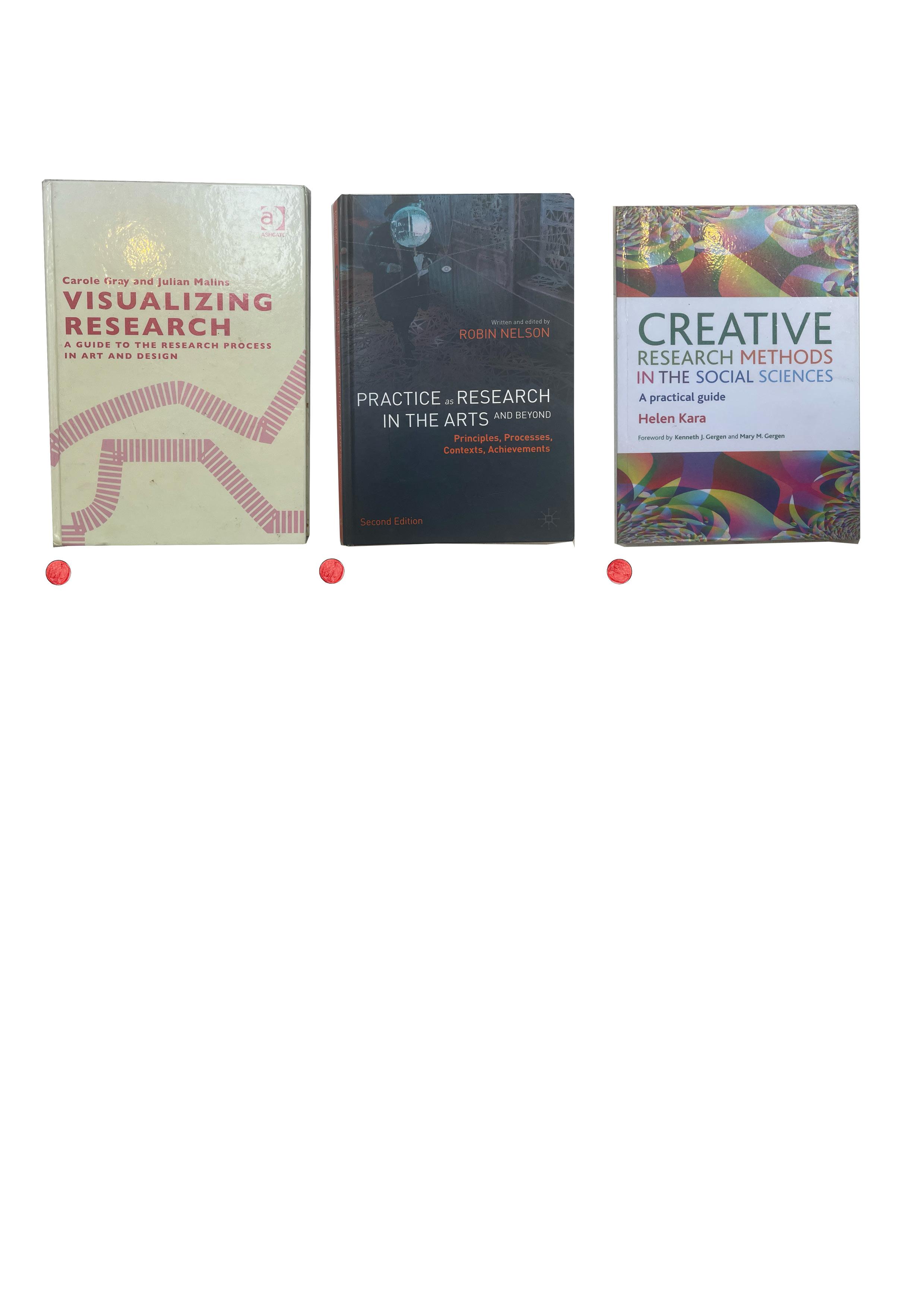
CREATIVE RESEARCH METHODS IN THE SOCIAL SCIENCES
a practical guide
Helen Kara 2015
ISBN 978-1 44731-627-5 POLICY PRESS
Page 12 of Kara’s book cites, ‘The verb to create in English simply means to bring something into existence. It is synonymous with ‘make’ and ‘produce.’ She uses an example of making an apple pie- your creation is not exactly like any other pie, but how creative is it?’ This is an example of the waffle-free approach of examples, which enables contextualisation of what quality research can, should and could be. I had low expectations of this publication as it was easily accessible and cheap(ignore the horrible cover.) The structure and content are straightforward and clear, and the examples and case studies are utilised. Chapter Three - Creative Research Methods and Ethics is excellent. Stating the theories of ethics, decolonised research, participatory action research, and critiquing transformative research framework. Managing ethical dilemmas in creative research, ethics in arts-based research, ethics in mixed methods research and research using technology. As a practice-based researcher, the responsibility is for your well-being as a researcher and the well-being of your participants. This one chapter has provided a wealth of drive and direction for where this practice-based project can navigate and the responsibility of the role of being that researcher. This publication will prove a go to guide in the design of the questionnaires and questions for both health professionals and patients.
Picture This
How Pictures Work
Molly Bang 1991
ISBN 978-1-4521-5199-1
Chronicle Books
Bang’s book is beautifully designed. It is a 30 x30 centimetres squared book printed on 190 gsm uncoated paper. The colour palette leads the viewer through visual experiments, testing and questioning our understanding of storytelling through shape and form. Little Red Riding Hood is a triangle; we are introduced to her mother, who is a larger triangle. She is made softer and has smoother edges; now, she is too dominant, so she is made back into a three-pointed form. Bang makes her mauve, and she resembles the parent form of a triangle mother. The book is brilliant in demonstrating how pictures make us feel through comparison and scale. What happens to our thought processes when the image plane is diagonal? Why do we feel safer looking at images on white ground? Bang’s book does not appear to have been designed thirty-three years ago; it is entirely fresh and sharp in the design through the imagery and the type. The second half of the publication takes us through the principles she has established from the visual experiments of the first half. She reminds us that images’ edges and corners are as important as the centre. The book concludes with the application of expectancy, sadness, fear, and fury and a series of exercises for the reader to apply their new insights from reading this fantastic book.
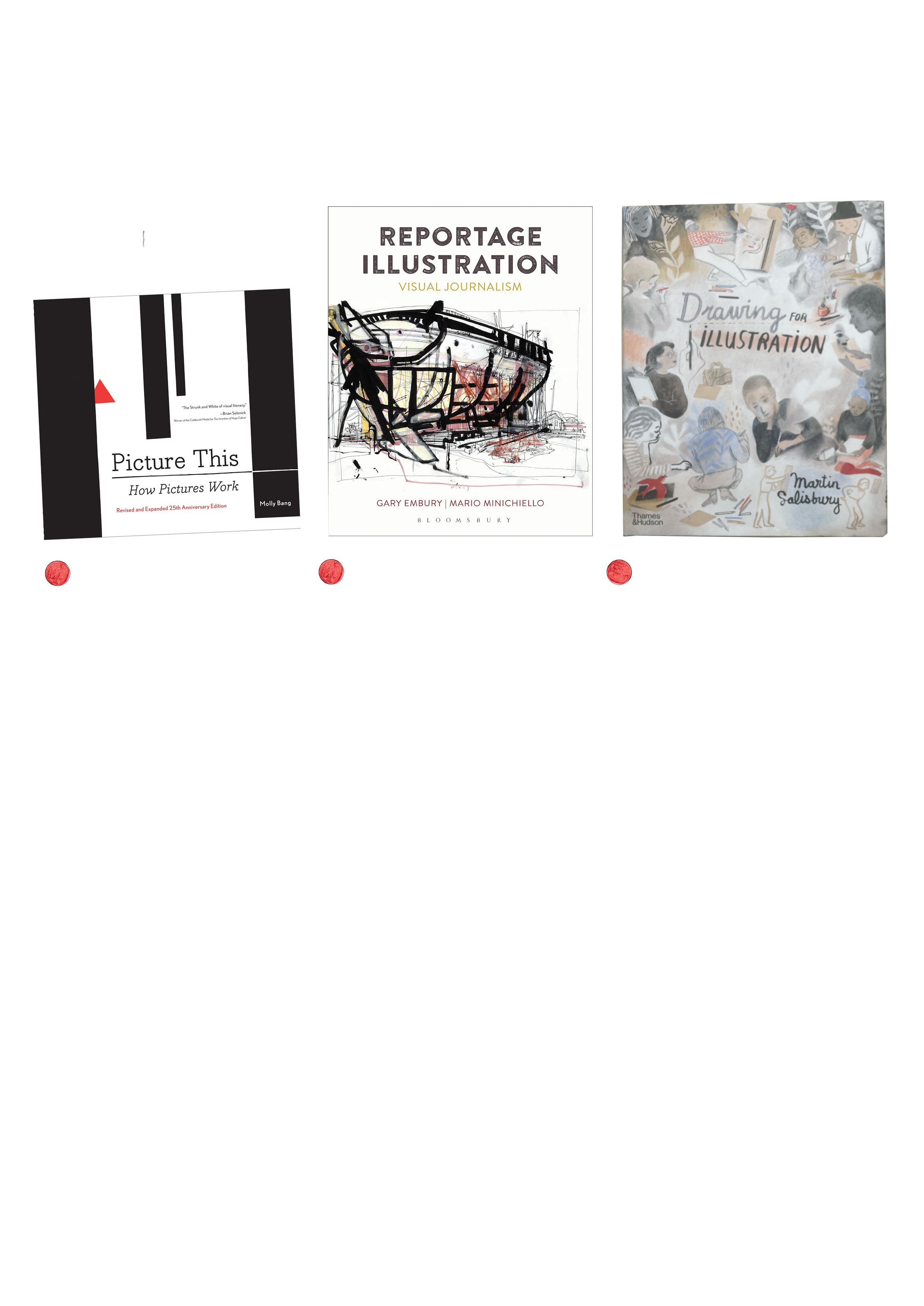
Reportage Illustration
Visual Journalism
Gary Embury and Mario Minichiello 2018
ISBN 978-1-4742-2459-8
BLOOMSBURY
Reportage Illustration is a co-authored book that brings together a wealth of examples and approaches to visual journalism’s communication form and its place and importance within creativity. The reader is led through four sections to unpack the themes and considerations. Firstly, there is the historical context of the reporting war artist and George Butler, an ex-Kingston student who has spent his career reporting visually from war zones, including Afghanistan and Syria. The publication moves on materials, methods, and media using case studies of various artists’ practices, from homemade structures of an ‘on the go’ desk worn around the shoulders to a range of constructive examples for students. Embury and Minichiello are both academics; this is evident in the structure and tone of the book, which shows that the purpose is a ‘how to’ approach with advice and anecdotes from practitioners. Pages 43- 68 explore developing one’s visual language by understanding the previous chapters. Interviews punctuate the chapters, posing questions like ‘How do you start a drawing from the first mark, considering all the information you have to deal with in front of you?’ This is an essential question as a documentary illustrator: you are wrestling with time, the hierarchy of information, and how do we communicate where we are in terms of location? People, characters and actions that occur when we are on location.
Drawing for Illustration
Martin Salisbury 2022
ISBN 978-0-5000-2331-0
BLOOMSBURY
Martin Salisbury is a Cambridge illustration professor who has written numerous books on the subject. As with most of his books, this example of his latest research is beautifully designed and is packed with examples of work from well-established practitioners and newer emerging creative voices. Isabelle Arsenault illustrates that the cover has a sense of magic within it. The imagery of characters realising shapes, faces, and forms from mark-making equipment evokes what a privilege it is to be able to make images and to be able to communicate through drawing. The structure of the book talks about what drawing is. We can learn to see through suggestions and materials, perspective, and other aspects of observation. The publication cites interviews and examples of applied illustration- Including Book Illustration, Character development, Atmosphere and fantasy, Authorial graphic storytelling, Advertising and display, Humour, Reportage and graphic commentary, Illustration and photography. Bloomsbury asked me, as an illustration academic, to review this book; it is a beautiful coffee table book. If one knew very little about illustration practice and methods, this book would be fantastically informative, and academically, it does not bring anything particularly new in how Gannon and Fauchon’s Illustration Research Practice shakes up illustration thinking and approaches.
Illustration Research Methods
Rachel Gannon & Mireille Fauchon 2021
ISBN 978-1-350-05143-0
BLOOMSBURY
The academic nature of Illustration as research was a welcome articulation by Gannon and Fauchon. Prior to the publication of Illustration Research Methods in 2021, practically all illustration ‘guides’ were focused on the visual aesthetic of what constitutes successful image-making rather than the research and the methodology behind creating work. As the leader of Level 6, this book is invaluable in enabling students to navigate a sustained research project. The authorial work, documentation, crafting, activism, and education categories set parameters for projects to sit within or straddle more than one. The range of case studies includes the work of well-established practitioners, students, and visual researchers in the early stages of their careers, beautifully documented throughout with images of the broad range of work. This seminal publication has a valuable appendix where the five categories are examined in Part 3:Key Ideas; the terminology is precise but offers a depth of understanding that has yet to be focussed on in previous Illustration guides. For example, in the area of ‘Reporting,’ Anthropology, Ethnography, Anthropocene, Flâneur and Flâneuse, Psychogeography, Dérive, Ethnocentrism, Othering and Decolonising movement make up the broader term. An excellent book - long overdue in the illustration academic field
Making Great Illustration
Derek Brazell & Jo Davies, 2011
ISBN 978-1-4081-2453-6
A&C BLACK London
Books that celebrate the ‘best of’ Illustration at one particular moment in time often seem dubious. The book’s writers reach out to their network and compile their ideas into a back-slapping celebration of practice at that one particular time. Davis and Brazell have a sound history of writing and thinking about the genres of illustration practice. This publication resonates primarily with the category of Topographical/ Reportage Illustration. Martin Harrison - then a senior designer at The Times, UK, selects and champions the three distinct voices of Laura Carlin, Olivier Kugler and The Times’ Iraqi war artist Matthew Cook. Martin commissioned my documentary and editorial illustration work from 2005 to 2020 when he retired. He articulates how the role of a reportage illustrator ‘Can put something into a news or travel image: information that might have escaped the photographer’s frame can be included in the form of written elements—the essence and spirit of an unfolding situation in that it can surprise and shock the audience.’ He quotes - which I have just seen,’ Jane Webster accepted a commission in Marrakesh to draw the markets, vibrant street life and labyrinthine souk.’ Kugler’s approaches to on site and photographic documentation will be explored in further detail, more fully, in the writing up of the literary review.-
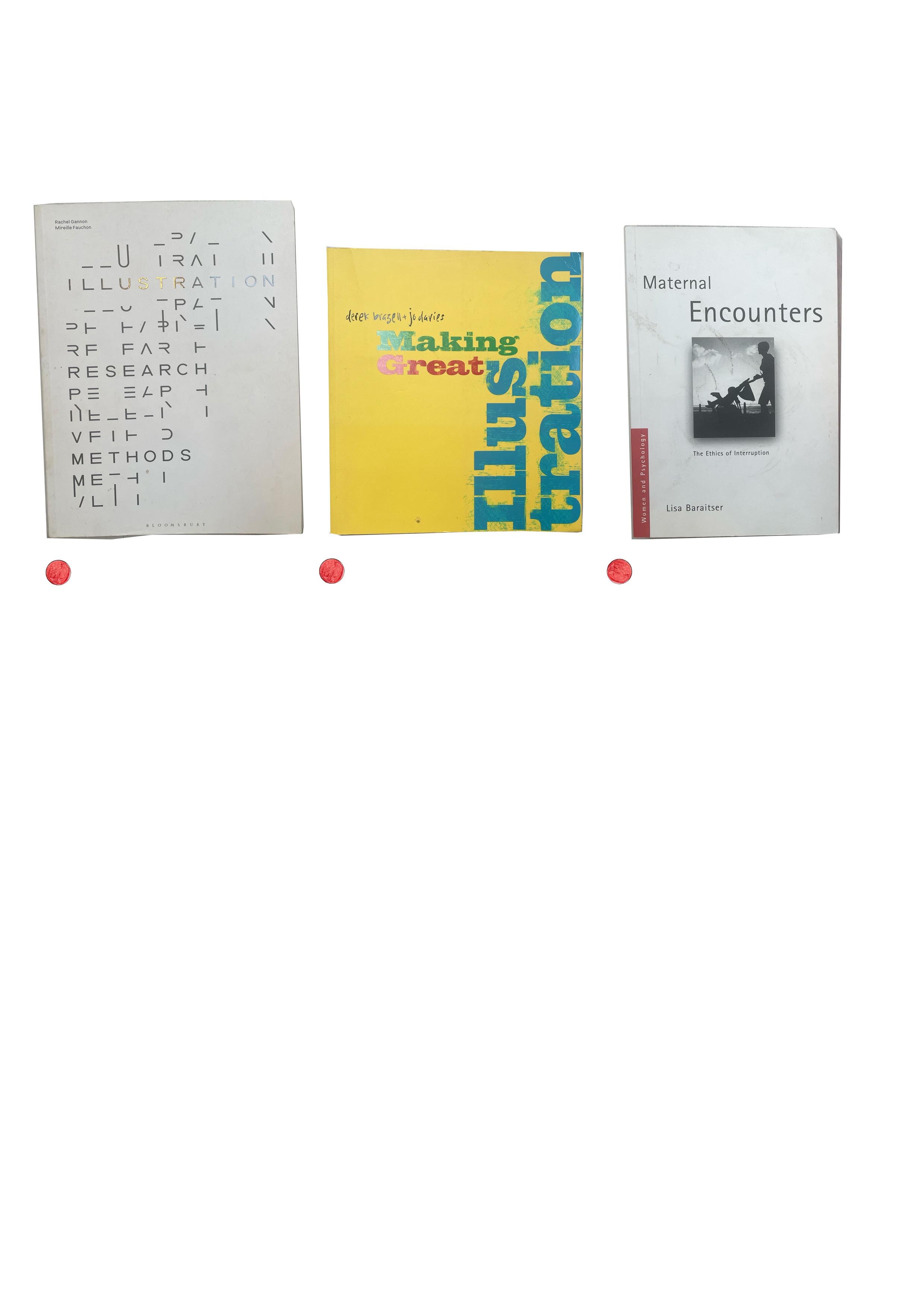
Maternal Encounters
The Ethics of Interruption
Lisa Barrister 2009
ISBN 978-0-415-45501-5
Routledge
It is an academically written book that intends to articulate women’s narratives of finding motherhood a shock of an experience and the chaos it can unravel in our relationships, sense of identity and self. The book presents a philosophical look at feminine ethics. ‘Mum’ a word that means to be quiet, to shut up- to ‘keep Mum.’ This sentence resonated the most clearly from all of the 180 pages. The book’s write-up sounds so promising and ticks the boxes required to read and interpret more academic text within the literary review. The writing style is so convoluted in the use of language. Sentences need to be clarified as they are layered and layered upon each other. For example, Barrister writes, ‘In this book, I seek to articulate the potential within maternity for new experiences, sensations, mood, sensibilities, intensities, kinetics, tinglings, janglings, emotions, thoughts, perceptions; new coagulations of embodied and relationship modes.’ Grammarly is trying to auto-correct the language! The notes section at the end of the book is helpful and cites a range of historical sources to explore maternal stuff, maternal love, maternal interruptions, transformation and alterity. Going back to keeping Mum- means to be silent, usually about a secret. Actors in silent plays were called ‘mummers’. Something new learned from the book.
Beautiful Evidence
Edward R. Tufte 2006.
ISBN 987-0-9613921-7-8
GRAPHICS PRESS
In this fourth book by Tufte, he follows form. He produces another beautifully designed book that explores how we perceive and understand the world around us through visual presentation, whether a picture, an instrument, or a ‘sparkline.’
The book’s definition is “data-intense, design-simple, word-sized graphics.”
These allow more significant amounts of data to exist in a small space but communicate complex amounts of information, also described as ‘datawords’ or ‘wordlike graphics.’ These descriptions articulate the potential of the graphic to speak to the viewer in a way that words are redundant or do not have the shorthand that data design does. The book’s highlight is a gatefold pullout of the fifth chapter, where Tufte shows a detailed analysis of the French army’s losses to the Russian army by Napoleon. This familiar image shows the ‘six fundamental principles of analytical design. To show 1.) comparison, contrasts, differences, 2.) casualty, mechanism, explanation, 3.) systematic structure, and multivariable data- to show more than one variable. 4.) For the example, show fully integrated words, numbers, images and diagrams. 5.) To thoroughly describe the evidence in the title, indicating the authors, sponsors, and data sources and point out relevant issues. 6.) The data can stand or fail depending on quality, relevance, and integrity. The book is illustrated with hundreds of images supporting his design theories.
VISUAL EXPLANATIONS
Images and Quantities, Evidence and Narrative Edward R. Tufte 1990.
ISBN 987-1-9308-2415-7
GRAPHICS PRESS
The third of Tufte’s books focuses more on describing design strategies and how the visual form can demonstrate the presentation of information through motion and cause. The book’s language, design, and presentation are dryer than Tufte’s other books. The section on ‘Explaining Magic’ - Pictorial Instructions and Disinformation Design is the highlight chapter as it uncovers how the ‘magic’ in magic tricks works to create the illusion and how a heart operation’s blood flow can be stemmed by the insertion of two of the surgeon’s fingers, illustrated by Dwight E Harken’s, ‘Surgery of the Mitral Valve.’ As with all his books, this one is packed with examples and phenomena, explained through drawings, diagrams, maps, and even X-rays to explain and communicate that ‘data should always take centre stage in any visualisation.’ Every bit of ink in the data needs to matter, and all redundant data ink should be removed, and the data should be revised and edited at each design stage. The book was first published in 1997; it stands up in design and content, and the illustrations feel fresh and relevant even after twenty-seven years. There are lovely playful images of typologies of ‘Unusual luminos glasses- surprise your friends!’ comparing adverts for X-ray specs. You can attend a Tufte masterclass for a snip at $385 for the day, including three books for your money.
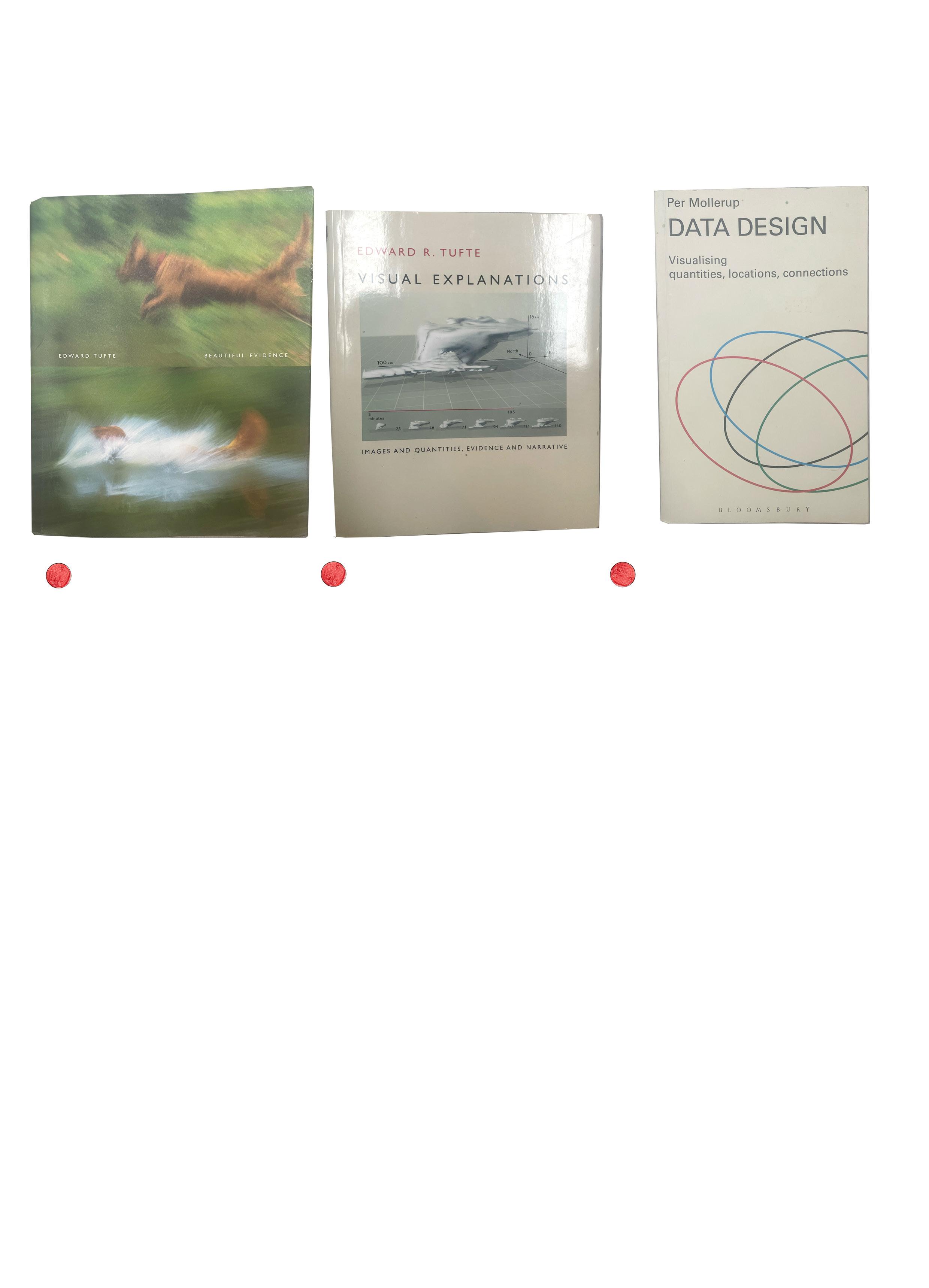
DATA DESIGN
Visualising quantities, locations, connections
Per Mollerup 2015. ISBN 987-1-4081-9187-3 BLOOMSBURY
Mollerup is a Danish Designer and academic who has written many books about branding, visual communication, and way-finding. I was surprised that Data Design was published in 2015, as the internal layout feels much more dated. The use of data examples is rather dull; the the book cites the same Napoleonic French army disaster that Tufte analysed in 2006. In this instance, the author enlarges and redraws the thickness of the line, showing the loss of troops as the campaign progressed. Other obvious examples are vertical bar graphs, radar and pie charts, financial performance maps, and geographic and transit maps. Chorochromatic maps are included- I remember using them in GSCE Geography to understand Bogota’s soil distribution and quality. The cover of Mollerup’s book is deceptively sophisticated, and the publisher is Bloomsbury. The book should have content aimed at a similar level of academic readership. This book was disappointing, and it will return to the ‘World of Books’ to find itself a new owner.
Envisioning information
Edward R. Tufte 1990.
ISBN 0-9613921-1-8 GRAPHICS PRESS
Edward Tufte is considered the ‘father of understanding information’; his job as a statistician often surprises students when they are introduced to his seminal books, as he is not a graphic designer. This book is the second of his range of examples of visual thinking. The space between the information graphics author and the curator of comparison is quite different viewpoints—Tufte’s ability to line things up in scale, colour and form. As a student introduced to his work, I remember seeing the simplicity of placing the major rivers and mountains of the world together on a scale from most minor to most extensive or vice versa; it was so apparent, clever, and obvious. Genius! Everything about his books is sophisticated in the considered design, the paper stock and colour, and the written introduction of why and how our world is complex and why visual information is necessary to make sense of it. The term, ‘The illustrations repay careful study. They are treasures, complex and witty, rich with meaning.’ What a beautiful recognition of why the visual is critical to communicate complexity and navigation through it. The presentation shows how a viewer can understand a phenomenon by placing visual information on top of the previous version (operational diagram of the Japanese bullet train) or in sequence (the lunar cycle). 30+ years old, this book is as relevant today as it was when first published in 1990. This book is the most focussed on design of the four books authored by Tufte.
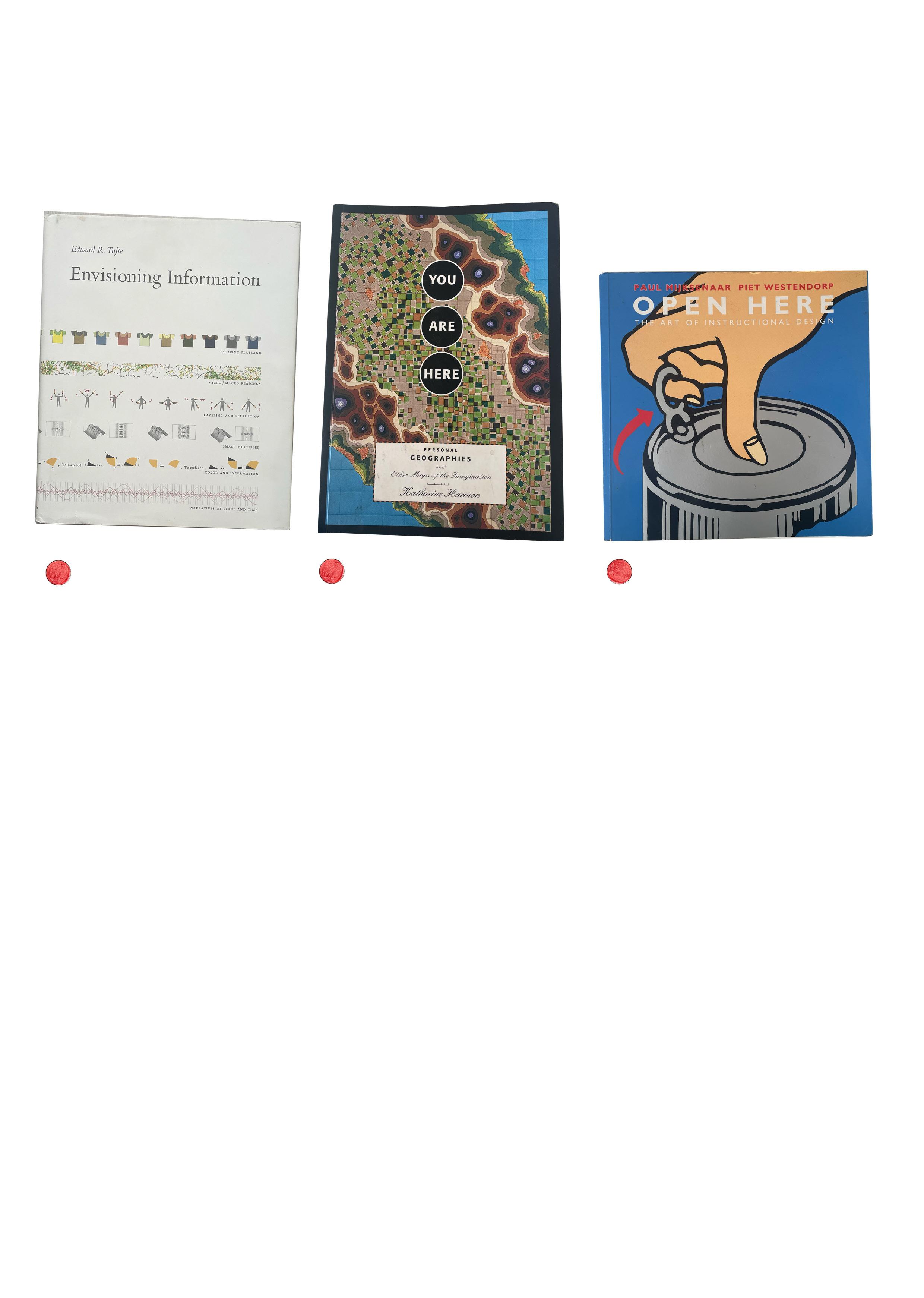
YOU ARE HERE
Personal Geographies and Other Maps of the Imagination
Katherine Harmon 2003
ISBN
Princeton Architectural Press
This book has been a staple teaching aid for the last twenty-one years. It explores the form of a map as a visual device to explain a host of phenomena, from falling in love to explaining a child’s day. The book cites artists’ interpretations of imagination as speculation of places and ideas that do not exist in reality. How do we read and understand the map form from a health perspective in reflexology and understanding the brain to the experiences of success and failure? Harmon includes over one hundred artists, illustrators and cartographers’ interpretations of these landscapes. All of these are taken within the apparent boundaries of the page and the media created. The range is extensive, from a simple pencil line to fabric to projected speculatives. The book’s design has remained fresh and relevant since its publication. It is an excellent example of a place for students to reference the start of a project when a base to build from is necessary. The language and the nuances of maps are ingrained in us from childhood, from a treasure hunt to asking, ‘Are we there yet? On a car or holiday journey. A map’s aesthetic can communicate space and time through the visual from fleeting moments to grand voyages instructional design
Open Here
The art of instructional design
Paul Mijksenaar & Piet Westendorp 1999
ISBN 978-1-5567-0962-3
Joost Elffers Books
When we think of instructional design, the crash landing card in the aeroplane seat comes to mind, as does the brilliant clarity of IKEA and Lego instructions. Open Here is a reference book that I have used in teaching since it was published at the turn of the century. Its pleasing scale and square format, with a gate fold cover and uncoated quality paper, take the reader through an extraordinary array of inventive graphic interpretations of human and mechanical actions. These actions are presented as artworks in the clarity of the ‘how to do’ nature of visual instruction. From How to floss your teeth, iron correctly when cutting a pattern, open a package, and use chopsticks, The publication and comparison of how non-language graphic iterations can articulate across language barriers show the potential of how illustration and graphics can communicate complex actions without needing words. In full colour and scale as crucial thematic, the examples chosen made this look easy, which image-makers and designers know it is not, and each successful piece of communication takes many iterations, considerations and testing for intended audiences. I love this book; it is another go-to for references when engaging students on how the visual works for the viewer. Graphic design that encourages specific behaviours and actions is essential for understanding and contextualising our worlds.
Of Woman Born Motherhood as experience and institution. Adrienne Rich 1976. ISBN 978-0-393-31284-3 NORTON.
This text is a classic feminist book written in the mid-seventies. Rich writes about her perspective on becoming a mother and identifying as a feminist. Specifically, she is looking at the balance and ownership power. Rich writes through the lens of ‘Motherhood as a prison.’ Due to the times’ patriarchal mechanism and the way that power dynamics were designed to restrict women’s rights. How, as an institution, we look at the value of women through whether they have or do not bear children. As women, we are conditioned to believe that we have less value if we are not mothers. If they are a ‘good’ mother, they must present to sacrifice their careers and the options open to them. If they are not seen to do so - they are deemed ‘bad mothers.’ Men’s role as a parent is historically present as a more critical role, and women’s role is devalued as it is expected to present in this form. The child carries the father’s name. The lineage of boys is essential to carry on the family lineage, and heirs are essential to carry the family name. Rich establishes that women need to reclaim motherhood from the patriarchy and destroy the institution of the family, where the woman is seen as validated through her role of taking care of the home and children’s health and not as a valued member of the workforce. Rich’s hugely dense yet influential book draws upon her vast experience as a poet, feminist, writer and historian.
Making Babies
Stumbling into Motherhood
Anne Enright 2004
ISBN 978-0-099-43762-8
VINTAGE
Enright’s short but pithy novel is one of the first memoirs to report from the front lines of how disillusioning motherhood can be. Published at a similar time as Rachel Cusk’s A Life’s Work, it focuses on the experience as an apology to other Mothers who may read it and see the reality of pregnancy at—nought-two years. As mothers, we are conditioned not to think about the negatives of pregnancy and birth. We should feel wholly grateful and blessed that we have the opportunity to bear the responsibility of raising this new person in our family. Your birth should be natural and positive, drug-free and spiritual. An epidural is an actual blessing from God. After delivery, the feeling between your legs feels ‘numb and mushy.’ She articulates how lactating and milk can feel disgusting; it is everywhere- going into the baby and being thrown back up out. The inevitable lack of sleep and the effects of that deprivation have on the state of your brain, and it is how it has melted into the form of fried cauliflower. This book is written in a backlash of honesty of all of Mumsy Mother and Baby’s books published in the first five years of the 2000s. I wish I had read it before I gave birth to my son; the sense of fear and failure would perhaps have not felt so overwhelming.
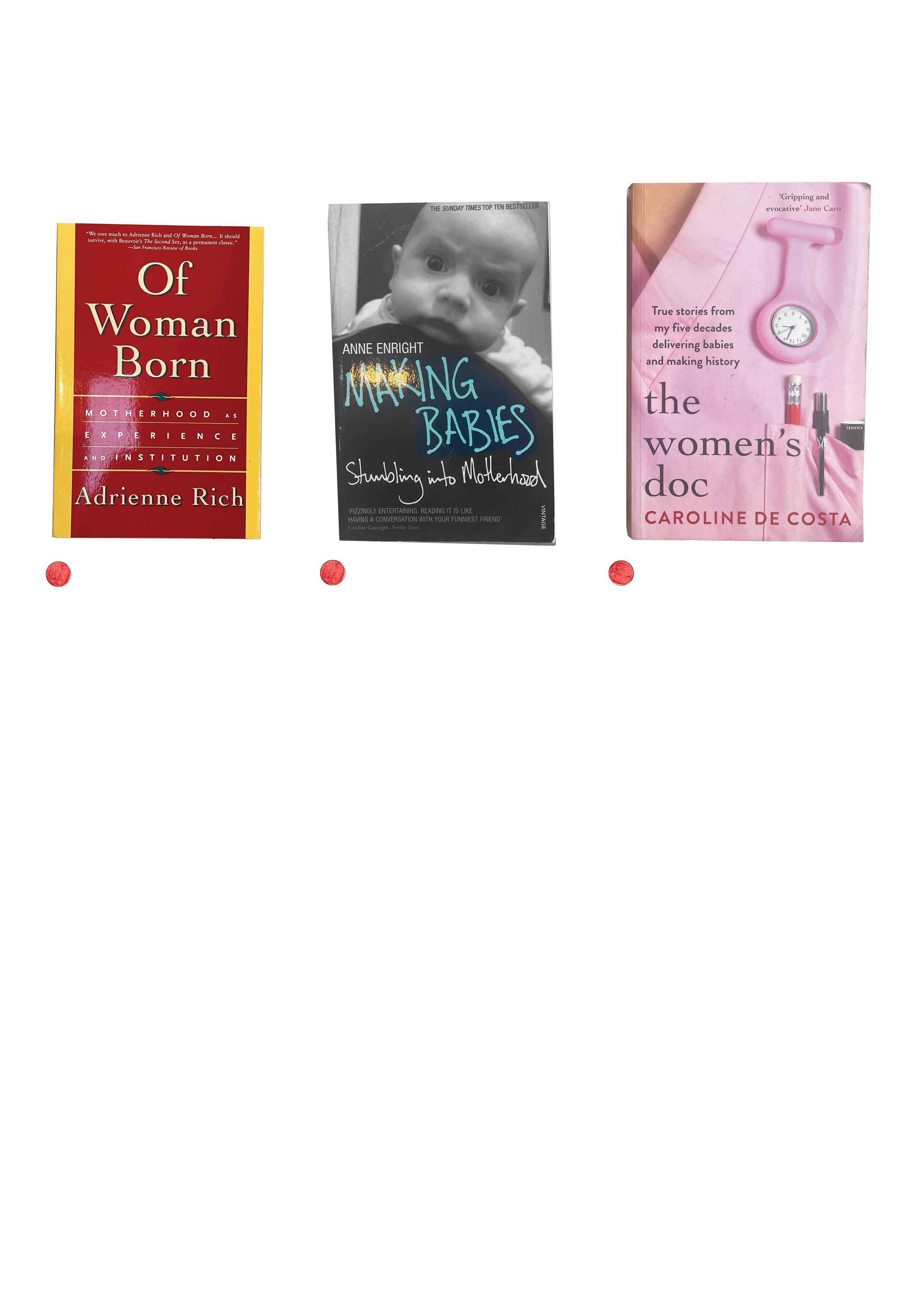
Women’s Doc True stories from my five decades delivering babies and making history.
ISBN 978-1-76052-914-7
This five-decade memoir is written with a light touch. It is humourous, outward-facing, and poignant. It covers the development of female obs and gynae health care in Australia from the 1970s until now. De Costa writes of historical developments that have revolutionised pregnancy and child delivery. Pregnancy tests took the form of a mixing of urine and cane toads! She reports how men have wanted to control women’s bodies and make choices on their behalf through all stages of pregnancy and birth. Women need to have the choice of where they want to have their babies; how, although now it is less dangerous than in the 70s, a birth plan has little or no resonance with an actual birth story, how this needs to change and how women ownership of the choices they make at a time of great vulnerability. She writes about why change has taken so long and how historically - a literal interpretation from the bible, it was believed that in the book of Genesis- it was made clear that women were meant to suffer in childbirth, concluding that any attempt to relieve pain by ‘artificial’ methods would contravene the will of God. In more recent times, she writes about how obesity is now the central issue in childbirth and how it poses a significant risk to the health of both mothers and babies. 7% of mothers now have a BMI of over 40. New devices have been developed to keep the weight up and off the vagina during labour.
MOTHERHOOD
Shelia Heti 2018
ISBN 978-0-09959-284-6
VINTAGE
Heti’s book sits alone in this literary review; her book begins: Flipping three coins on a desk. Two heads- yes. Two or three tails- no. Is this book a good idea? Yes.
Is it the time to start it now? Yes.
The questions continue in the practice of those who consult the ‘I Ching,’ where complex and significant decisions are made on the fate of the three flipped coins—the decision centres around whether to have a baby and embark on the journey of motherhood. Questions about whether being a mother creates an illusion of credibility and being admired as a caregiver continue. Is it normal to be a mother and not normal to be, or want to be? Am I less than a woman, then? Heti reflects on an unwanted pregnancy in her early twenties and how her doctor challenged a choice of abortion suited to her. Does modern society feel threatened by women who do not choose to have children? Her thoughts are recognised by her observations of her peers who are all having children. She notices how they are held and projected. Do her friends look bored? Is it precocious, spoiled, or bratty to think like this or write a book about it? Her book concludes with her intentions ping-ponging back and forth of not wanting to be more divided female flesh passed down in generations. Heti reconciles herself as needing writing and books, freedom, and womanhood, which are not centrally outlined by existing as a mother, serving yourself as secondary.
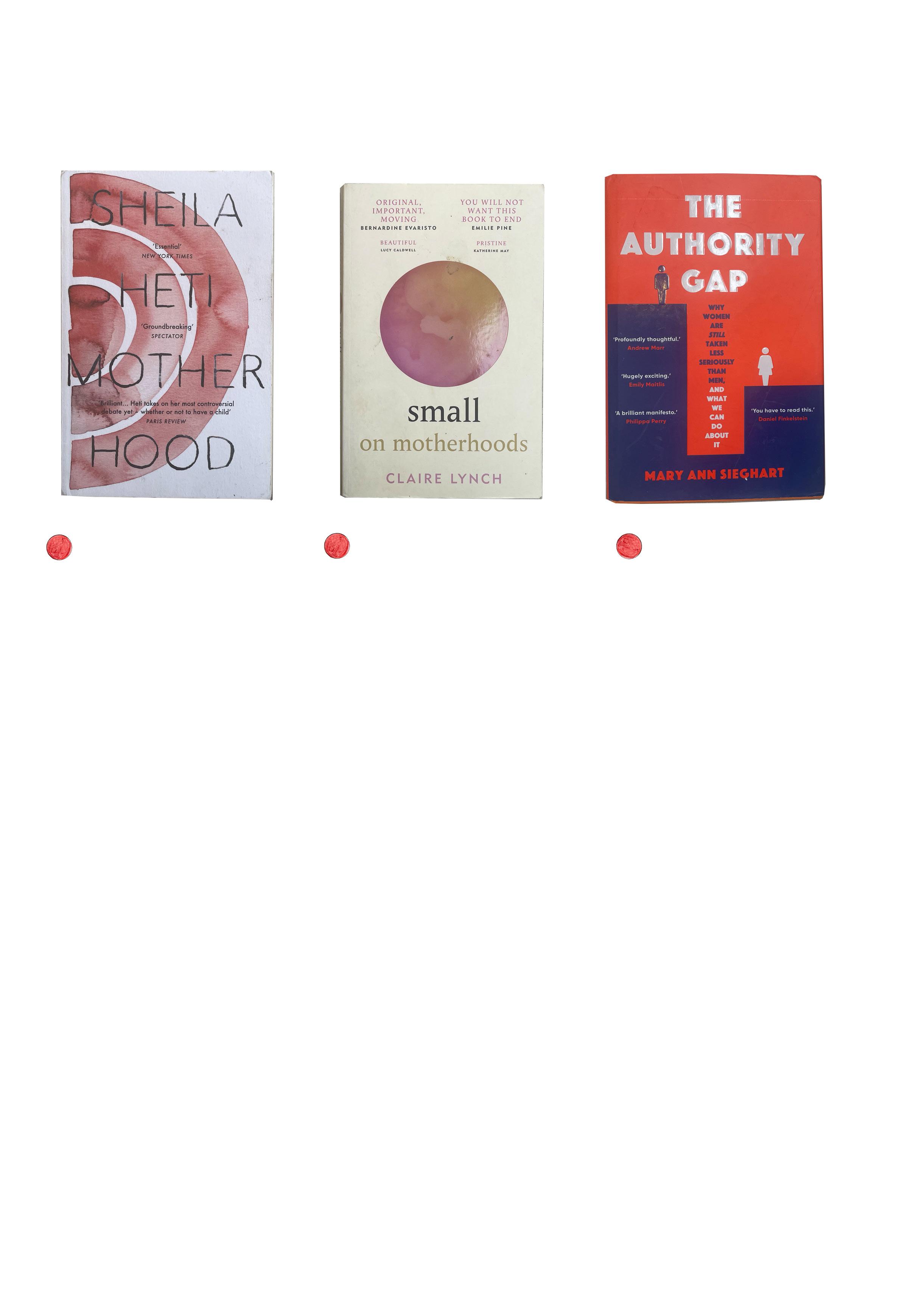
Small on motherhoods
Claire Lynch 2022
ISBN 978-1-914240-05-8
Octopus books
Lynch writes a poignant, poetic book about bringing twin babies into the world from the perspective of a two-mum, same-sex couple. The book is a stark reminder that every pregnancy has different stakes for all the stakeholders when the pregnancy sits outside outdated social norms. The book’s design is beautiful; the cover reads as a pink sphere, but on closer inspection, it is a fetus floating in an amniotic sac. The typed prose is designed into sections of concrete poetry. Reading from a Kindle would be very irritating. It feels personal and emergent, a race to get these babies across the line to get home and become part of this new family unit. “Small is not good; it’s not cute or admirable.” Having a baby in the Neo-Natal unit is a strange world of lights, beeps, and tiny milestones that feel monumental yet precarious. Having two babies must feel even more heightened in the microcosmic world where everything plays out in this dark blue, quiet calmness. Lynch uses a single word for each chapter to frame the linear experience of her and her partner’s journey. The unknown of testing for brain activity after an early birth experience makes the hair stand up on my neck following the blissful ignorance we encountered with our second child. Lynch’s book is the first publication in this research covering this untalked about facet of birth stories.
The Authority Gap
Why women are still taken less seriously than men, and what we can do about it?
Mary
A Sieghart 2021 Doubleday
ISBN 978-0-8575-2756-1
‘Research shows that women are twice as likely as men to say they have to provide more evidence of their competence.’ writes Sieghart within her introduction. The Authority Gap can be read as a depressing journey across a landscape of misogyny and a poor road map of choices for us and for our daughters. Written with acerbic observations and wit, Sieghart spells out the ‘bleedin obvious,’ how we are cut off in what we have to say, being mansplained to. She is presenting how we bring up boys to continue this behaviour. The publication examines the entangled bias we live in at work and societally. The recent publication date of the book surprised me; it could and should have been published 10 or 20 years ago. A focus on the solution is presented for every action that should not be. What can we do as individuals- stop mistaking confidence for competence? What adjectives are we assuming onto women? Would they be the same as a man? What can we do as partners? The unpaid workload imbalance and roles as caregivers. What can we do as parents? Seeing parents’ equality within the home, not being biased in assigned chores, and identifying strong female characters in books. What can we do as colleagues, employers, or educators? What is the role of the media and society as a whole? Siegart believes we could resolve it if everyone became accountable within a generation.
GIVING BIRTH= how it really feels
Sheila Kitzinger 1989
ISBN 0-575-04111-0
Gollancz Paperback
The visual language of the cover of this book suggests that it was published in the late 1980s. Typographically, Kitzinger’s name is the same size as the title. The photograph shows the newly delivered baby being caressed by the mother in a water bath postpartum. Her sixth book centred around the childbirth experience. She spent her life advocating for better birth experiences for women as a social anthropologist, activist and feminist. At the time Kitzinger wrote this book, she was under considerable backlash from critics for her encouragement and advocacy of uncomplicated births being potential home births and older children being present at sibling births. Her book is way ahead of its time, page 15: ‘When women talk to each other they are often reticent about describing how they felt in childbirth. They hold back on communicating the power and immensity of the experience because they are anxious not to alarm others who have not been through it.’ ‘There are other women who describe with apparent relish each pain and flaunt obstetric difficulties as if their were prizes for having suffered in labour.’ ‘It often seems that pregnant women attract horror stories of this kind because they grow up knowing little about a subjective experience of birth. Childbirth has been medicalised, sanitised and taken out of the home.’ This book talks about how birth is treated as it is a pathological event rather than a normal life process. Few medical professionals have seen a natural, unmedicated birth knowing little about how to support the normal physiological process with a birth scenario.
OURSELVES AS MOTHERS
The universal experience of motherhood from the bestselling author of Pregnancy and Childbirth
Sheila Kitzinger 1992
ISBN 0-553-40549-7
Bantam Books
This next book in Kitzinger’s series of twenty focuses on the perception of mothers and birth in a more global context. The text examines how women are viewed within and outside the marital framework. How does society examine the anti-mother culture, where Western culture is perceived as unsupportive, with the expense of nursery care and the pressures from the media as unrealistic? This is 1992- it only got worse! I have just checked that one child in a full-time nursery now- costs £15, 000 per year. Kitzinger looks at many examples globally from India, Jamacia, Eastern Europe, and birth under Communist culture systems at the time. The findings- as expected, are varied. She examines how Western culture has a less ritualistic experience preparing for a birth. As the pregnancy develops, she becomes more reliant on the medical profession. Women’s concerns are trivialised, and asking too many questions can be deemed as being difficult. ‘I went in with a lot of questions, but when they had finished doing the examinations I couldn’t remember any of them.’ Many cultures have postpartum rituals that support the new mother. Lying in exists in many societal frameworks- a darkened room with no interruptions and expectations other than feeding the baby and being nourished as a mother. Instead of being expected to look great, have a non-crying or fussing baby, an immaculate house and be great company for the array of visitors who will come through your door and want to pick up and touch your baby.
The New Experience of Childbirth
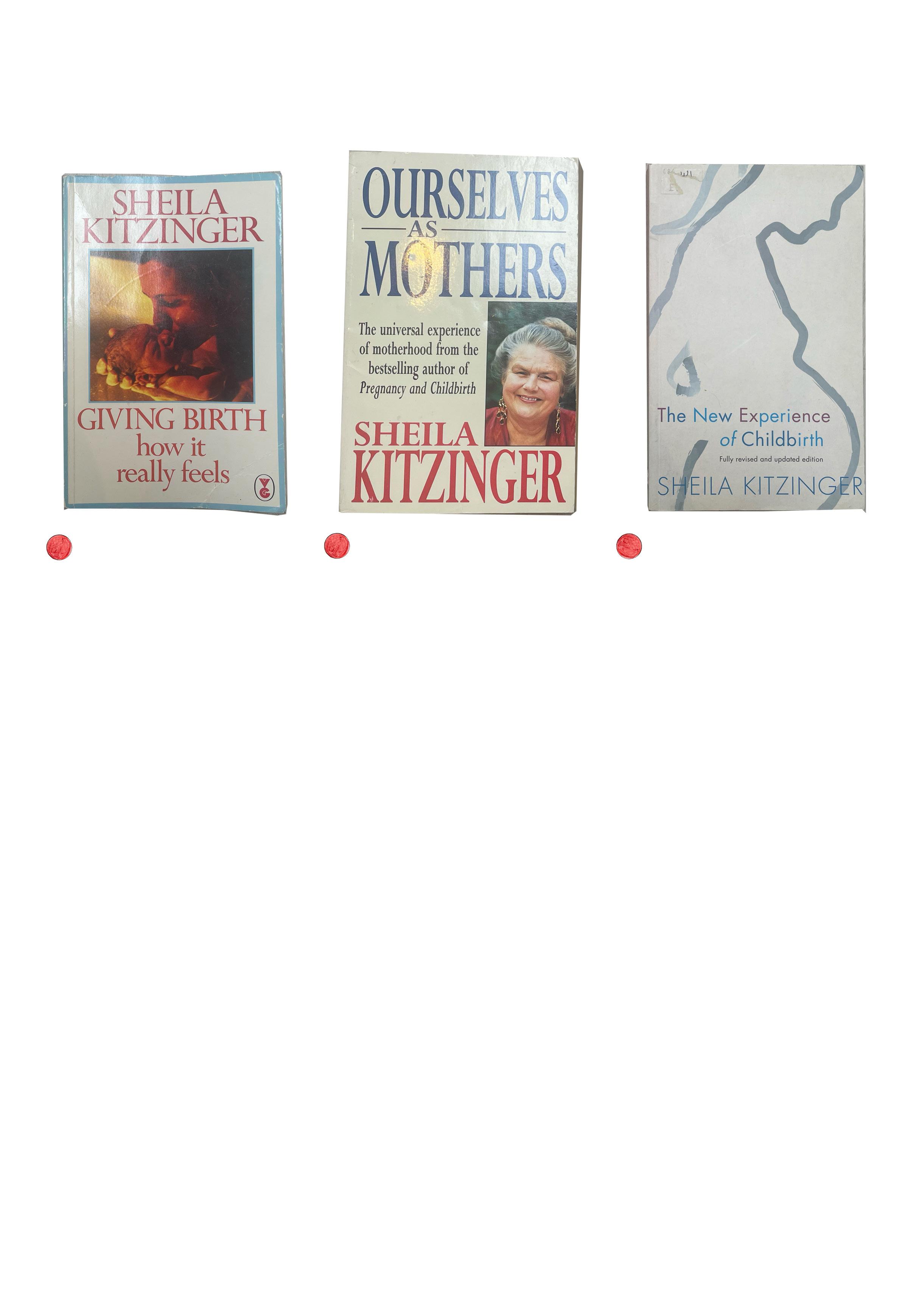
Kitzinger—as a mother of five daughters, a midwife, an academic, and a campaigner for women to have the information they need to choose childbirth. A note to the reader—this is not intended as a reference book. The disclaimer is interesting as a later published book, assuming that Kitzinger is in the backlash received from the medical establishment. She cites other of her books for this information. The book is cited so midwives can read the MIDIRS (Midwifery Journal.)
The book has several line-drawn illustrations to visualise the key stages of birth, the baby’s positioning as it transcends the pelvis and birth canal, and how the cervix ripens and opens. It also discusses the baby’s physiology —how the skull is viewed from above and the side in terms of usual and some less usual presentations. Before the illustrated section, the book focuses on the birth partner’s role as a voice for you as the birth giver to concentrate on the power released within your body. It also looks clearly at the stages pre-, during, and post-delivery. How can you encourage your milk supply, and how important is your diet as a person supporting another person’s growing needs and development? The book’s last section discusses the evolving relationship with your baby, and it can and is normal to feel disappointed and disconnected with your new baby, if they are not the ‘perfect’ baby you had in mind.
Birth Figures
Early Modern Prints of the Pregnant Body
ISBN 978-0-226-82312-6
The University of Chicago Press
Whiteley is a historian who has written an informative and well-illustrated guide through visualising and depicting the fetus in utero from their first iteration in 1515 to the example of abnormal presentations, digital image from the MSD Merck Manual, accessed in 2021 for the research. The plates provide an extraordinary insight into how a fetus presents itself. Many appear to be tiny adult forms floating in a bag of space or a light bulb. Whole heads of bouncy hair top these cherubic, chubby forms, arms in the air, looking like they are descending stairs, touching their toes or being inside a wind tunnel. The plates explore in historical chronology how different groups engaged in midwifery manuals. These included experts of the medical establishment, doctors, and midwives but also others who were illiterate and lay readers- (those able to contact parts of a church service who were not a priest.) The publication documents the power of print and the developing technologies from the mid-sixteenth century to make sense of the perception of the female body in the pregnant state. The sections on William Smellie and William Hunter are exciting, based on ongoing visits and drawings of specimens at the Hungarian Collection. I will return to this book as it has such a wealth of visual information and the plates require more in depth investigation and reflection. 24.
Matrescence
On the Metamorphosis of Pregnancy, Childbirth and Motherhood.
Lucy Jones 2023
ISBN 978-0-241-51348-4
Allen Lane
Following the number of books published in the last five years reporting from the front lines of motherhood’s trenches, this informative and candidly beautifully written book opens with, ‘Pregnancy and Birth and Motherhood simply didn’t match up with cultural, social and philosophical narratives I had grown up with.’ She articulates, ‘In the hours, weeks and months that followed, I grew more and more alienated, frustrated by the lack of language to articulate the reality of childbirth. No one was talking about the pain; about the emotional process; about how it felt to have grown another human.’ Matrescence - to become a mother is a relatively new term for this transition. Jones explores her new relationship with her own mother-how; how she contextualises that she has come from her. She cites the changes in the amygdala. Your brain changes physiologically after birth; it is set up to be on ‘high alert’ from that moment; this phenomenon has been recently scientifically proven. Isolation, sleep deprivation, and pain as your body recovers from whichever delivery you experienced during birth- the crying and the receipt of little back from a baby in those first weeks. I will return to referencing this book in much greater depth in the resonance of this memoir and the alignment to this research project. I plan to interview Lucy Jones as part of the Birth Stories project.
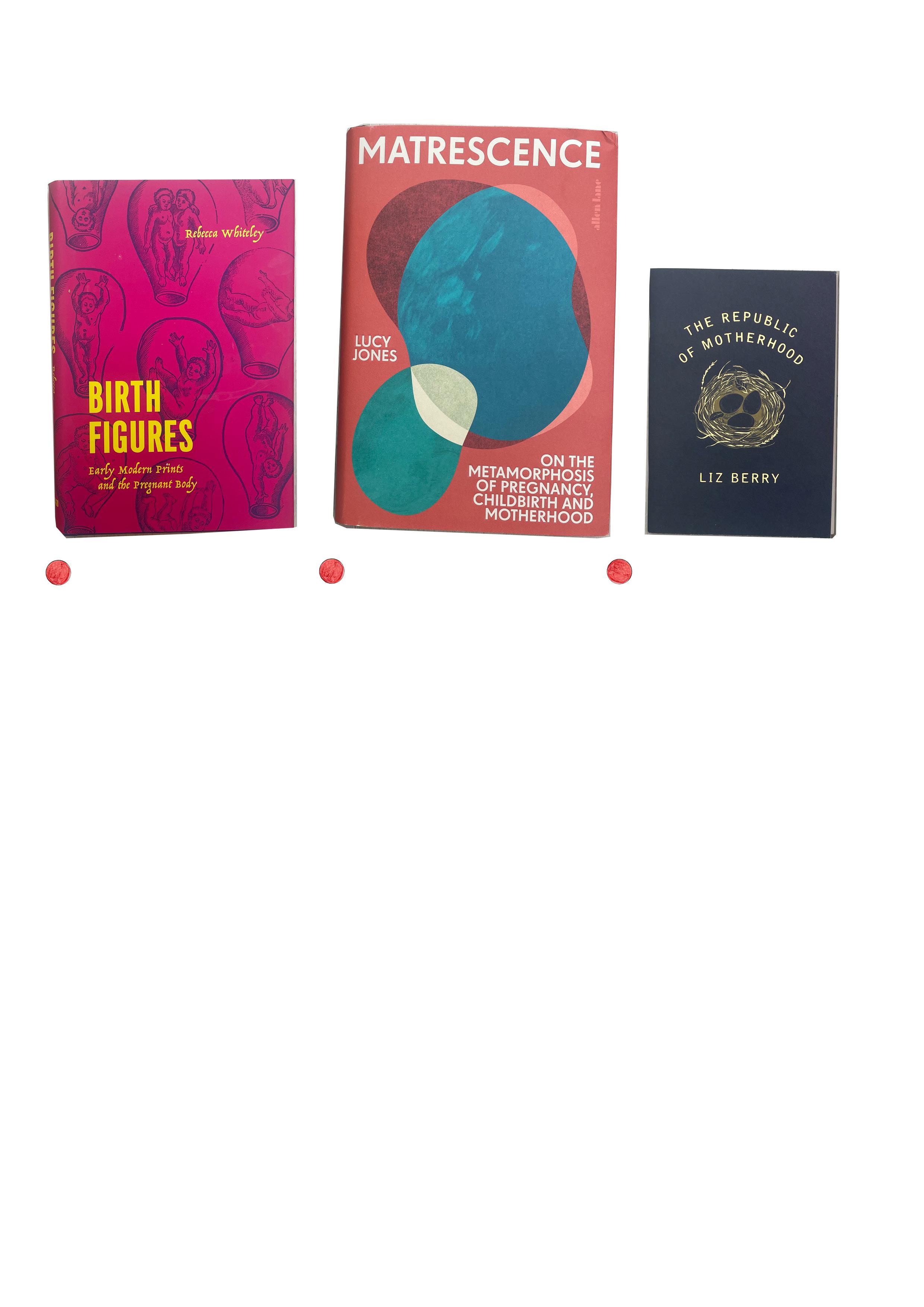
The Republic of Motherhood
Liz Berry 2018
ISBN 978-1-784-74267-6
Chatto & Windus
This tiny book contains the winning poem of the ‘Forward Prize’ for the best single Poem of 2018. ‘I crossed the border into the republic of motherhood and found it a queendom, a wild queendom.’ The book contains fourteen beautifully written poems which articulate the feeling of the rug being pulled away as you are expected to fold into the blanket of Motherhood, not to question or complain about the expectations of what can feel like a derailing of your life and career. The form of feeling so tiny and personal is part of this publication’s charm. The poems cover a range of emotions, from joy and thankfulness to feeling so wildly inept and unqualified for such a responsibility and every aspect of your life-changing so quickly. This book followed the birth of her two sons and a creative hiatus. The book’s title poem is the most hard-hitting and will resonate with all new mothers. It has a political note; as the new mother, you need to parade yourself as the queen as you push your pram down the ‘boulevards of motherhood.’ ‘I stood with my sisters at the queues of Motherhood- the weighing clinic, the supermarket- waiting for its bureaucracies to open their doors.’ In her poems, Berry references Charlotte Perkins Gillmans The Yellow Wallpaper within the poem titled The Yellow Curtains. ‘There are things in these curtains that nobody knows but me or ever will.’ I intend to look for more poetic interpretations of Motherhood.
Information Design Workbook
Graphic Approaches, Solutions, and Inspiration
+30 Case Studies
Kim Baer 2008
ISBN 978-1-59253-627-6
Rockport Publishing
‘Clutter is a failure of design, not an attribute of information.’ Edward Tufte’s quote opens Baer’s book. The publication’s design is clear and demonstrates the link between each chapter, starting with why design is so important. The nine chapters walk the reader through sound principles of design ‘storytelling’—why best practices are that. The importance of simplification is central to the user-centric design experience. The book uses many examples to illustrate successful and unsuccessful design scenarios. They include the hierarchy of information, typographic choices, colour, the sophistication of the intended audience(s) and place. Where is the design seen or placed, and how long did/ does that audience have to understand and contextualise it? The process of acknowledging particular diplomacy, political stances, and the audience as stakeholders and readers of the information. Published in 2009 - as the context of the global ecological crisis was coming to light, this book is very consciously aware of the latter examples demonstrated in the research behind the world changing and how we have a responsibility as designers to articulate this to everyone needing to hear the visual message- whether through icons, typography, symbols, illustration, maps and/ or a recipe of all. Audience and message are critical to this intention. The references are somewhat dated- however the intent remains current in 2024.
Visual Function
An Introduction to Information Design
Paul Mijksenaar 1997
ISBN 978-1-568-98118-5
Princetown Architectural Press
This is one of four small books explaining the visual phenomena of our world. It is surprisingly helpful and informative. Although the book’s design is a little dated, the author takes the reader through all of the principles of information hierarchy and how and why we respond to visual prompts. Transportation maps are more successful for visitors and tourists if designed topographically with stations augmented with parks, museums and other landmarks. The Challenger space shuttle may not have exploded if the correlation between the ‘O-rings’ and low temperatures had been communicated in a clear graphic form. From road signs to uniforms to actions and behaviours, graphic form and orientation are essential for the public to access and understand the world or specific locations—the pictogram’s role is to emphasise or understand a place or event. They can compare or order information or experience- grouping or sorting information, showing variables in an experience, and selecting or omitting confident choices. Understanding quickly what a uniform means- will they help or threaten you? Thankfully, the last example is not something we are confronted with often. However, we have all landed at an airport disorientated and tired of being confronted with a wealth of information in an unfamiliar language or letterform. Graphic Design is an invisible language to many, but a essential element in all our existence and experiences.
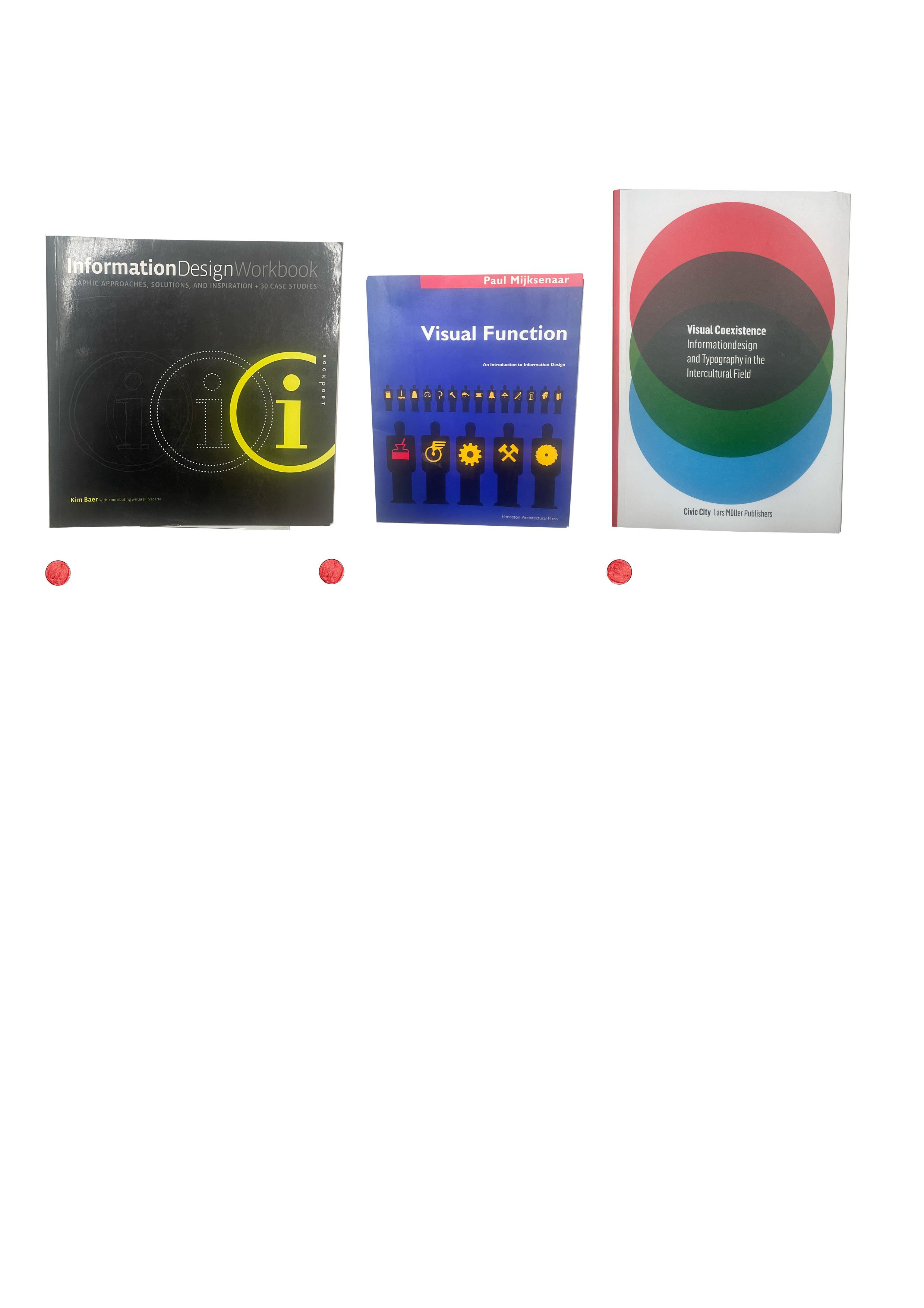
Visual Coexistence
Informationdesign and Typography in the Intercultural Field
Civic City 2020
ISBN 978-3-03778-613-0
Lars Muller Publishers
Civic City’s sophisticated study explores the relationship between The reading of typography in a global sense while identifying specific languages such as Latin, Arabic, and Chinese to maintain the systems and mechanisms of how they are intended to be read. Ruedi Baur and his scholarly team lead the viewer through examples to analyse and unpack visual graphics from different cultures and identify their specific principles of depiction. How do we read typography- through letter form, spacing between kerning and leading, and how do these principles translate into other scripts with differential rules? The premise of the research is to gain the broadest reach to a global audience. Where do these examples sit in real life - whether in the urban environment or online- and how are they read and engaged through the examples of infographics explored as the slides with the publication? Civic City’s book is geared very much toward graphic design academics. I am still determining what I would take forward from this very focused and beautifully designed book in terms of the research question that I am exploring.
Information Is Beautiful
David McCandless 2009
ISBN 978-0-00-749289-3
Harper Collins
The author describes his book as a modern-day map book- a range of charts, graphs, and visual information designed to inform the reader about miscellaneous facts and phenomena from the internet in a series of experiments to make them approachable and ‘beautiful.’ The range of which shows an excellent sense of humour. I have had this book for years and skimmed through it without properly digesting it and perceiving it as a graphics book of the noughties ‘want to be’ Edward Tufte. The content relates to the ridiculous feed of saturated information we sift through and digest on a daily basis. The themes include ‘a table of condiments that periodically go bad’ presented as the periodic table, to reasons why ‘we broke up’ and how we spent 77.8 years of our lives. McCandless clearly enjoyed researching and designing these humourous graphs and statistics, and he is celebrated for his skills as a visualiser of this arbitrary information. The bibliograpy cites Tufte’s work, and Harmon’s YOU ARE HERE book. Schotts Alamanac and I intend to read two other books - ‘Else/Where: Mapping new cartographies of networks and territories’ by Janet Abrams and Peter Hall. ‘SUFI’ Laleh Bakhtiar. McCandless’ website allows the viewer to interact with the material and data and experience animated interactions and content
Mona Chalabi Data Analyst
Chalabi is an award-winning image maker who focuses on visualising data for journalism. Educationally, she comes from a political and economic background. She works for the New York Times and The Guardian Newspaper, utilising her analytical skills to explain complex information with an accessible - almost childlike ‘feltpen’ language drawn on gridded paper reminiscent of school textbooks. The brilliance of her work is in that she makes it look so easy. At just 33, in 2020, Chalabi was appointed an honorary fellow of the British Science Association. She won the Pulitzer Prize for showing the world how they could imagine understanding and spending the wealth of Jeff Bezos. Her use of Fingers as graph lines or as the silhouette of a yoga pose presents the rise in the practice over three years, even phallus’ to communicate penile dysfunction and the climax of the American population.
Much of Chalabi’s work explains racial and sexual bias’ and the disparity of fairness between demographics. The humour and wry wit of being able to point out what information the readers perceive to be under their nose, however, without her clever takes on the understood traditional forms of data communication through charts, graphs, pies and flags. Even colour in the above chart explains the most common public hair injuries!
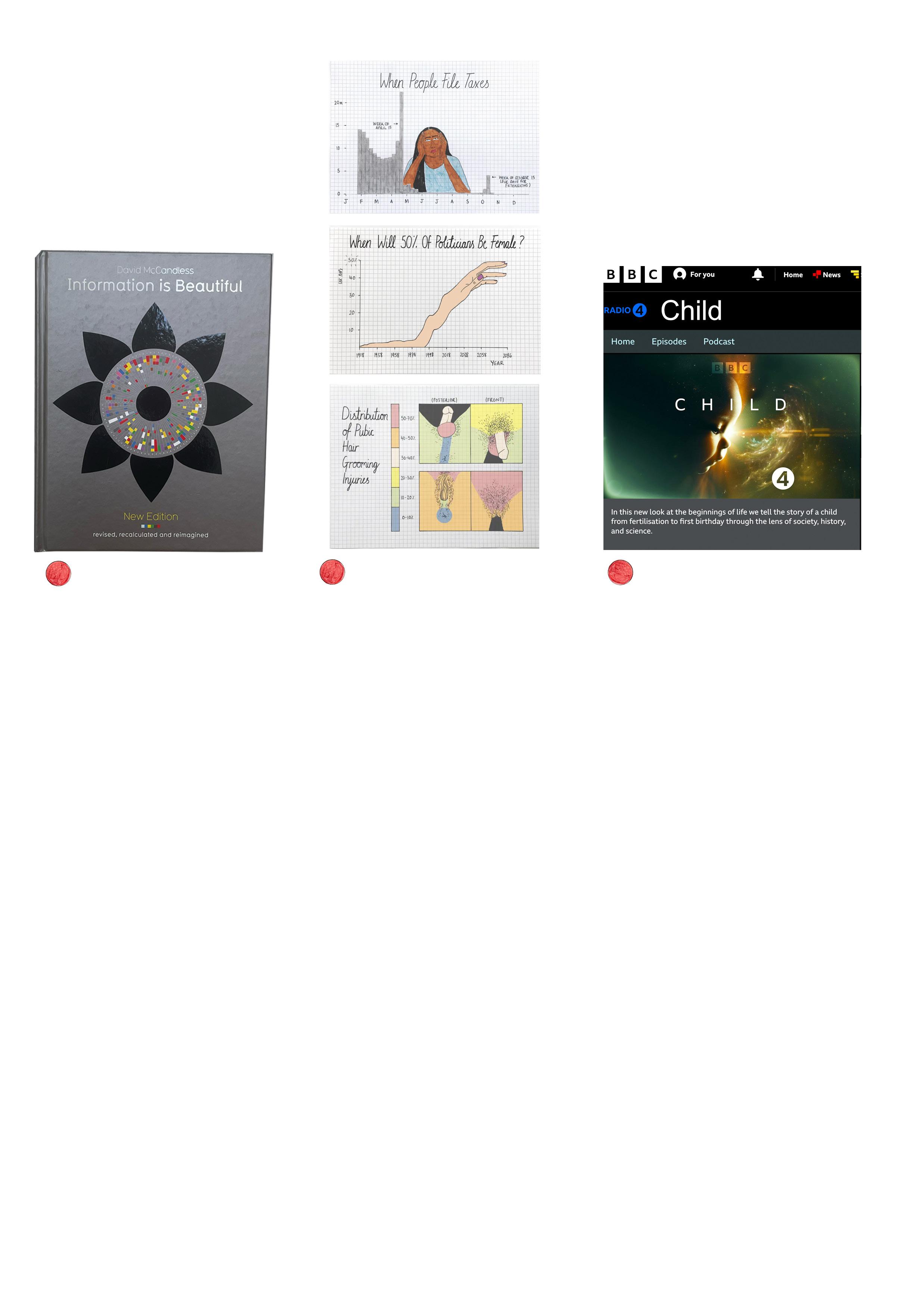
Child- BBC Radio 4
India Rakusen 2024 Episodes 1-28
India Rakusen is a journalist, documentary producer, writer and presenter of the BBC Radio 4 podcast ‘Child’ delivered in 28 episodes; the podcast begins in a petri dish, where the professor talks to our host about how the 100 cells of a blastocyte work out their different roles, a third will become the baby, a third will become the placenta and the others will become the yolk sac to support the growing foetus. We are taken through the stages of pregnancy and the politics of how social and historical trends police women’s bodies and leanings.
Many of the writers of the books I have been reading and referencing are included in the episodes. Historians, including Elinor Cleghorn- author of ‘Unwell Women,’ Midwife and writer Leah Hazard, who wrote ‘Hard Pushed’ and just published the book ‘Womb.’ The program offers a chapter on Matrescence and explores the work of Lucy Jones in her new book of the same name. India is pregnant as she hosts the programs; this offers an additional sense of magic and wonder to the ‘imaginary’ baby’s growing development as she houses hers. ‘Babies’ Netflix program’s neuroscience expert at M.I.T Rebecca Sach’s brain development work is presented as she discusses how her research provided the first brain scan of a Mother and baby looking at each other, showing which areas come alight in the nonverbal communication between the two. The podcast is exceptional in linking together policymakers, experts at the head of
maternity organisations, writers, mothers, and fathers- did you know that a drop of 25% in testosterone happens in new fathers? To the voices of midwives and the rise of the doula being part of the process, all with the same goal of understanding and communicating the known and the remaining mysteries of pregnancy and birth. We still need to find out what starts a spontaneous labour. Is it a chemical the baby releases or hormones passed through the placenta?
The role of Oxytocin in the delivery of a baby is essential, and when that drops - or is derailed by cortisol or adrenaline - the chemicals associated with ‘fight or flight’ can have a detrimental effect on the labour slowing down as the messages to contracting uterus become mixed. The choices of pain relief and the differential ways we can manage pain. The secrecy and issues surrounding the news of a pregnancy, the association that you are looked at as having engaged in sex at a certain point. Employers who discriminate in pregnancy and the organisation and pressure groups such as ‘Pregnant -then screwed.’ Their essential role is supporting your rites at times of vulnerability and change. The work and range of narratives within ‘Child’ are remarkable, as all of the experts and parents reiterate that the perception of the time of birth preparation seems to be miscommunicated. Historically - before the late 1950’s- 60’s when birth became a medicalised event. Birth takes a long time in the stages of physical preparation, the ripening and opening of the cervix and the baby travelling down to the birth canal, the varying length of time(s) depending on the age, physiology, health, and number of previous pregnancies. The birth, the ‘Golden Hour’, is an essential first hour of touching, bonding, smelling and experiencing each other for the first time- I missed this experience with both my children due to medical issues. I was made aware of the importance of this time from Rakusen’s podcast and Lucy Jones’ Matrescence book. Postpartum women were granted the ‘the lying in period,’ where women were expected to do nothing but be with the baby for 30- 40 days.
Post episode 20, the focus is on the new baby’s development - in it not being a passive blob but a brilliant sponge whose neural pathways are on fire in the first year, making sense of the world. I could listen to this series repeatedly and still learn more. As ‘Child’ is an audio format, I am interested in why the information seems more poignant as one’s brain is possibly asked about digesting and making sense of something other than book text or watching a programme with associated visuals.

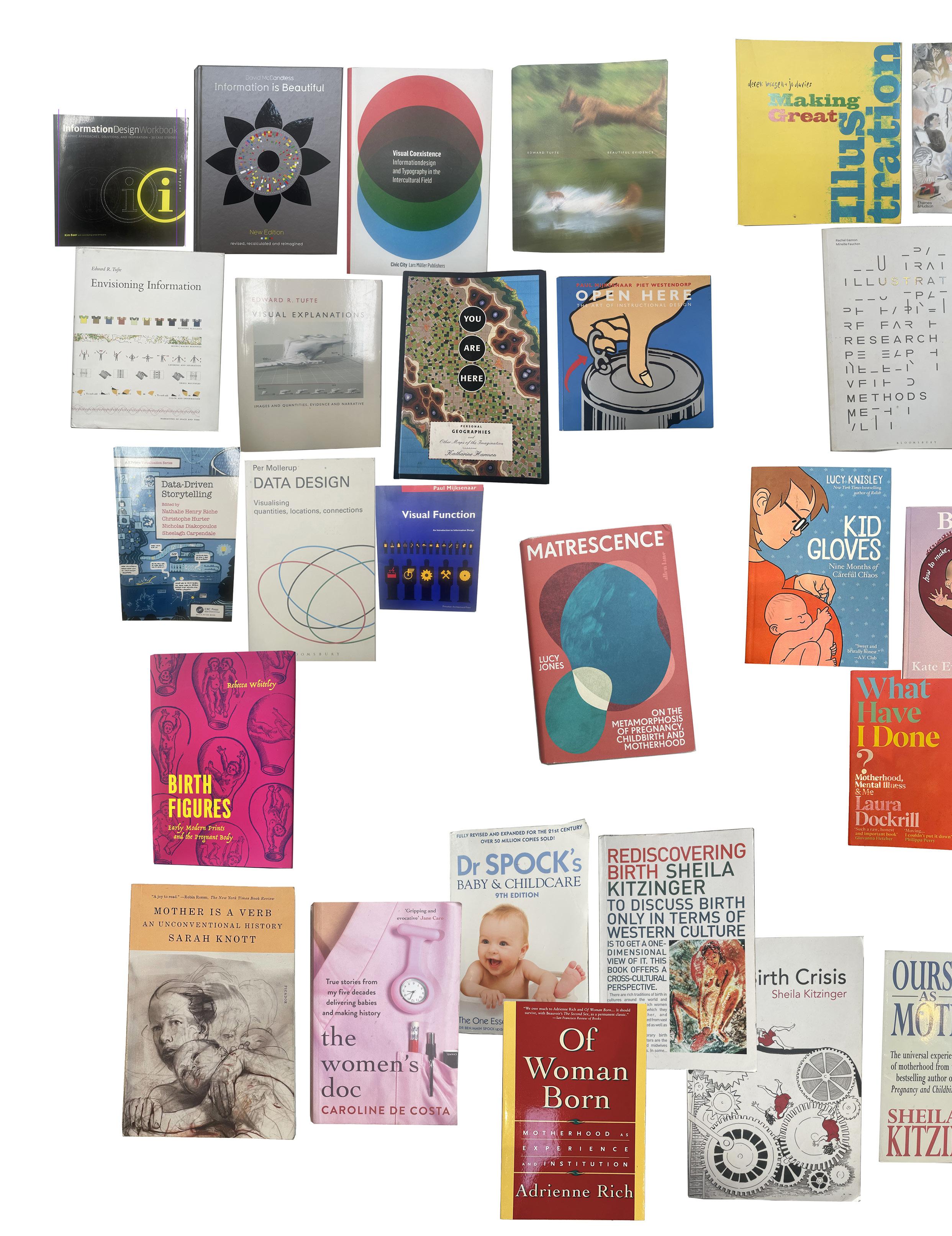
Literary Review books categorised into areas of interest.
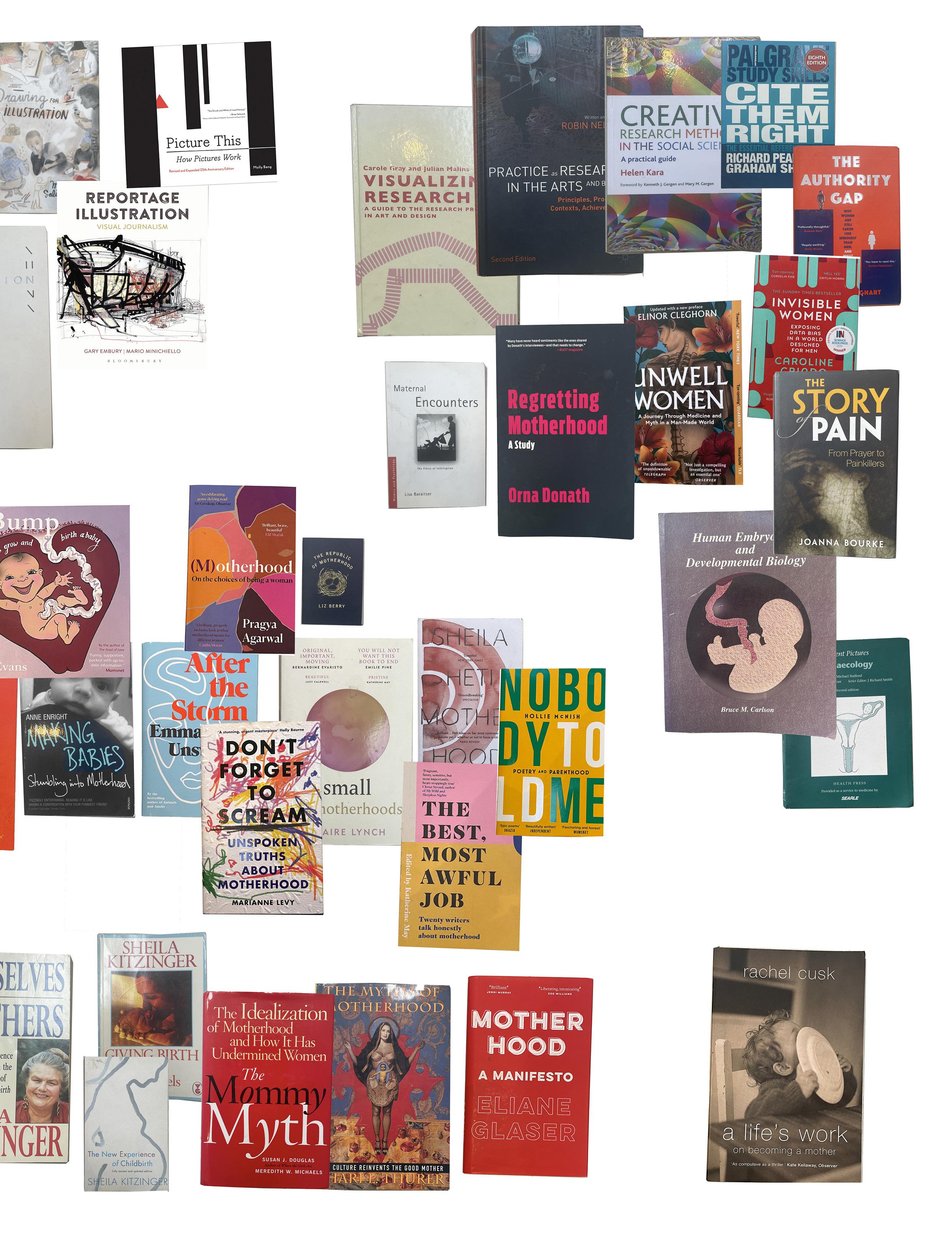
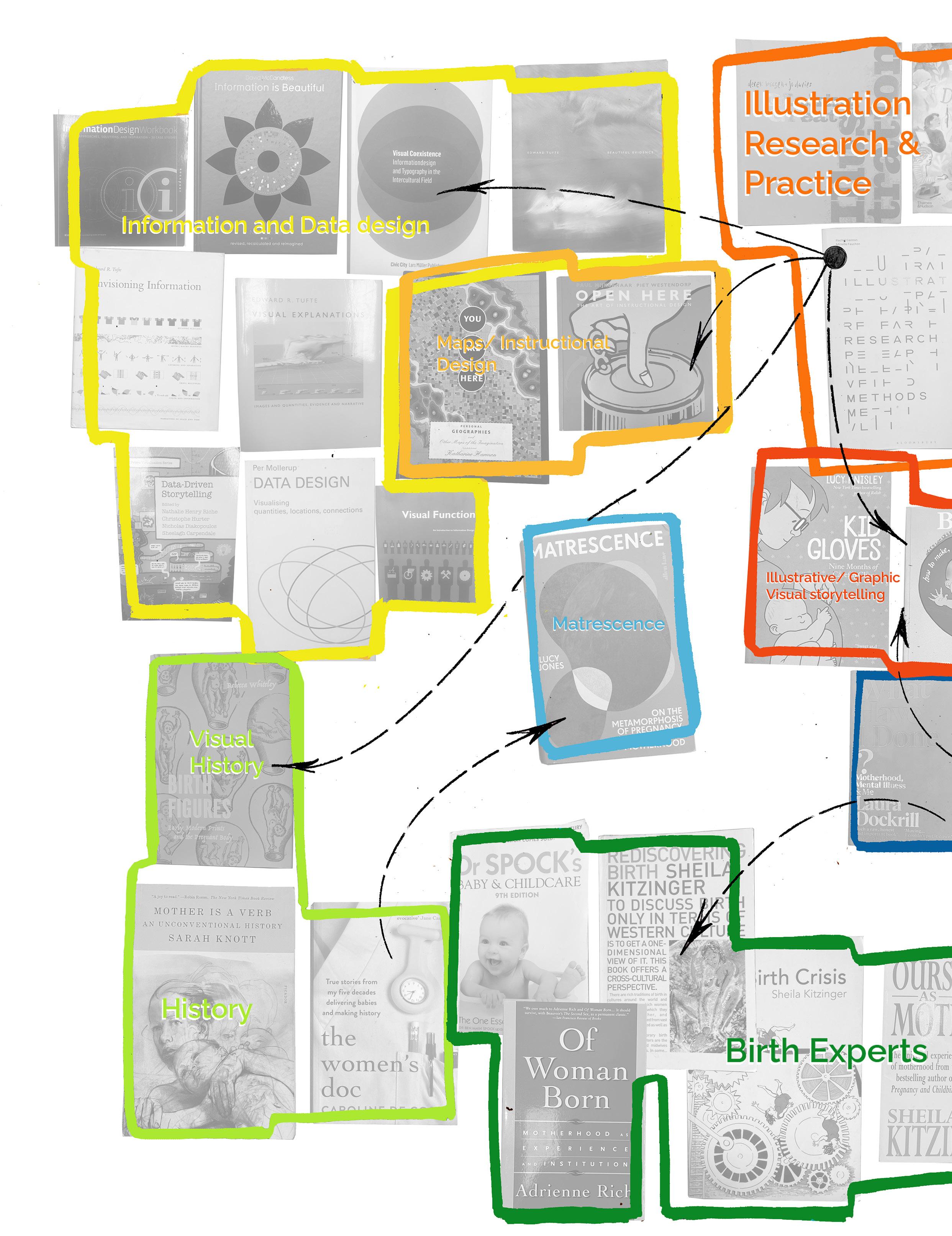
Starting point 4. Navigating and exploring the potential of Practice Based Research at PGR Level
Starting point 1. Illustration practice. 30 years experience of working as an illustrator, 28 years of pedagogy and academic experience.
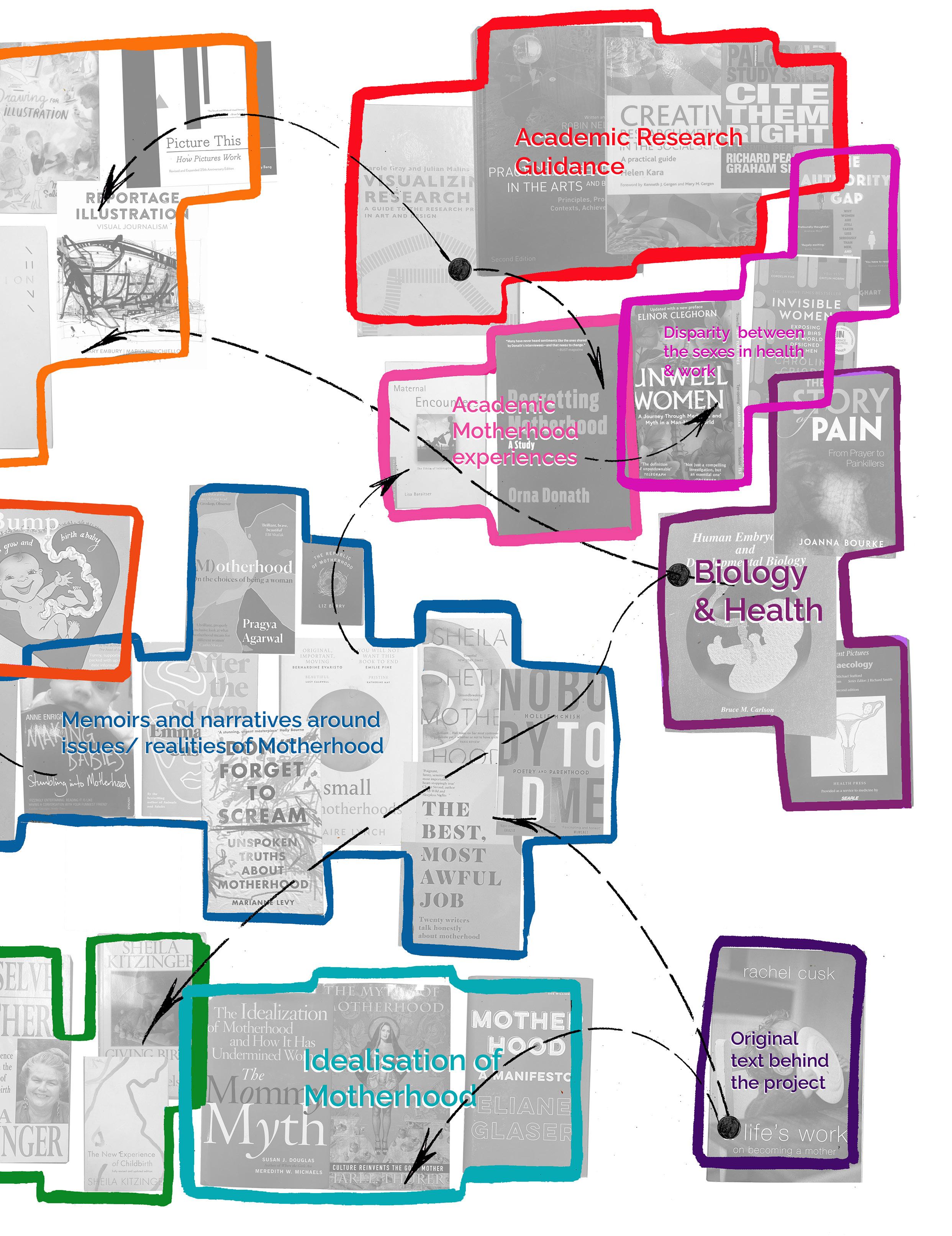
Starting point 2. Interest in the communication of health through Illustration practice
Starting point 3. Pre-Motherhood perception X Birth and experience
One Born Every Minute- Channel 4 https://www.channel4.com/programmes/one-born-everyminute
This is the longest-running series centred around stories of birth. ‘Every minute of every hour of every day- a baby is born in the UK’quite a phemonimal fact! One Born first aired in 2010 and ran for eight years. Forty cameras were rigged originally in the Southampton Maternity Unit. The programme starts with a woman wailing and cuts to several ladies all strapped to beds groaning, panting, screaming out in excruciating pain. They are supported by a range of male birth partners blowing up vinyl gloves, puffing on the gas and air or belittling their partners, saying,
‘OOOh you said you were going to do all naturally and now look at you- get me an eplidural.’ No vaginas are seen in this series. Women appear to have babies out of a blurred-out void between their legs, or a baby is lifted over a sheet from a C-Section, non-bloodied, sometimes a bit crumpled and occasionally needing a ‘bit of help’ for the first breath. The cry always evokes the same joy in the face of all parties.
The characters are formed as the series develops—the nun-like matron with endless cups of tea. The take-no-prisoners reception lady becomes a key figure and identity of the programme. There are water births where a lady has designed and made her own ‘bikini costume’ to birth in and to save
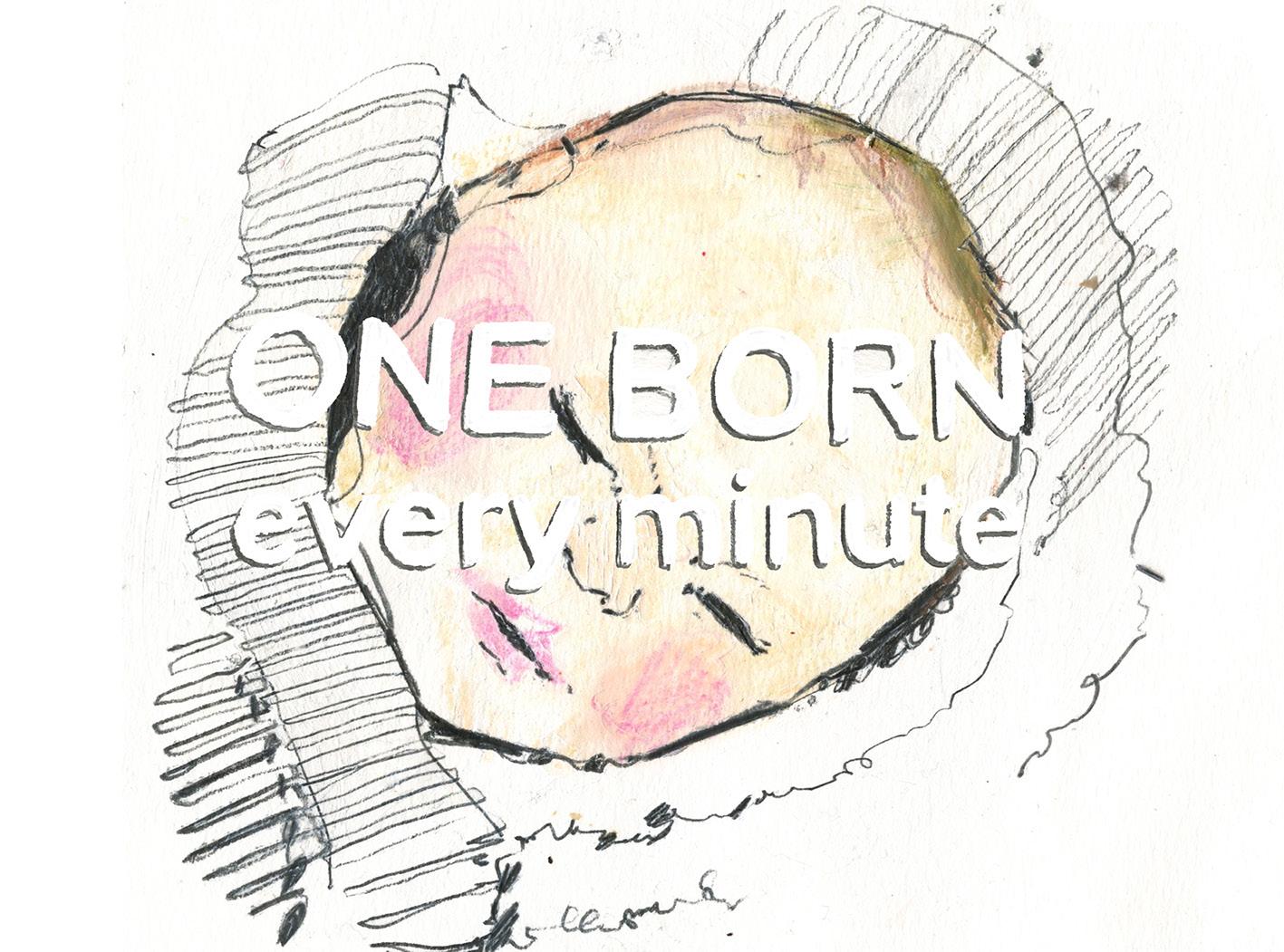
her any blushes. Throughout the series, the birth givers take a passive role; they are not walking around, changing positions or appearing to be listening and trusting their bodies. There is a considerable amount of shouting, PUUUUSSSHH! Come on, Come on- you have got to...The visual for this series shows a happy baby, cleaned, tucked up and swaddled. There is no reference to a mother giving birth or the staff who delivered it.
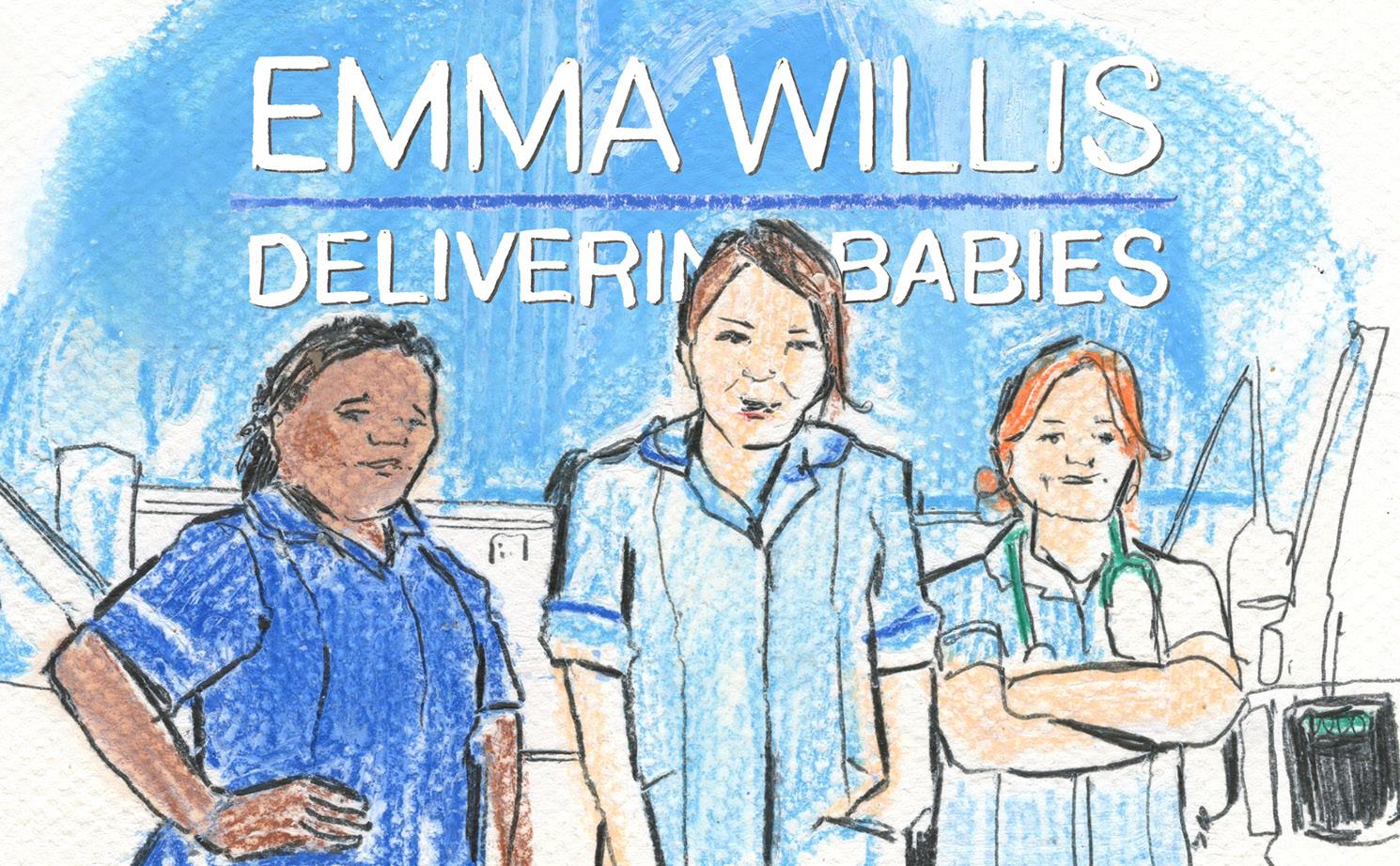
Emma Willis- Delivering Babies UKTV Play* https://uktvplay.co.uk/shows/emma-willis-delivering-babies/watch-online
Emma Willis is a presenter and host of popular prime-time shows such as The Voice. In awe of midwives, she invested seven hundred hours of training to become a midwifery assistant at Princess Alexandra NHS hospital in Essex. The premise of her programs is to show the
range of births that occur and that—as with this project—every birth is different, and the story is just that it is not your fault. The series shows actual births without the blurring filter rather than considered
camera angles avoiding views of vaginas. Caesarean sections are clearly shown with the sound of the muscles being pulled apart and the water and blood flowing out of the cavity.
Babies are shown in all the presentations in which they are born. Vermix, the greasy white protective covering, blood, meconium and floppy babies requiring help with breathing. She has hosted three series of programmes, where she is very hands-on in the day-to-day care in the role she has trained. One variation of the format is that she takes a recording of the birth to the
mother, who has not seen her birth but has experienced it as the birth giver. It i s fascinating to what was remembered and what was not the focus from the mothers’ perspectives. She reflects on her experiences with her three births, celebrating the skills and importance of those working in midwifery. The visual language of the cover image for the series is a slim and perky, slightly giddy-looking Emma Willis in between a larger set black health professional and a red-headed midwife, both with the classic ‘arm-folded’ stance looking quite stern.
24-Hour Baby Hospital Channel 4
https://www.channel4.com/programmes/24-hour-baby-hospital
The visual language of the landing page for this program is a whole team of eleven posed waiting as if to catch your baby as it flies out of you. You have a cohort of midwives, young and old, doctors, consultants, and possibly the receptionist. The fourth series, following the Rotunda, is in Dublin, one of the oldest maternity hospitals in Europe. A million babies have been born here, and 24 are delivered daily. The programme covers some challenging birth scenarios where all cast members
must see families through complex pregnancy narratives - not all with a happy ending. The babies have spina-bifida; one is born with a brain malformation which is not compatible with life. Other much-wanted babies are born after many miscarriages. The staff members are a credit to the NHS, showing warmth, compassion, and expertise when families are most vulnerable.
The show has a serious tone yet warmth, engaging the viewers in some of the medical roles that are not so explicit, for example, the role of a bereavement midwife and how she makes memories for a family who have delivered twins and will
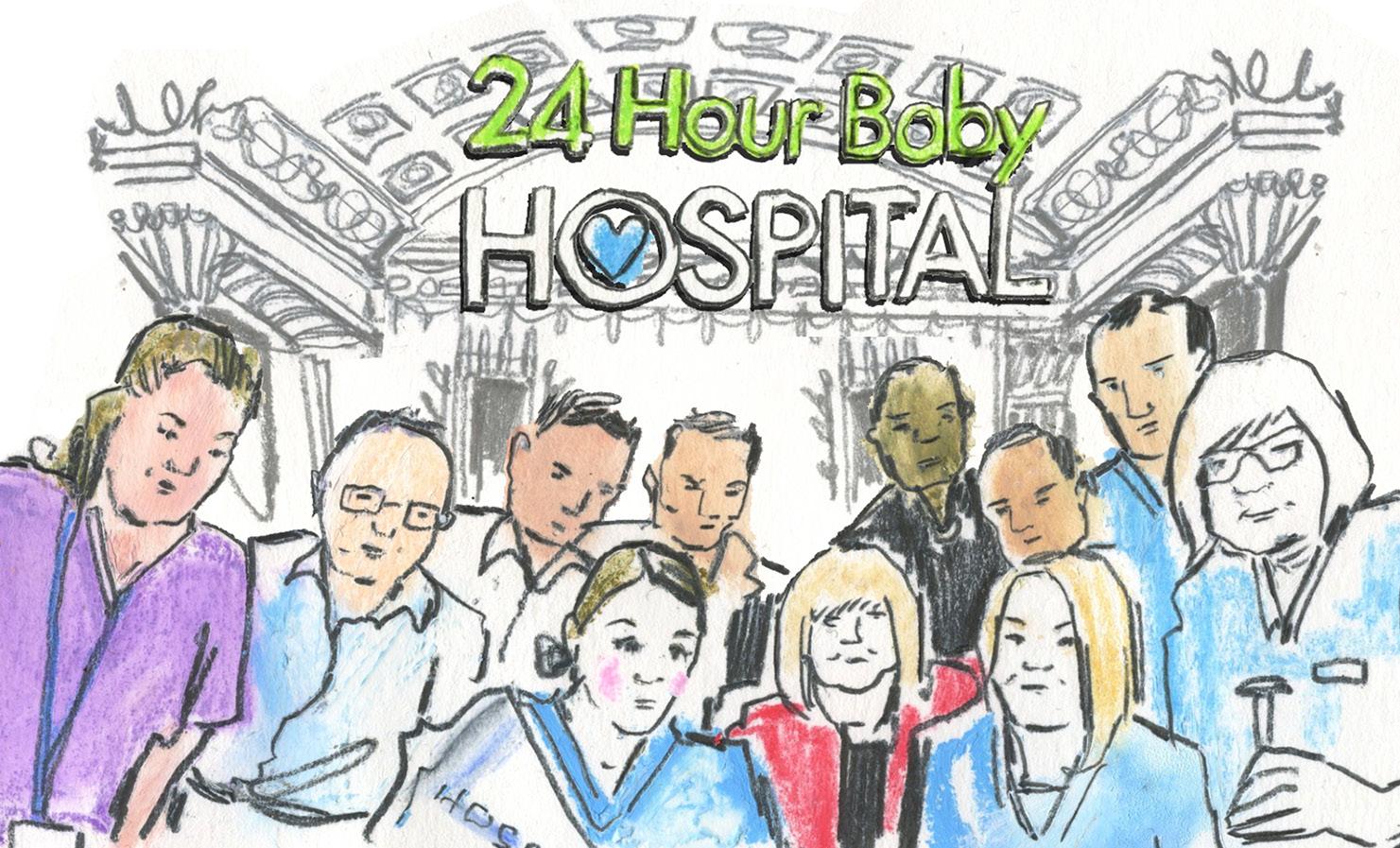
only be taking one home in 10 weeks. The range of characters and roles represents the plethora of expertise required to support the complex outcomes of the range of birth narratives at a particular hospital where specialisms and not the norm are the normality of the daily work delivered here at the unit.
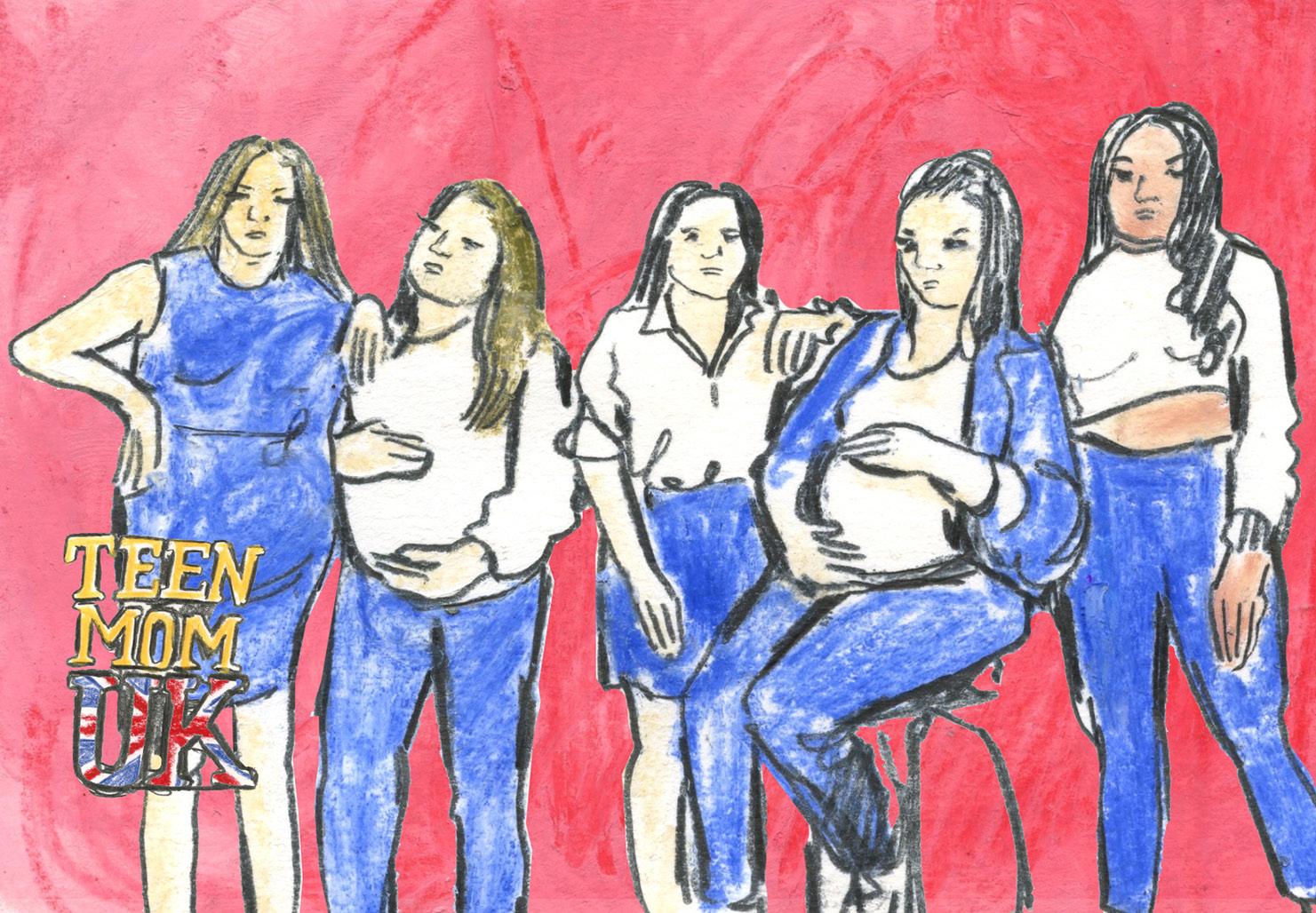
Teen Mom UK - MTV* https://www.mtv.co.uk/shows/teen-mum
This series follows the format of the American programme. The show presents each cast member at the latter stages of their pregnancy. Their birth experiences and early Motherhood experiences play out, focusing on the subsequent chaotic lives of five young women and their boyfriends, who drift in and out of their lives. The show airs on MTV, a youth channel whose audience is informed that being a ‘Teen Mom’
is not a walk in the park. The girls featured live across the country and have varying family support or disappointment levels. The consistent level of drama and shouting is exacerbated by the behaviour and cheating of the said boyfriends, who sire other children with other young women. Birthdays and celebrations of various milestones are prominent features in the cast’s lives, such as weight loss and gain, acne, and putting their children into various modelling opportunities. Money
issues, missing out on being at college with their previous peer group, and feeling left behind all pile on the pressure of characters who are followed through a mammoth nine series of episodes! Several girls go on to have more children, who all have a dummy in their mouths until they are four.
The cast look incredibly similar: long hair tresses, fake eyelashes and nails, crop tops and tight jeans- midriffs are plenty, pregnant or not. The programme is centred around the end of each series, where the cast is brought together to discuss their recent experiences. The host is very focused on how each character has not managed to become pregnant. One by one, each girl will coyly reveal that they ‘have been advised by their doctor’ to try the Mirena Coil. Due to this ‘wonder’ birth control method, they have dodged another teen pregnancy.
Teen Mom - is a convoluted advert for the giant pharmaceutical company Bayer, which manufactures the birth control IUD. I would like to know what Bayer and MTV paid these young women to have their lives plastered across media during these formative years and what the effect on their children will be to publicise baby and infant lives and behaviour. Teen Mom is morally dubious- even corrupt. The visual for this series shows a group of young women who may be in a bar or waiting for a bus, all dressed the same in front of a gaudy red background, with no reference to anything medical.

Desperate Midwives
08/09/2013, Really, 30 mins. https://learningonscreen. ac.uk/ondemand/index.php/prog/00533275?bcast=10107849
Desperate Midwives- one assumes the title is a taken variant from ‘Desperate Housewives.’ Show-offing and salacious it is not. The ten episodes navigate the viewer through a range of birth experiences from the midwife’s perspective, who puts on a reassuring, calm face to the parents they are delivering the baby. The often fraught communications with more senior colleagues, such as anaesthetists, are documented in a manner not seen before. The place holder page for each of this programmes highlights the anonymity of the female midwives featured. Their hands are wringing in a sense of heightened anxiety. The name badges are blurred. A range of stressful scenarios are presented, from emergency births to apprehension following a traumatic birth. The series aired in 2013, and it worryingly stands up to the same issues happening in another eleven years. The emotional landscape of childbirth - from both sides is candidly presented on the search engine BOB, Learning on Screen, which holds a wealth of televised content accessible through word searches. Keywords: Medical Sciences/Obstetrics/ Pregnancy / Gynaecology. 34.
Babies- Netflix*
https://www.netflix.com/title/80117833
Babies is a fascinating series on Netflix which seeks to take the lid off the perception that, as a baby, you are a passive blob watching life from the sidelines. The six episodes follow a theme at a time, ‘Love’. In the first episode, various science experts and academics talk the viewer through several experiments and studies whilst we follow the interaction between babies and their parents. It looks at the neurological and emotional effects being a parent has on both the infant and the baby’s carer. We learn how babies cope with stress when not engaged with a parent through cortisol levels. To understand how what we eat during pregnancy predisposes a baby to like sweet or savoury foods in the womb. Babies’ eyesight is developed only to focus on what is essential in not being long-distance and faces being the centre of the world to a baby, in trust and reassurance. The programme presents how you need to trust your baby to communicate with you as a parent and vice versa. The episodes show life from the perspective of both baby and carer and how language develops before they walk or crawl so they can become part of the larger complex world. We make sense of speech through audio intonations, pitch and pauses. The programme’s tone is science-led but through real families’ experiences in Europe and America. Parents reflect in awe of how their baby processes and progresses through the milestones from birth to toddler hood. All premises are presented as being backed up with research scenarios.
Rebecca Sachs is a brain and cognitive science professor at M.I.T. She features in BBC’s Child; She put herself through an M.I.R. scanner to capture the image of a Mother and baby’s brains when they look at each other. The imagery created is astonishing, with the connectivity and light and darkness of the two brains being ‘switched-on.’ ‘Babies’ is presented in an informative, non-slushy narratives. To engage with anyone. The visual identity of the programmes still shows a baby around nine months old wearing a hat to pick up neural activity in the brain. The hand reaching to the baby comforts the baby. No medical experts or maternity staff are shown.
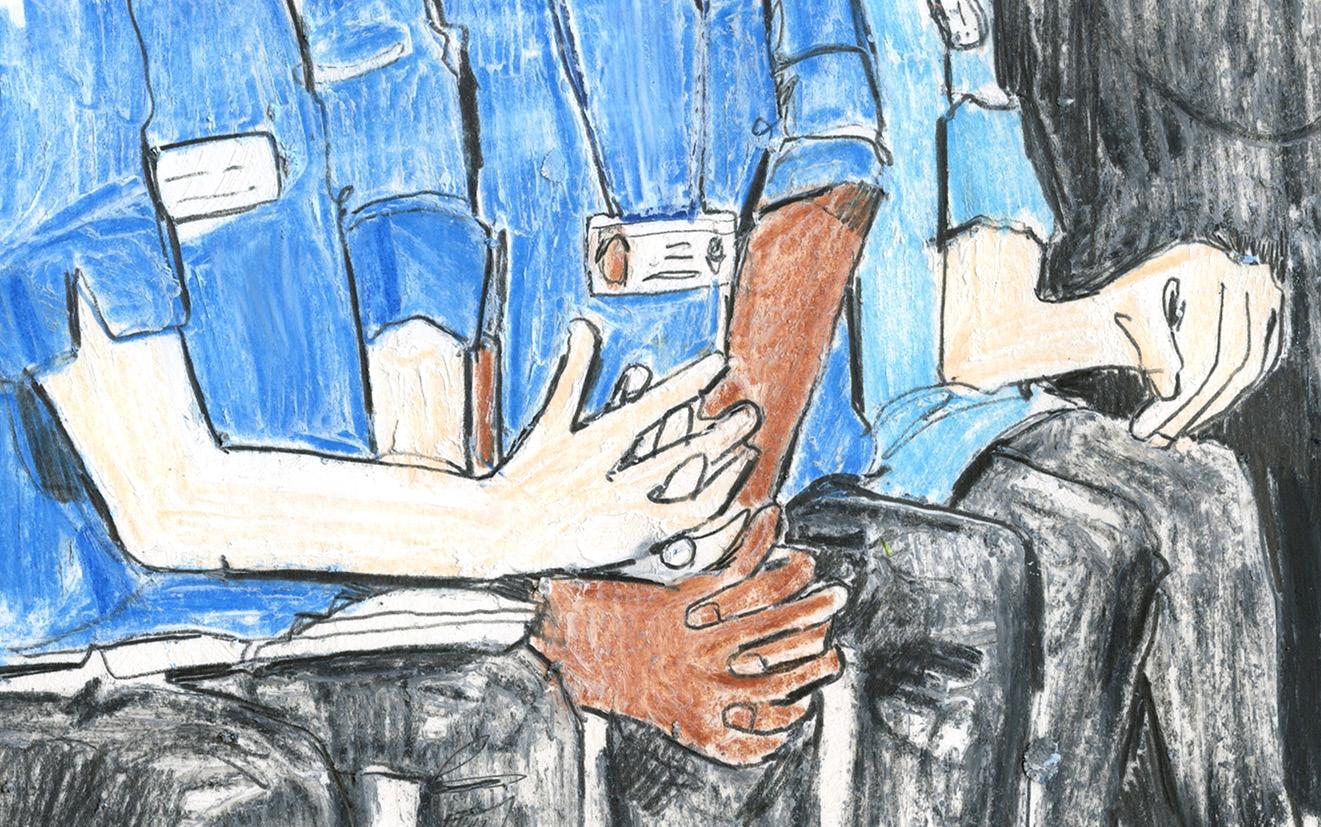
Belfast Midwives - Channel 4*
https://www.channel4.com/programmes/belfast-midwives
An all-female cast of midwives hosts it with pieces to camera to contextualise the birth scenario presented in each of the women’s cases. The midwives highlight that there is no normal birth, and each one is different; they deal with all of the more complex pregnancy narratives, multiple births. The premise of poo in labour is myth busted- 99% of women do this giving birth. As viewers, we are taken through various clinical and less clinical environments. Gestational diabetes is focused on the effects on both mothers and babies post-delivery, in terms of higher birth weights and low blood sugars. The prettiest and most chirpy character gets to hold the baby in the cover image to promote the series. The format is the same as other documentary birth programmes, with cameras catching all of the moments of downtime before the ‘actual’ birth action. The women presenting the programme discuss their and their family’s experiences in ‘piece to camera’ interviews. Unlike other programmes, they discuss the medical stages of changing monitoring as a baby’s head crowns. The staff offer women plenty of advocacy in skin-to-skin post-birth and prolonged chord clamping. The program includes Father’s supporting roles - or them looking nervously at their more stoic partners, or how they are encouraged to
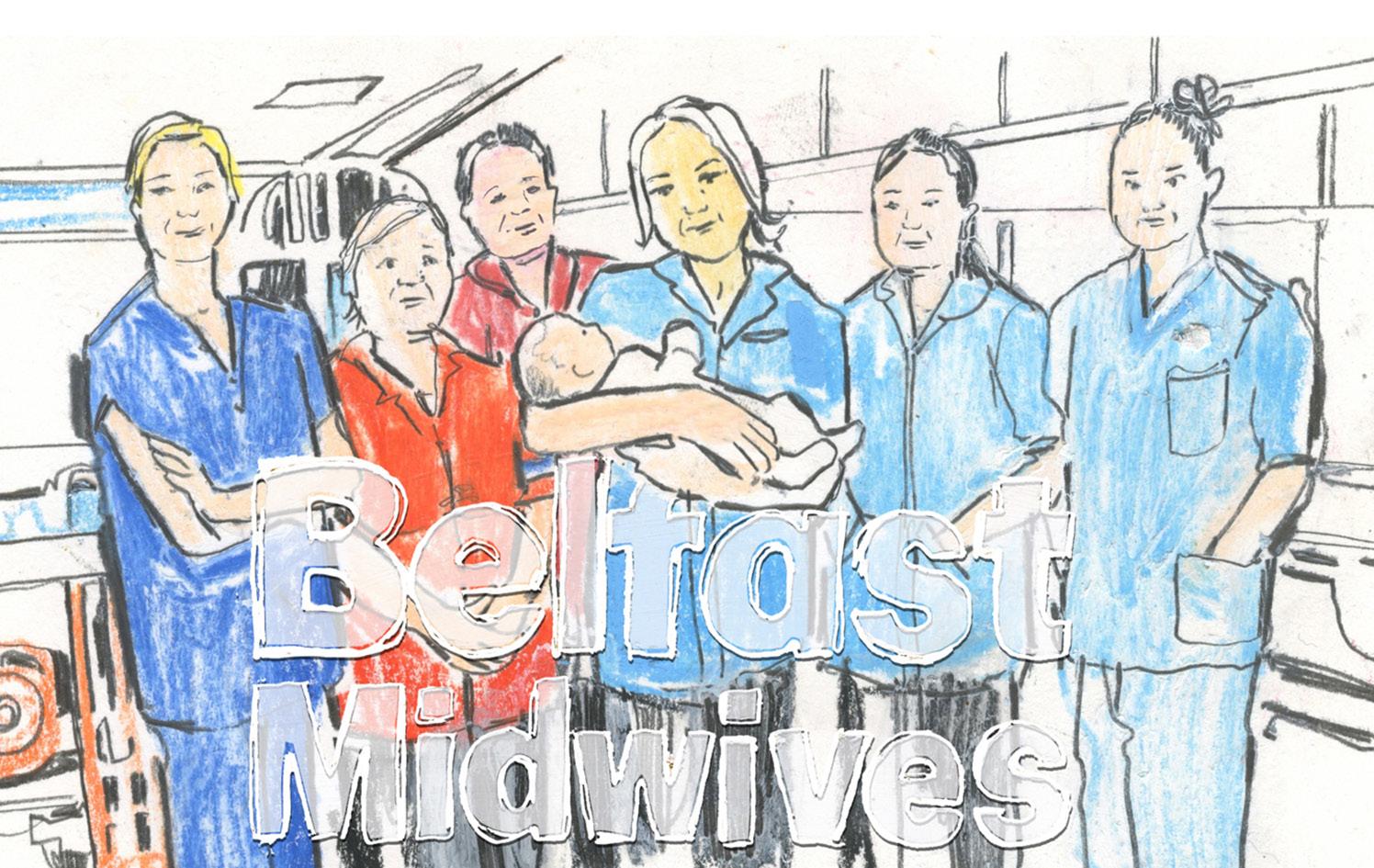
- go away and faint over there. Caesarian Sections are shown on camera, in the cutting of the skin, the pulling back of the delivery window, and the baby being lifted out. Clever camera work and editing avoid vaginas as babies are pushed out of birth canals. The subject of baby loss is sensitively covered, and the trepidation and anxiety of the subsequent births are handled with care and consideration. One
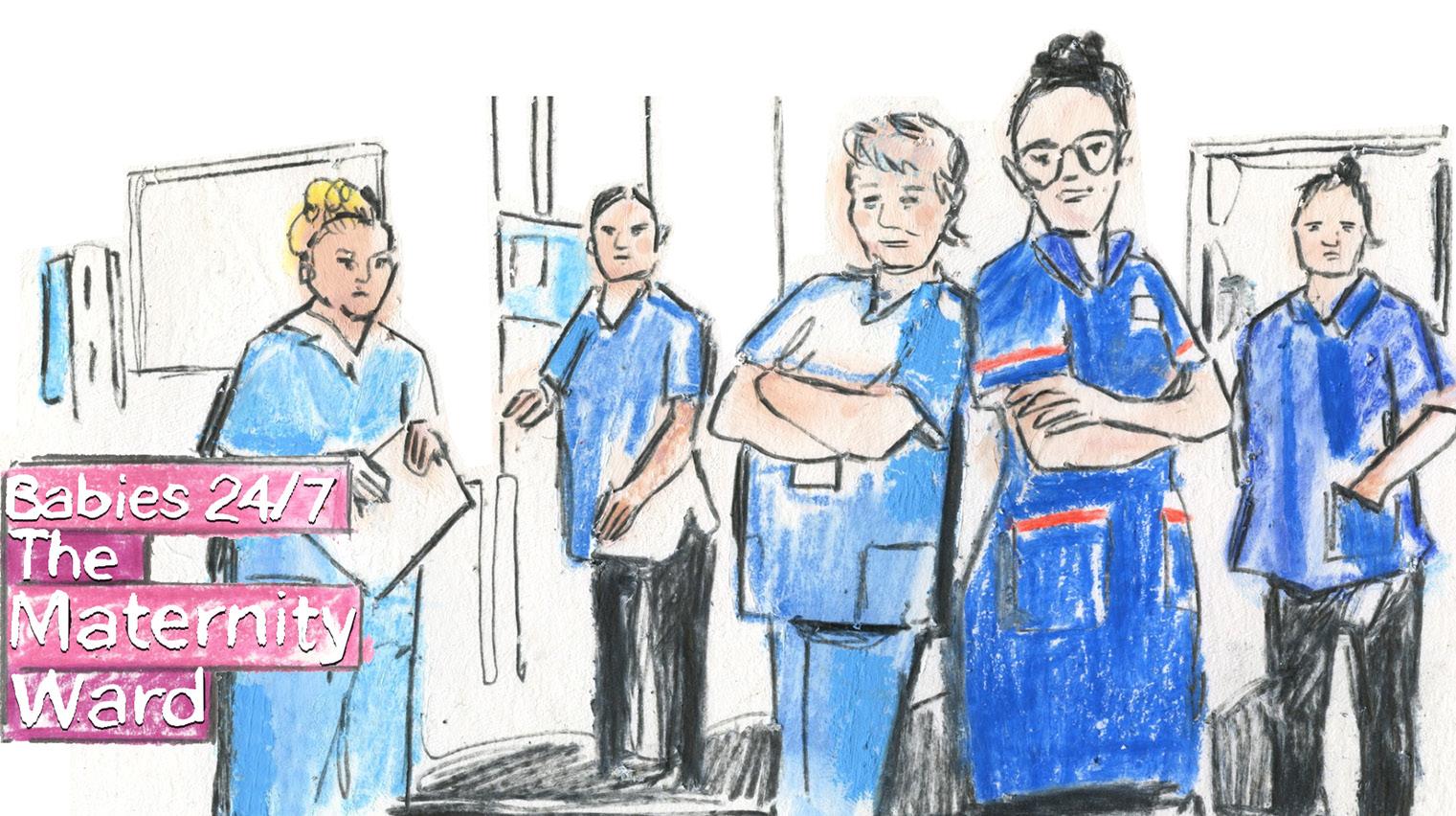
Babies 24/7 The Maternity Ward -Channel 5 https://www.channel5.com/show/maternity-ward
Babies 24/7 is based on one series—five episodes—at the Royal Preston Hospital, Lanarkshire. The unit has 300 staff and delivers 4,000 babies a year. The programme focuses on the midwives and follows an all-female team of strong, straight-talking Northern women. The premise seems to be pitched as the parents presenting the birth they are idealised on—no drugs, waterbirths, or hypnobirthing. The cameras follow the families to their appointments
of the midwives candidly talks about the death of her newborn as a young mother and how this led to her career choice. The series’ charm and success sit in the warmth of the characters and the genuine care and love they have for their women and supporting partners. Belfast Midwives is a fantastic advert for midwifery and the satisfaction of looking after women during their pregnancy and birth stories.
and their family homes. A lady with type one diabetes does not want a planned C-Section; her 37-week induction due to the size of her baby is brought forward to the next 48 hours. The term ‘perfect birth’ keeps being used, which I find troubling with this programme. The mother-in-law in a car warns that he may be put off for life sexually from his partner as he sees her giving birth. As the series progresses, we see other women’s birth choices scuppered when their bodies do not comply with the medical setting. We see a tiny premature baby sent to the neo-natal after an emergency delivery. The strange, almost ‘underwater’ world of the NICU, with its low lights, bleeps and pumps to keep the tiniest, most fragile hospital
patients alive. A sickening alarm sounds, which I found took me straight back to my daughter’s incubator’s side. It is a strange audio memory. The still of this programme presents the staff standing with their arms folded, back to back. What does this mean? Gateholders of information? Are they waiting for the next lady to come in and need them? The premise is that the women have their ideal birth plan or choice or preferences, and then they are ‘rescued’ by the ballsy staff so that their babies can be safely delivered. This iteration least convinces me of what birth looks like to pregnant women ; it feels like there is an agenda behind the format.
Life and Birth - BBC*
01:30 25/05/2020, BBC2 England, 60 mins. https://learningonscreen.ac.uk/ondemand/index.php/prog/160044EB?bcast=131995084 (Accessed 06 May 2024)
These six programmes -based in three of Birmingham’s busiest maternity units are framed in a traditional BBC - ‘Cover All Eventualities’ format; the programmes take us through many of a pregnancy’s major themes and concerns, where issues are picked up through routine scans. The documentary of each story is framed with interviews before the births and through text messages pinging back and forth from the wider families and the private thoughts of the parents, too. ‘Tonight will be our last night just as being boyfriend and girlfriend’ TOM. Send to his partner waiting to be induced. It covers a single parent awaiting the birth of a child who will be born with Down’s syndrome. A mother is awaiting her fifth birth, twin birth, as always, people of the gas and air who are not birthing a baby. A premature birth is where you know that the baby is your baby, but as they are in the Neo-Natal ICU, you feel that you are holding your breath and your baby is not in your arms. Their existence is in the hands of the staff. Dad talks candidly about how he ‘has to be strong’ for his partner, his older children and the tiny 2-pound baby that needed to double her birth weight. The yoga teacher feels being framed as being unrealistic with her natural birth choice, which inevitably goes from her not coping with the pain to needing an emergency C-Section. Vaginas are blurred out as babies pass
through them, but babies are held aloft in the range of colours they come out in, some pink and angry, some floppy and bluey grey -rubbed to be ‘pinked’ up. It is a good, wholesome BBC effort covering many bases in this series. The visual for this series shows a couple looking relieved after the arrival of their baby. As viewers, the image feels as if we have entered an intimate moment of two people becoming three, and the sheer relief of their baby’s safe delivery is evident in their faces and body language. The type seems to sit uncomfortably on the image. The title’s visual language could be associated with MTV or a programme less authoritative than the BBC.
Theo Clarke
‘It was the most terrifying experience of my life- I genuinely thought that I was going to die.’ Clarke begins her address to parliament for the first time in history that the subject of birth trauma is presented. Clake talks about her own horrific birth experience whilst just about holding back her tears. The Birth Trauma Inquiry was launched following her address.
The Inquiry objectives are to:
1. Identify common features in maternity care (antenatally, during labour and birth, and postnatally) that contribute to birth trauma.
2. Highlight examples of good practice, both in the quality of maternity care and in providing support to women who have had traumatic birth experiences.
3. Look at the impact of birth trauma on women’s relationships, ability to bond with their baby and future decision-making (e.g. whether to have another baby, whether to return to work).
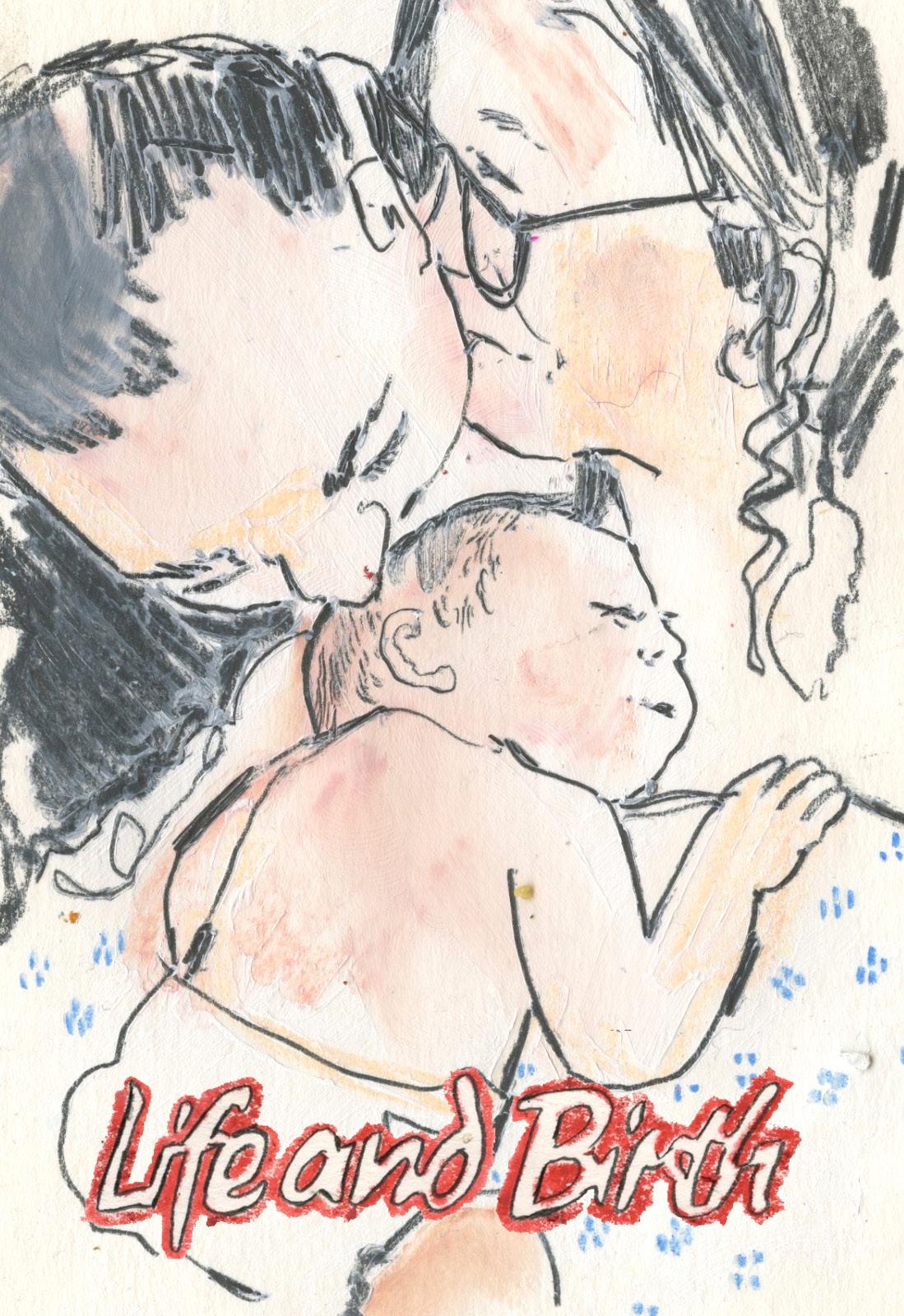
4. Find out whether current postnatal services to diagnose and treat women’s physical and mental health problems are up to scratch. This would include, for example, looking at whether severe obstetric tears are being diagnosed promptly, whether mental health problems are being identified at the six-to-eight-week check, and whether perinatal mental health teams are accepting and treating women within an appropriate time frame.
5. Develop parameters for understanding the possible economic cost of birth trauma to inform future research.
6. Influence government policy by identifying areas where maternity care could be improved to minimise birth trauma and by highlighting ways in which postnatal support can be optimised to meet women’s physical and psychological needs after traumatic birth.
Sadly, this image shows only a limited number of political faces at the bill’s presentation.
https://www.theo-clarke.org.uk/birth-trauma
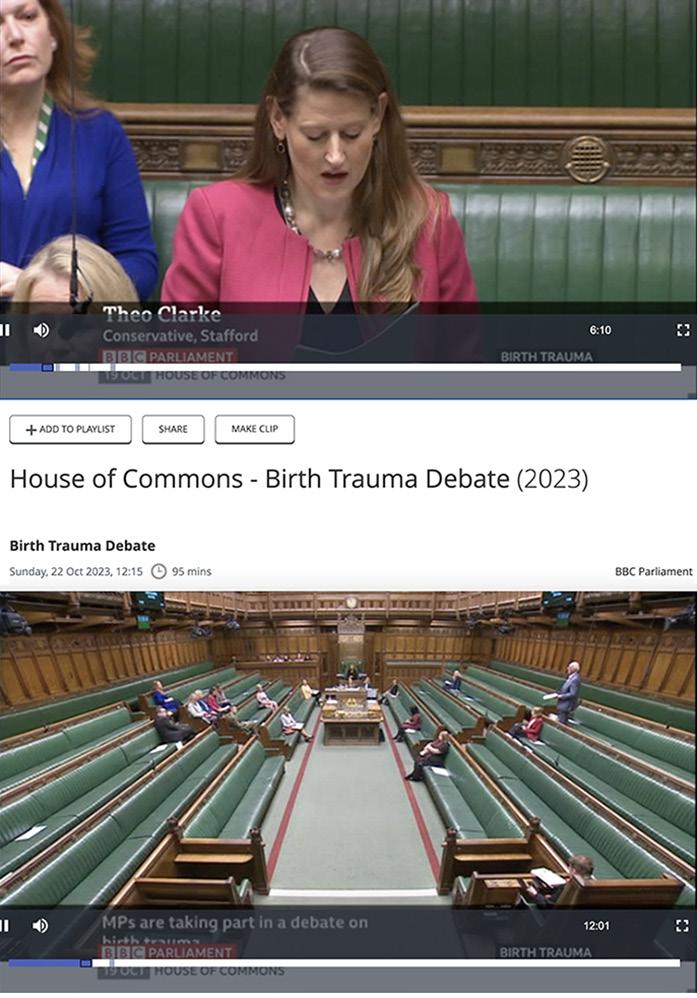
‘Sensitive content is anything that may cause offence to a reader, particularly in relation to religion, race, gender, politics, sexuality, disability, or with regard to language that is considered obscene, vulgar, or taboo.’
Flor Cruz, aka -BadassMotherBirther, is a passionate advocate for birth - predominantly non-interventional birth. Her Instagram has millions of followers, where she shares images and videos of women in the emergent stage of labour as a baby’s head is crowning and being born, followed by shoulders and a usual swift exit of a little body with closed eyes and splayed hands. Above are examples of pages of her thread, mainly covered with the crossedthough eye symbol and Instagram’s ‘sensitive content- This video contains content that some people may find upsetting. From the first page, we have five of the eight posts covered; the open ones show a baby sucking its thumb- its Mother is actually feeding it, but the hand obscures
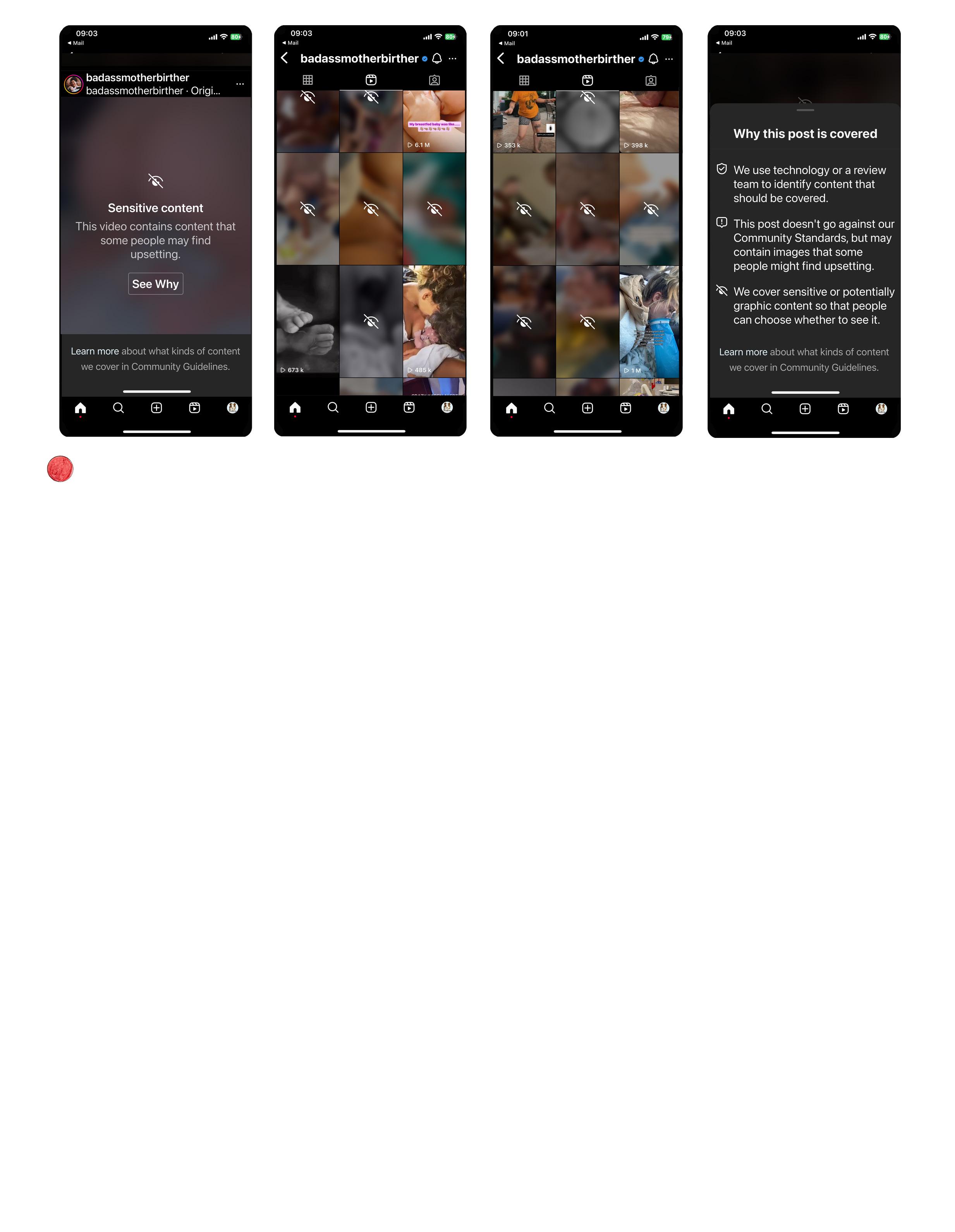
the nipple, some dainty newborn feet and tops of a mother and father’s head over their new baby’s face. On page two, we see a woman dancing, an indistinguishable image and a woman being sick in a bag designed for someone who knows her way around hyperemesis gravidarum. The rest of the pictures and videos are obscured. What are we looking at here? Are we experiencing being protected from the worst, most offensive images that can’t be unseen? Are these photos and videos violent- a sexual assault or torture? Are they hardcore porn material? The images and films are of babies coming into the world through vaginas. Most of these films are beautiful examples of women taking control of their bodies and allowing the oxytocin hormones to control the uterine contractions and push the baby out in a beautiful, calm way. Often, as the baby descends, the vagina could be compared to a flower opening, the membranes rupture
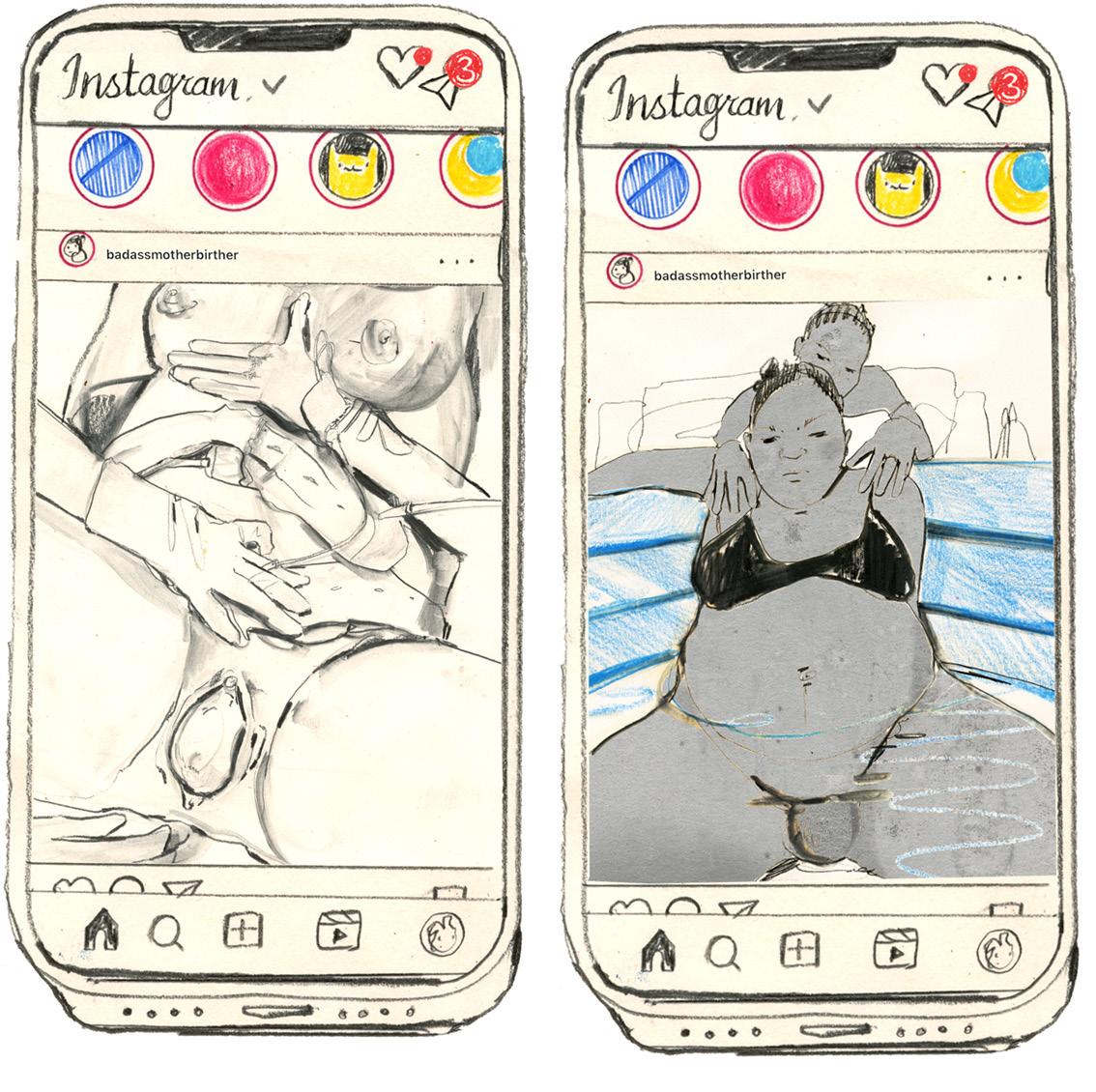
- or waters break to aid the fluidity of the process. The babies appear sometimes bloody, sometimes looking waxy, with a thick layer of white substance over them. What does the ‘offensive’ symbol mean to us when we see it? It feels like an external judgment being foisted on female consciousness and bodies. Showing a vaginal birth to be wrong and overtly rude. It is shaming in the language of the images being considered ‘obscene, offensive and vulgar.’ There is colossal hypocrisy in the search for imagery of women’s vaginas with an array of objects penetrating them -and these images are not deemed as offensive as they sit under the umbrella of pornography,
‘Instagram and Facebook ban posts on women’s health as pornographic’-the title of Rosie Taylor and Eleanor HaywardThe Times Newspaper Health Editor. On Friday, 23rd February 2024, a report was published highlighting how social media sites provide public information regarding women’s sexual and reproductive health as perceived as ‘pornographic’ or as ‘prostitution.’ The organisation campaigning on behalf of women called ‘CensHERship’ report that “Censoring women’s health content on social media perpetuates the idea that female anatomy is shameful and should be hidden away. Too many women are not talking about gynaecological health conditions due to perceived shame and stigma and are thus deferred from seeking the help they need. Using anatomical terms and imagery to provide accurate health information is fundamental to helping women advocate for their health and get the care they need.’
Who judges these images of birth in the most ‘natural’ of states or settings and as a time-based example of how a baby leaves its Mother’s body in a way that feels shameful, distasteful and wrong? Not to be presented as joyful, celebratory and the most significant physical achievement most people can ever be more proud of.
Reflections from the Literary Review
The research for the ‘Birth Stories project has developed from bringing together many interests, experiences and concerns within my creative, educational and parental practice. With resources into maternity services at a critical point, as investigations into failings in the care of women and babies in the news, and from listening to the voices of staff at Kingston Hospital and women spoken to who have recently accessed maternity services and the literary review from the first two years of part-time study, I feel the relevance and need to articulate visuals that promote choice and confidence to birthing Mothers is timely and essential.
The process of categorising the books into themes and identifying four specific starting points within the literary review has enabled me to contextualise the journey, and the field of information documents the voices within the field of study. The research narrative is established from Rachel Cusk’s book, A Life’s Work, which led to the reading of many memoirs, iterations, and documentation of Motherhood. Besides books, there are other sections in this literary review; I have explored programs representing different T.V. company channels and researched aspects of birth through podcasts, news articles and social media presentations. I have aimed to establish and understand what they are showing. How explicit are the visual language and birth narratives they present? What is the tone of the written and visual language and narratives?
I have created a map of the books I’ve read and reviewed, almost sixty in this academic time period. In 2005, I read Rachel Cusk’s ‘A Life’s Work. ‘ I was pregnant at the time, and I was appalled- how could a Mother sound so disingenuous? She should feel blessed to have a child. She had two children very close together, and Cusk was brutally honest about the fact that she found it a complete slog, utterly unforgiving; she lost herself as a creative person and was honest and scathed for it.
I became aware of the range of maternal memoirs, which became more evident from 2018 onwards. Through an established interest in birth narratives following my own experience of miscarriage, pregnancy and birth. The titles that came out included ‘Best Most Awful Job,’ ‘The Eye of the Storm,’ and ‘Nobody Told Me.’ Many of these women writing had columns and voices in other spaces, so whether they were science writers or worked as columnists, they wrote honestly and candidly about their experience of how we are lied to in terms of, ‘you can have it all -and it’s all fantastic.’ The premise of having a baby is a breeze, and you will have no issues contextualising what has happened to you in body and mind and other senses.
‘I felt a sudden lack of any positive image for my body after it did one of the most amazing- and gruesome- things it ever will. I’m sure that if anybody went through the process of giving birth, whether vaginal or caesarean, for any reason other than to have a baby, then the after care would be treated with much more funded seriousness.’1
It isn’t easy with all the different expectations of you as a pregnant person and new Mother. It’s become more complex since social media exists in your curation and representation of yourself externally or even in your relationship with ‘audience’, even your partner or your health visitor, often with this fear of ‘if I say how I feel, I will be judged as not coping well,’ ‘I am not good at this, and the worst case scenario- this baby could be taken off me.
Information ‘gatekeeping’ is very troubling- in the form of many books about Motherhood, ‘What to Expect Whilst You’re Expecting,’ and texts by writers such as Gina Ford. (Who turns out never was a Mother.) I continued to explore this idealisation of Motherhood. The examples I have included in this review have been more about American Motherhood, looking at Western culture and this idealisation of comparison to everything you are expected to have, or you expect to have everything until it all falls apart - or appears so and then you have failed.
‘Media images of happy, fulfilled Mothers, and the onslaught of advice from experts, have only added to Mother’s feelings of inadequacy, guilt, and anxiety. Mother’s today to an ideal that can never be reached but somehow discarded.’2
The second research starting point I’ve always identified with is understanding biology and health through illustration practice, which came at the end of my degree. And it was my M.A., which explored how we describe different things happening within our body. I could have included more of these, as I have referred to eight, looking at how biology in health is represented visually by people working in health. So an example is Catherine Gale, who recommended the gynaecology book in this section, which is entirely linear. It has no emotive qualities and sits in a purely diagrammatic explanatory language. The embryology book is specifically for the medical market and provides many distressing scenarios and images of what can and does go wrong. Within the more academic text sits ‘The Story of Pain by Joanna Bourke,’ there’s little research done within this field; this book’s incredibly complex pain in its often invisible form is tied up with social, religious, hierarchal, gendered and ethical considerations.
‘Labour was God’s punishment for Eve’s sin, and his rod of correction meted out pains to be patiently borne.’3
The third research strand looks at illustration research, and as part of my job as an academic, someone who delivered Level 6 for several years and worked as a documentary illustrator. How does documentary illustration work regarding different experiences, and how does that differ from the camera being held up to an audience?
Illustration is a unique applied design form where the artist’s voice has an innate ability to connect with an intended audience through the focus and the language adopted by the creative to ‘talk’ their audience through a hierarchy of information and tone of voice. Rachel Gannon’s and Mirelle Fauchon’s book, Illustration Research Methods, is one of the first to take illustration academic practice seriously. It articulates that illustration is more than just there to ‘titillate’ and ‘illustrate’ regarding methodology and focus. It shows the importance of the required rigour to tell stories and narratives different from our own. How do you put information into the public realm that needs to be understood without the spoken or written word through imagery and various mediums?
We exist in a culture and society saturated by imagery, whether specialist or generalist; it is unavoidable unless you choose to live off the grid. The plethora of written, visual, data, and audio information can cause many issues when expecting a baby and preparing for its birth. This information can be directive or procedural, educational or factual, conceptual, situational or based in a new and not experienced place- which can change suddenly depending on the birth story.
‘Contemporary commentary fixates on a diet. Avoid alcohol, coffee, tea, seafood and cheese. The expertise vastly outweighs the evidence. But until well into the twentieth century, the primary concern had more to do with experiences.’ 4
During the first full academic year of research for this project, I have unpacked the visual language and content of two memoirs—Kid Gloves by Lucy Kinsley and Bump by Kate Evans. I’m presenting this paper as a poster at the July Graphic Narrative Conference held in Ireland as two examples of when narrative goes as expected or when things don’t, as well as from an illustrative storyteller’s biographical and autobiographical perspective. How do we understand these pictorial forms? Does a visual exploration provide a sense of ease and reassurance? Does it encourage a notion of jeopardy or peril? It may tell us how to navigate an action through a one-, two-or three-step explanatory system. So, as illustration researchers, we are responsible for using a skill set to explain complex things that are challenging to understand.
Acknowledging personal and lived experiences from memoirs and professional experiences is essential for communication concerning birth. Sheila Kitziner is a crucial example of someone I perceived as a birth warrior; as a pregnant woman, aware of her work, I turned away from reading her opinions on birth and Motherhood, finding them too daunting and leftfield. Her vast experience of looking at this ‘industry’ of how we see birth through a Western cultural lens is fascinating, so far from my research perspective, in this
language or in this very timed event. Suppose your body isn’t allowed the time to do what it needs to in the allotted time frame? In that case, there are many different interactions and interventions: if your body isn’t allowed to do it, in your own body’s terms, you are put on a seemingly quick conveyor belt. If you don’t agree with the interventions, the language can become pointed at you as a birthing woman as being difficult or to encourage a danger to your baby.
‘For many women, induction of labour represents in an acute way the complete loss of control over birth giving. Once that happens, all other interventions are further evidence of being on the receiving end of care. Women are often persuaded to consent. The obstetrician says, ‘You don’t want to lose your baby, do you?’5
As a first birth experience, like 46% of first births, I was ‘induced’, having no knowledge and understanding of what that meant. Now, Kingston’s Maternity Services website explains the process of induction. However, it needs to explain how long this can take and what happens to your body visually. Again, it’s all presented in the form of words. The ‘illustrations’ are happy women cradling swollen tummies in pastel colours or sitting with a healthy newborn, looking glowing and not broken by the birth experience.
Kingston’s maternity unit is one of the hospitals I’m working with to realise this project. The other space is West Middlesex maternity service- Queen Charlotte Hospital, which has different demographics of women who access its services, so it has different stakeholders. Kingston is more middle-class but also serves large social housing demographics, a large Polish community, and the largest Korean community outside South Korea. Middlesex has a different demographic in a broader Muslim and women as second language speakers, so there’s a broad demographic in each culture, and each has its idea of birth and pregnancy. Culturally, as a Muslim, when you have a baby, you do not do anything apart from be with that baby for 40 days; your family comes in and does everything, cooking, cleaning and looking after older siblings.
In the U.K., I believe this is an issue in that you’re expected to have this baby and look and feel great and not have any connotations with the grappling reality of, oh God, what have I just done to the rest of my life? I have ruined my career and gone from being relatively in control of my life to not understanding the free fall I find myself in. I remember mourning that I would never be able to mow the lawn again as I would never have the time again, which is seemingly hilarious in retrospect.
From the literary review - books including Matresence by Lucy Jones and to the extent of Adrienne Rich’s seminal text ‘Of Woman Born,’ written forty-plus years ago, we are not being allowed to acknowledge that we need to feel supported.
There is enormous social pressure to ‘just get on with it,’ but to get on with it by looking, feeling, and being fabulous! That’s how I felt as a new parent- from the experience of speaking to other women who had children the same age as myself, it has taken them fifteen years to talk about their anxieties about pregnancy, birth and postpartum stages of pressure and heightened anxiety.
‘Forty-one hours in, I was placed in various positions to harness the force of gravity: all fours, kneeling, and, finally, lying on my side with one leg on a midwife’s shoulder because by then, I couldn’t hold myself up. I was at my most feral and primitive. I wanted to burn the hypno birthing industry to the ground.’ 6
I have begun to explore the history and recording of birth, and it is presented from a male patriarchal perspective. In the 16th century, male physicians began to inhabit what was a female-only space for women giving birth. Male Doctors saw it as a money-making practice and took up the first forms of the General Practitioner (G.P.) William Smellie was one of the first and most prominent male or ‘man midwives.’ He practised in London from 1737 after studying midwifery in Paris. He designed a new and improved version of delivery forceps (which have changed very little since.) Smellie kept detailed notes from his practice forming the basis of his published ‘A Treatise of the Theory and Practice of Midwifery.’ Often referred to as ‘The Father of British Midwifery. Smellie was highly respected and trained around a thousand students, with his practice being scientific, granting free deliveries for women as part of his lectures so his students could observe the birthing process. Female midwives were opposed to his work, deeming it inappropriate for men to assist women in childbirth. William Hunter studied under Smellie; his career led to him becoming Smellie’s competitor and the leading obstetric consultant in London. He became Queen Charlotte’s physician, and in 1768, he built an anatomy theatre in Soho to teach dissection. His brother, John Hunter, honed his anatomy and dissection skills from William, amassing a collection of thousands of specimens that he preserved from animals and humans housed in the Huntarian Museum in the Royal College of Surgeons. Drawings of the foetal collection held there are included in Reader No. 4.
Shari L. Thurer, a writer and psychologist, in ‘The Myths of Motherhood’ and Lucy Jones in ‘Matrescence’- write about the effect Industrialisation had on Motherhood in raising ‘healthy children for the workforce.’ Male voices as experts on being a good Mother were published with alarming advice. Luther Emmett Holt wrote that a baby under six months should not be engaged with any form of play as it makes them ‘Nervous and irritated.’ Truby King, author of ‘Feeding and Care of Baby,’ stipulated that cuddles must be limited to ‘no more than ten minutes a day.’

Quite bizarre advice given from non-primary care giving male academics! In 1940, Dr. Spock wrote which sold more books than the Bible in America. The longest-running mother/ parenthood book takes the reader through pregnancy and the child’s going off to university. This book encourages parents to hold, cuddle and interact with their babies. Due to the first published window, the business of being a Mother is set in the home, and as an idealised 1950s housewife, looking after your husband and children, thankfully, an outdated notion that we only exist to keep populating the planet.
*(note look at the ‘Centuries of Childhhod’- Phillipe Ariés)
Reflections Cont- Literary Review
The recently published ‘Birth Figures: Early Modern Prints and the Pregnant Body’ by Rebecca Whiteley is an excellent historical record of what pregnancy could have looked like throughout the ages when you couldn’t see through a person. It includes wonderfully bizarre drawings of representations of the fetus as a stout middle-aged man dancing through the form of a light bulb in woodcut form from Martin Caldenbach 1515. Later plates include the engraved visceral and meaty dissected examples - referenced from a cadaver by Jan van Rymsdyk -1774 from William Hunters’ collection illustrating ‘The Anatomy of the Human Gravid Uterus. This group of books refers to Motherhood’s history, ‘Mother is a Verb,’ by Sarah Knott, published in 2020, articulates the history of the presentation of Motherhood to Mothers. Ideally, much more about the history of Motherhood still needed to be written by women and for women.
Feedback from my Annual Monitoring Review focussed on the importance of reading and researching deeper into design theory as a person who considers oneself literate in design and design communication. I have revisited some key texts of design thinking, the suite of Tufte books at Civic City, and other data communicators, including Mona Chalabi. She is a fascinating example of a female information designer; she takes the bizarre, dull and complex and presents it back to her audience with humour and an expendable felt-pen quality, encouraging us to think
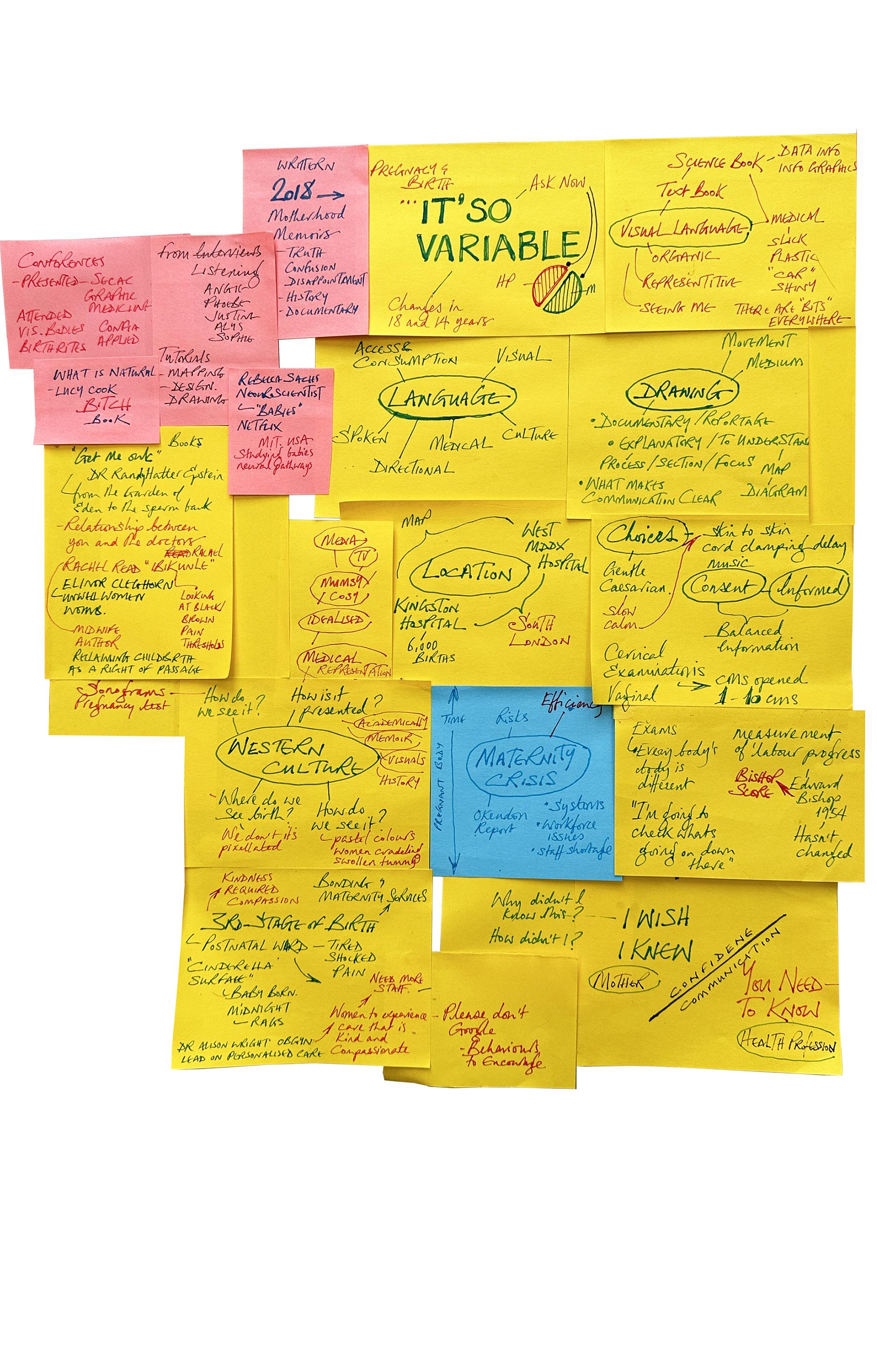
- ‘of course it looks like that’ though her ideas an iteration of the subjects.
I have returned to books that have been my go-to texts in teaching for 20 years: Katherine Harmon’s You’re Here. How can the map form challenge and illustrate a task or a phenomenon? It is not just a location but also how emotional timebased activities or landscapes can be explored through maps and mapping. I am following up on the consideration of instructional and information design. How do we understand nuances of actions and instructions when interacting with objects and experiences? Many examples of successful instructional design cross language barriers.
The illustrated readers have enabled me to track the beginning of the creative processes undertaken within the past two part-time years of the research. Writing this reflection on the literary review has established and reiterated the route and the crossovers of narratives, links and focuses forming -considering these questions in a less linear sense but more through ‘layers’ or ‘peeling back’, the essence of memoirs of birth experiences, historical presentation of birth, visualisation data, information and presentation of experience(s).
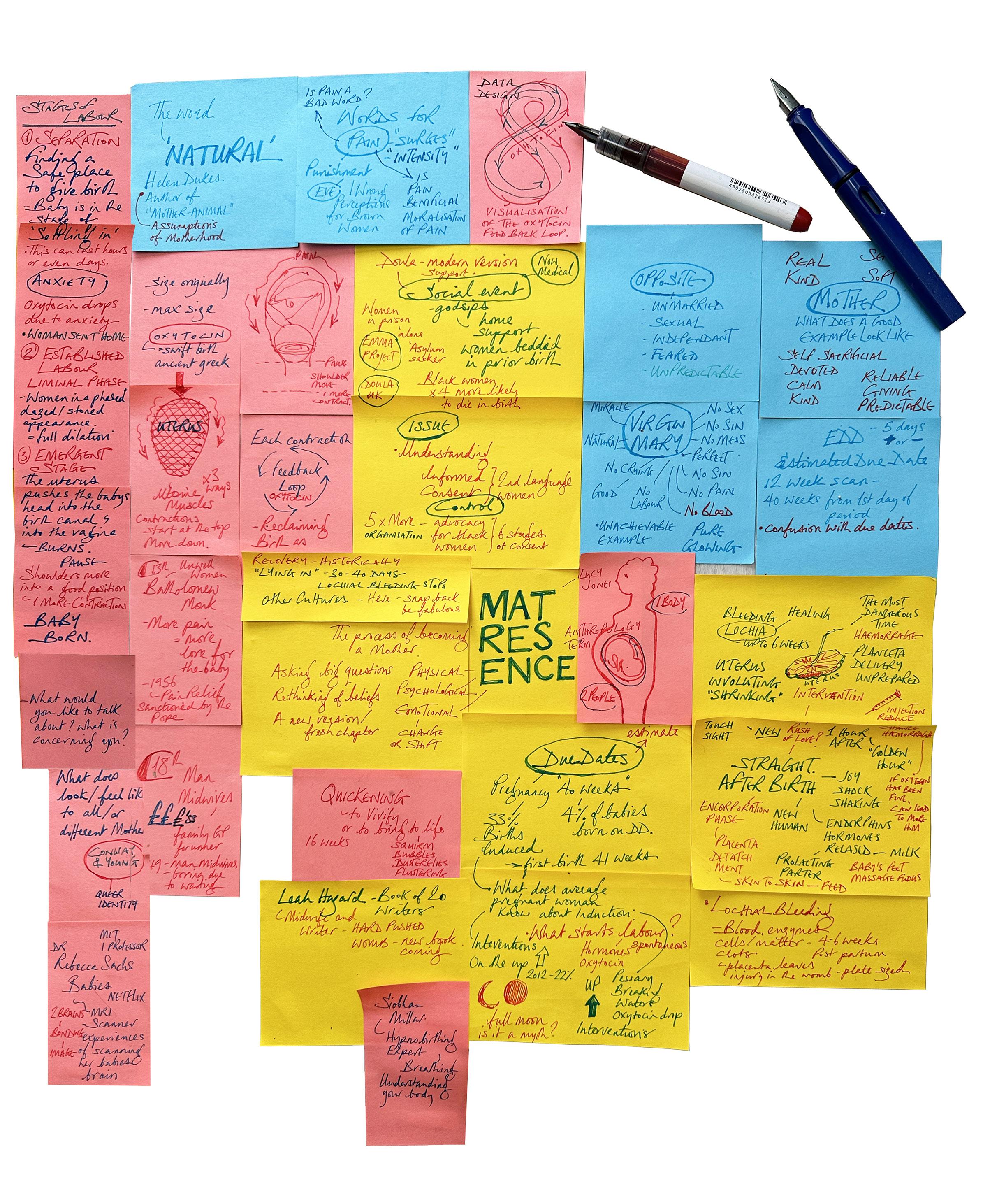
References:
1. Hollie McNish ‘Can I touch myself, though?’ The Best, Most Awful Job: 20 writers talk honestly about Motherhood. Elliott&Thompson, 2020. page 72.
2.
Reinvents
3.
4.
5.
6.
How
An
An
Conference applications:
Graphic Medicine abstract- January 30th 2024
Matrescence, Magic and Misapprehensions: Birth Stories.
Abstract:
This practice-based investigation aims to illuminate women’s perceptions of a ‘normal’ birth experience. This seven-minute lightning talk will explore two key graphic narratives created around and in response to the experience of childbirth and outline Jane Webster’s practice-based PhD question -Birth Stories: ‘How can choice and confidence be encouraged in the experience of birthing Mothers through illustration animation practice?’
News of a pregnancy can be magical and longed for; it also can be a time of enormous change and uncertainty to all stakeholders in the development and birth of a baby or babies Kate Evan’s graphic narrative is titled, ‘Bump- How to Make, Grow and Birth a Baby, 2014, and takes the reader through the journey of making a baby and understanding your body and 42.
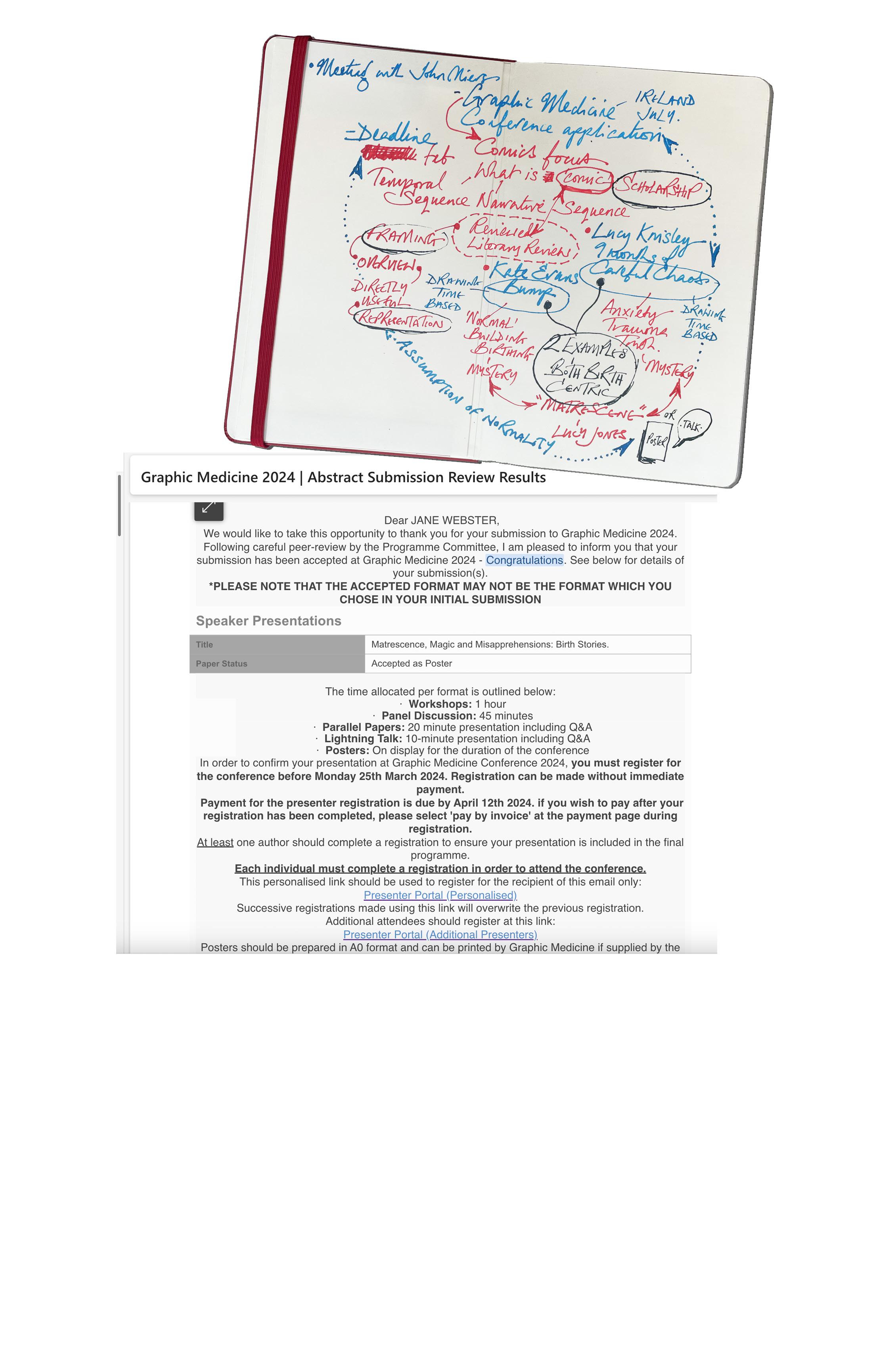
physiology. Growing a baby - the process of a ‘normal’ pregnancy are presented in this book. Concluding with the baby’s birth. Only, not in the array, and often unspoken processes that birth takes place. Lucy Knisley’s graphic novel ‘Kid Gloves- Nine Months Of Careful Chaos,2019, presents the scenario of childbirth from the journey of the teenager and contraception in avoiding pregnancy at all costs. The baby that does not materialise when the time is ‘right,’ the narrative of a difficult pregnancy and the trauma of the post partum experience.
The talk or poster will investigate the language and content in the visual and written analysis of the pregnancy stories both authors communicate and how the PhD research of ‘Birth Stories’ explores the language and presentation of individuals’
experience of pregnancy and birth ‘is a story’ and can often be dictated to the person experiencing their narrative in an idealised and unrealistic forms. The research investigates why accurate birth information is guarded and why the choices of how one’s expected birth story will take a different route and not the desired reality, leaving women disillusioned at a time of significant vulnerability.
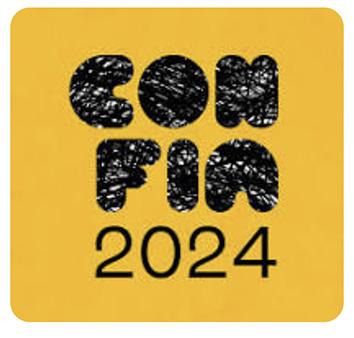
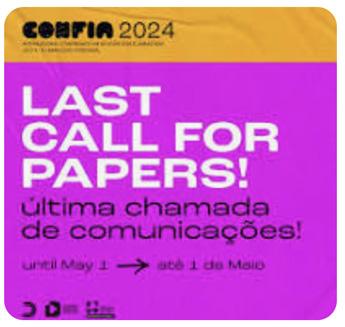
SECAC is a national non-profit organisation devoted to education and research in the visual arts. I have been invited by Molly Briggs, chair of the session This is How We Do It, Part 2: Crafting Programs of Design and Research in a Culture of Change.
Building on conversations begun in the 2022 session “This is How We Do It: Making Methodologies for Social Change,” this session invites proposals for presentations that grapple with questions of methodology in the practice, history, theory and pedagogy of design and design research. In particular, it welcomes nuanced reflection on crafting methods to frame and pursue questions about the shape of built and social space at all scales.
Confia is an international illustration and animation conference in its eleventh year. The 2024 conference will be held in Barcelos, Portugal. I have submitted the abstract under illustration practice and I am waiting for the result as a presenter.
The Birth Rites Collective is a collection of contemporary art about childbirth, the first of its kind internationally. The organisation’s core intention is to demystify the taboo of and promote awareness of childbirth. Helen Knowles curated and established the first works in 2009. The summer school will take place this year in the first week of July at the University of Kent.
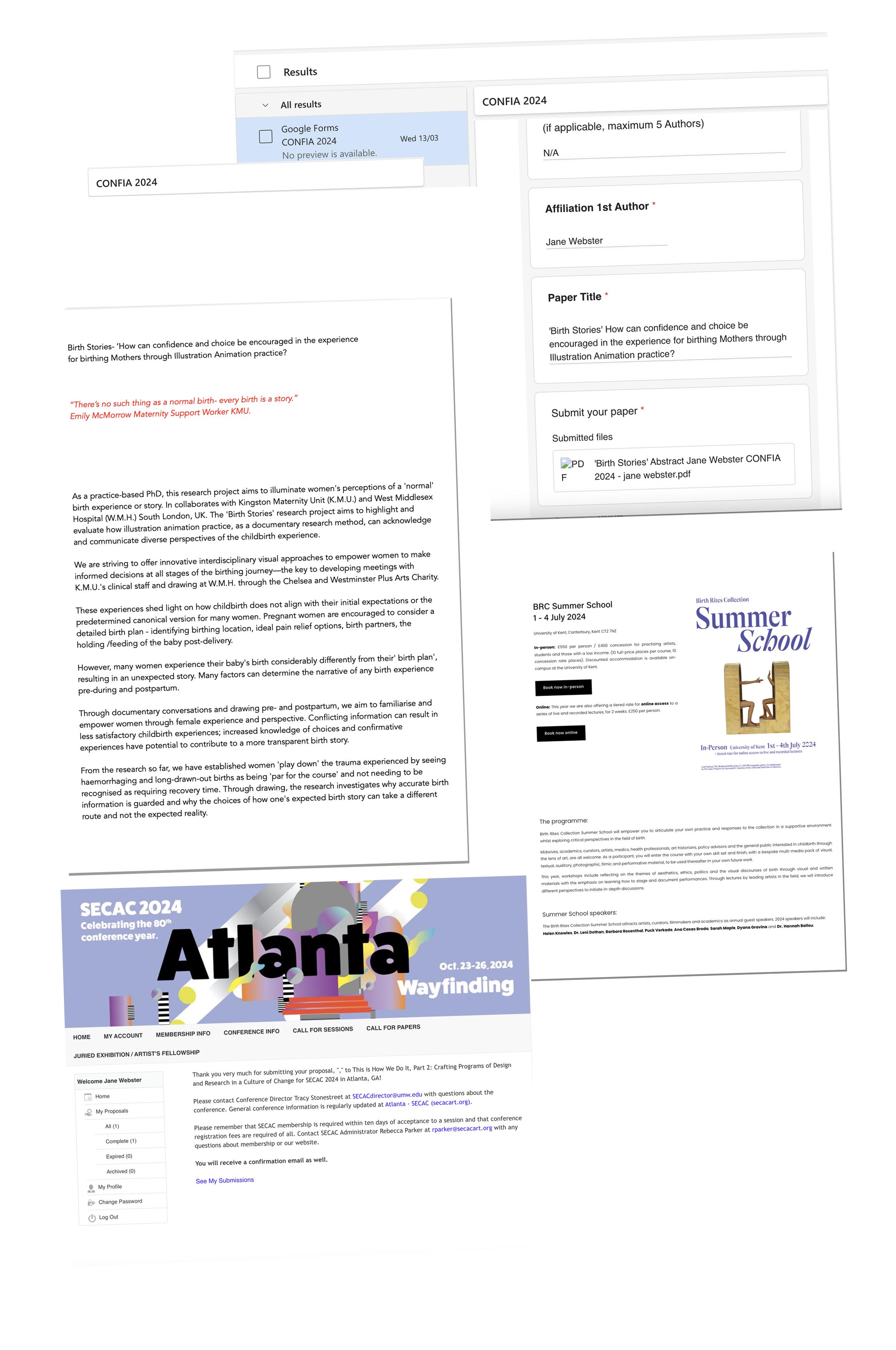
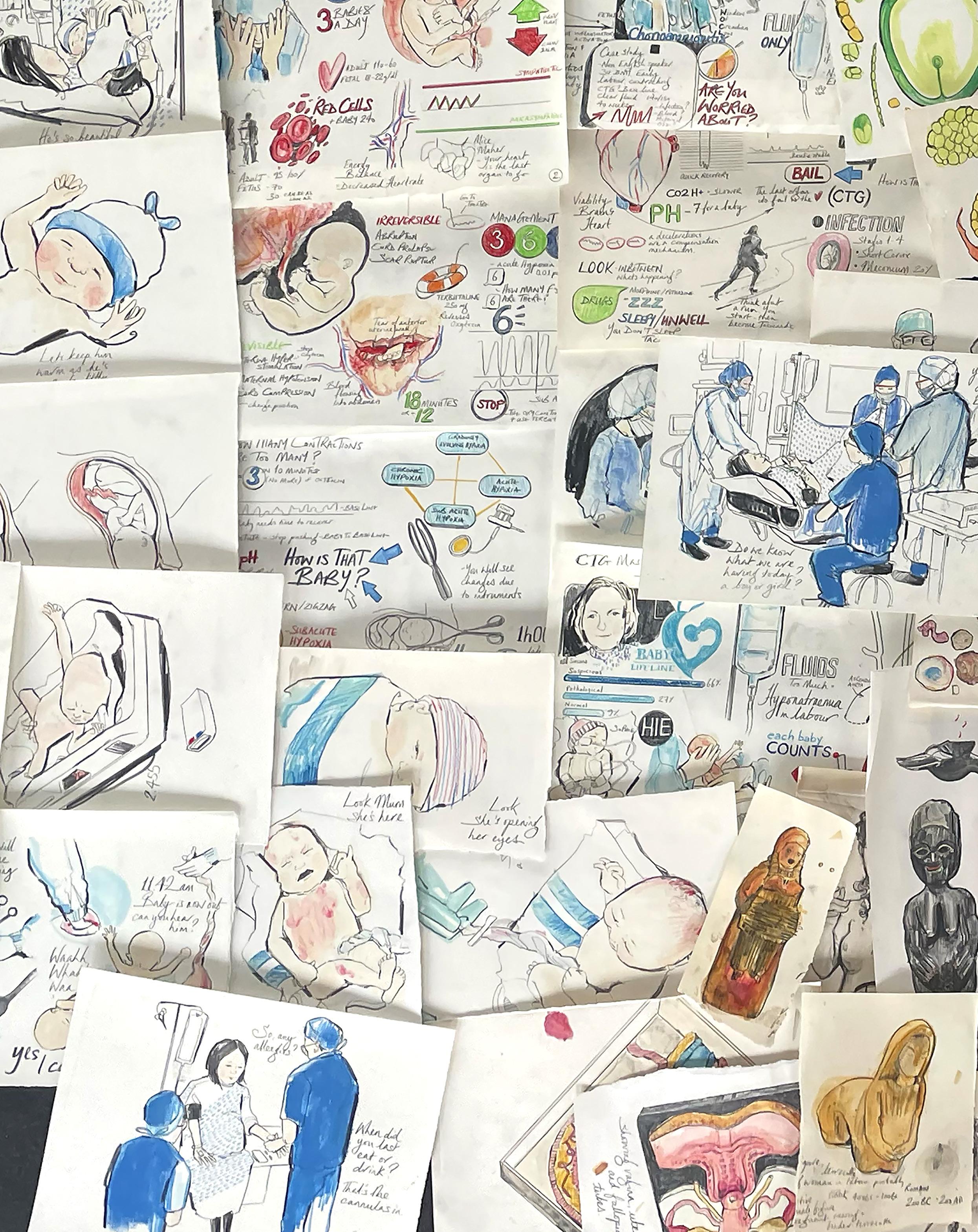
Practice Based Research: Illustration Animation practice
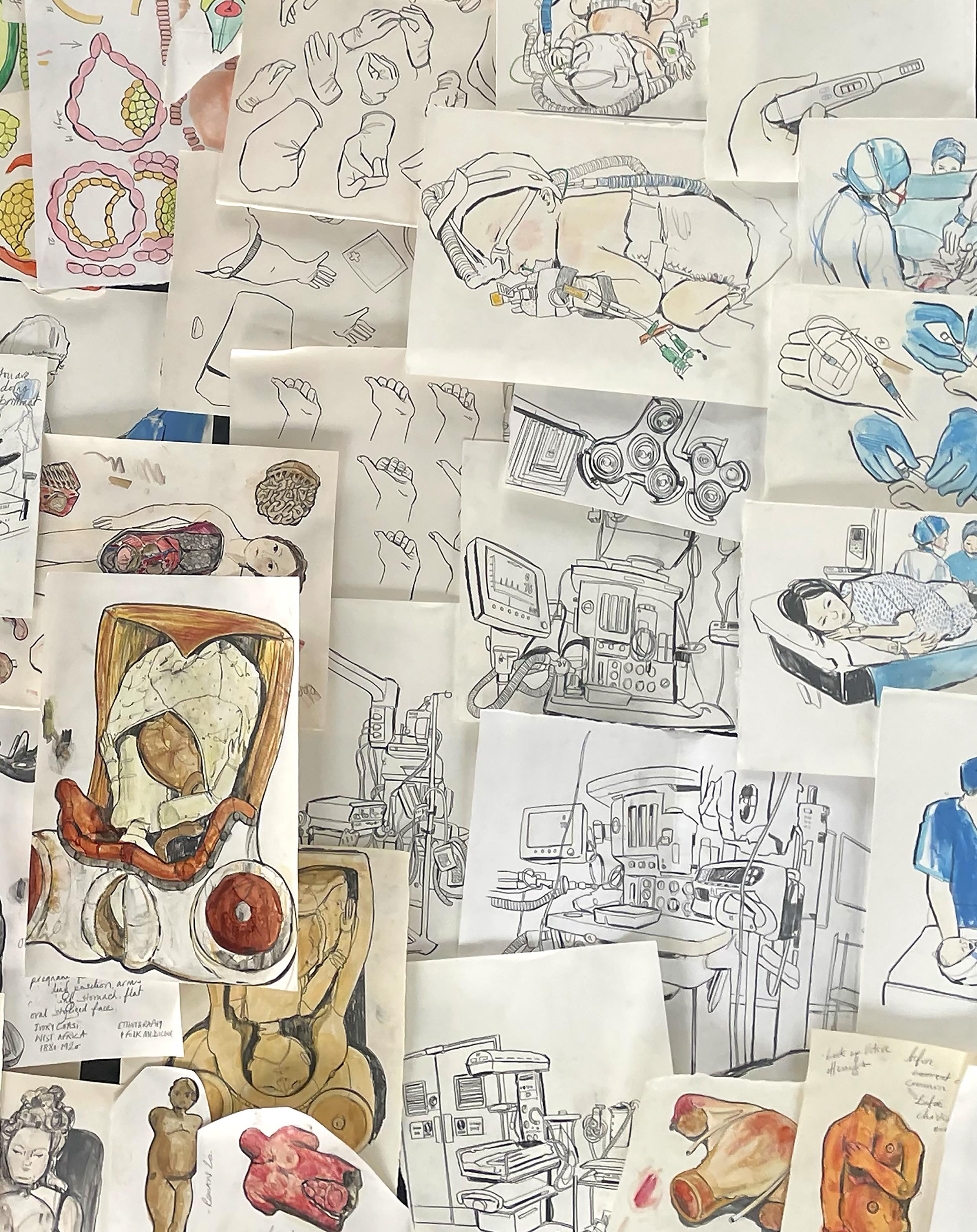
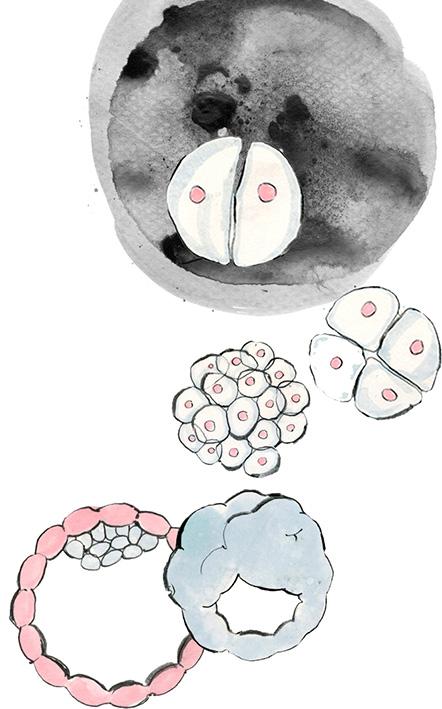
Talking with Emily McMorrow
Midwifery Worker Kingston Maternity Unit April 2024
Hello. Emily, lovely to catch up with you again. We have known each other for a long time- since the kids started nursery! So that is fifteen years? Emily, your comment that is the subtitle for my project-’ “There’s no such thing as a normal birthevery birth is a story.” It would be helpful to catch up and share the route the Birth Stories project has taken since I saw you last year and before I present for my IMR to the next stage of the project. The research that I have been exploring is currently taking this form. I have put together the narrative in the form of five, almost six illustrated readers, with the premise that I can hand them over to anyone to understand and contextualise the project and its intentions.
I love the double page of the theatre drawing; it’s so soft. When I turned the page over, I was, oh wow!
So you are entirely familiar with this environment because you work there.
The drawing made me sit back in my seat because it is from the perspective of lying down. I love the mundane details- such as the tissue box and the scissors on the bottom, which are really well observed
I want to show prospective birth givers a sense of what the environment will look like. I drew this from the perspective of lying on the bed as a person about to have a C-section. The drawing was made at the hospital just as they had their first Covid positive patient, and they closed the theatre, so I was in here on my own for about three hours I remember showing it to Susanna; her thoughts were -’ Oh my God, it appears very complicated, but for us, it’s normal.’
Yes, that’s such a good point.
I recreated this theatre drawing in an iPad program called Mental Canvas. You can press different parts and walk around it— as if it is a stage set. If the person giving birth wanted to, they could click on it, and pop up to inform, and it would tell them what the equipment is and the purpose of what they are premise being that is that you click on this, and it says ‘this is a monitor that ......does whatever that monitor does and why. Most people are not familiar with hospital environments, settings, and medical language. If English is not their first language, they could press on it, and it would be, ‘This is the information.’
Excellent- such a simple but clever idea.
I recreated this drawing in an iPad program called Mental Canvas. You can press different parts and walk around it
like a stage set. If the person giving birth wanted to, they could click on it and pop up to inform, and it would tell them what the equipment is and the purpose of the whole premise that you click on this, and it says this is a box of tissues- blah, blah..
Most people need to become more familiar with hospital environments, settings, and medical language. If English is not the first language, they could press on it, and it would be, ‘This is the information.’
Excellent. That’s such a simple but clever idea.
So what is that? This is going to warm the baby up. This is to check little ‘Doug.’ Any bleeding occurring from the operation- it’s going to go here. It’s not going to go on the floor.
Presenting this information in layperson’s terms is very important, though, because there’s lots of visual information here that I wouldn’t need to find out the technical names would just be. That’s an excellent idea.
So, what is that for, for example? And what’s it doing? The weighing machine and the oxygen—why are they, you know, also near each other? We must keep the baby warm. Knowing that a particular staff member will perform different jobs after the birth is also a patient consideration because your birth might be like this: a couple of people will be here, ready for your baby.
That’s an excellent point, actually. That’s the thing about people because, as you know, when it comes to emergency situations, there’s a room full of people.
That’s kind of what I’m looking at. If everything changes, wouldn’t it be good if someone goes, look, we are going to take you here, and this room will look like this with this equipment?
Very innovative, Jane. So, what makes a PhD a PhD?
It stems around—what is your original contribution to knowledge within your academic field? So, in this case, what does not exist in illustrative and animated form to communicate aspects of pregnancy and birth to encourage confidence and understanding of the choices and information for people going through the process? So, for me, it was the first time I saw Elsa. I was like, what is all this stuff? The tubes, the feeding tube, the CPAP and the hat, the cannulas in each hand?
You are about the millionth person to have said that!
I was in such a lot of pain and was so kind of in shock that no matter how many times they told me, I didn’t remember.
That is a good point, a very good point.
You are in a state of enormous shock, change, pain and vulnerability.
Your KMU website at Kingston is better than most maternity websites in terms of the amount of information provided to your prospective family.
Oh really? That’s good to hear. Looking at these magazines, you have madeyou’ve done so much.
That’s one of six.
Tell me about these images of how a foetus develops.
So, I’ve been looking at the development of the cell division stages and the blastocyte implantation into the uterus lining. I have developed this language or style of drawing from looking at lots of different information, from foetal developmental books to medical companies’ examples of slick, shiny developing babies. What I can’t find in it is That your embryo embeds in the uterine lining here. Then there’s a significant jump, and suddenly, the baby’s in utero. From my research, there is a lack of imagery of how the placenta is formed. The whole placental development and a lot of information are missing in that I didn’t know I had to birth the placenta after having a baby.
I didn’t, either.
I have just discovered that it is the most dangerous point of a delivery.
Yes, lots of issues can occur, it can get stuck or break apart. You must check that it is fully intact.
I want to explain how the embryo folds back around itself visually. This is when many midline issues can occur, such as heart defects, cleft palates, and lips. So, as you know, Jonas was born with a midline abnormality. He presented his neck as a hole, which was a complete shock and very derailing as a first-time parent.
No, I know, exactly. Regarding the website, it might be worth seeing how they’re showing any tour of the facilities. We used to have real-time tours. The language of a virtual tour—does it look really ‘hospitally’? What would be great is to do different versions and show them to women and see which works in making them feel more reassured or which makes you feel frightened.
Yes.
Or do you look at this and go- this information is overwhelming. In it is too much.
I need to do my ethics clearance. Tracey O’Brien, head of ethics, has been back in touch, which is reassuring.
When you have that, you’ll get a real mix of people. Some want every single bit of
information, and others really don’t.
Consultant Susanna said there are three different types of birth people at Kingston. You’ve got your mum in her 30s, who has a career sorted and who is in control.
Then you have your mother, who has other kids, who could be more focused. And then you might have a mum who goes; it’s all going to be fine; it was okay with my other ones. We only get a few younger mums, but the younger mums and mums may come from a more disadvantaged background. The majority of our women are high-flyers who’ve waited until their late thirties or early forties to have their children and mainly have absolute power in their own lives. They’re in high-flying jobs, they make decisions, and they’ve got. There’s control all the way along, and suddenly, there’s a lack of control when pregnancy and birth are in the equation. That’s the demographic, but we must know that others only want a little information. They may be nervous or terrified that they can’t ask for fear of looking stupid. Or they may need language support to ask because English isn’t their first language.
I have a Norwegian friend who speaks better English than I do. They had their first baby at Kingston a couple of years after Elsa. As they were talking Norwegian, they were patronised. The staff presumed that English was poor.
It was based on preconception—yes, a notion. You have to make sure you hold all prejudgment with my role.
I remember you talking to me about how common some issues are, such as a piece of bowel that’s come out of a hernia. I want to explain these conditions.
Before I trained here at Kingston, I thought when they put a cannula in your hand, it was the metal that went in and stayed in your hand, and then you couldn’t move because there was metal, and if I moved, it would hurt. No, it’s a tiny sliver of rubber that you can move around without a problem. But I didn’t know that because I had never asked anybody. Everyone has some level of fear.
My project has two halves—almost like a burger. On one side, we have medical practitioners, specialists, and experts, the premise being, ‘It would be great if you knew.’ On the other side of the equation, you have birthing people who leave their experience thinking, I wish I knew, or Why wasn’t I told? Would it have been different if somebody had told me? I am examining the project from two perspectives. I am working with two South London hospitals with different demographics, users, and stakeholders.
As you know, you can’t instil knowledge in anyone, but you can provide it. If it’s a choice, that’s where the research’s
potential lies. The beauty of this, especially as you’re, you know, the way you’re putting it together; I love the idea of the whole wealth of accessible information there if you want to know. Do you see it developed as a set of magazines?
No, I don’t want any print. It’s all going to be digital. The print has costs, dates, and language changes, which are other costs. Everyone’s got a phone.
Returning to that theatre image- even though it is a hospital theatre, it is beautiful and soft. It is very organic, which is a good word for it.
Is it because it’s drawn in pencil?
I don’t know my immediate reaction in that it was drawn with a pencil when I opened it, but I was struck by how lovely and gentle it was—it’s a very gentle drawing. The more we’re moving towards a digital model, the more our notes are finally digital; it makes much more sense for them to be viewed on the phone- and, as you say, everyone has one.
Have you heard of the word ‘Matrescence?’ In adolescence, you enter a different stage of your life. You change into a new version of yourself. Your whole being is being rewritten as your hormones and emotions change and develop.
How interesting.- No I haven’t.
In the same model, as you become a mother, all the hormonal and emotional transitions happen similarly. I only discovered that when you have your first child, your amygdala, part of your brain, is like an alarm. It’s the same if you are a primary carer of a child you haven’t given birth to. You change to being on ‘high alert.’
I can understand that. It makes total sense
Emily, you see birth day in and day out. What are your thoughts on how birth is presented to those who do not?
I’m showing you Flor Cruz’s Instagram, whose posts about natural birth are covered with warnings: Sensitive content is anything that may offend a reader, especially related to religion, race, gender, politics, sexuality, disability, or language that is considered obscene, vulgar, or offensive.
Right, each one of these images is a woman giving birth naturally. It is wrong. It makes me feel like it is sexualising the experience. It’s sexualising the entire person.
If you watch any of these videos, the baby’s head crowning looks like a flower opening.
Your body is fantastic! Rory described Maddie’s birth—he said her head. He was talking about her head, and he said as her head came out, her skull opened like a flower. He said it was incredible.
I’ve been reading about oxytocin. Oxytocin loves itself—it is the love hormone that makes birth happen. When we are scared, crocodile and adrenaline interact and stop oxytocin. I have a workshop with some students next week about what we think that looks like. And how could we show it going from the brain around your body? What would that look like? And then how could you, almost like visual breathing, help you try and overcome that fear? I also would like to know what being induced looks like. In my head, I was going in on a Sunday and would have had a baby in three hours. Instead, three days. Three long days and no sleep.
The majority of people think that birth happens on the first day of the induction. It can take up to six days. Everyone’s body is different. That’s the thing: everyone’s going to react differently, and that’s the thing about childbirth: everyone’s experiencing the system differently.
Do you know that I was with a patient yesterday, and I was coming out of the screening? I’d taken 10 minutes and taken the blood test; they said, what is Down syndrome? So, I showed them an image of a child who had Down syndrome. All it took was to see a child with those facial details, and the context was there, so there is an example of how a picture saves misunderstandings, many words and time. Even though I’ve worked at the maternity unit for so long, I still feel every pregnancy and birth is a massive celebration. Like you say, we don’t see birth unless you are supporting a partner.
So the whole premise is that you’ve got with every TV program- such as one woman every minute, They’ll either do a clever camera angle with her leg, right, and then a baby’s out, or they’ll do some pixelation of a vagina. Still, we never see a vagina opening, which, I think, creates so much anxiety.
How many births have you seen in the real world?
My two births - at the top end, and two C-Sections I have drawn at KMU.
It’s gory. You know, it is gory.
But because we don’t see it in Western culture, is that likely why we are often afraid? Is there another way to depict these experiences through the softness you have mentioned?
That’s got to be a good thing, whether through drawings or animated drawings in appropriate ways. The drawings are great, especially if they’re done in the gentle sense and tone you’ve been portraying your drawings. 48.
I was going to say that. The whole point is that the more people understand not thinking as they look at the vagina, it’s hopefully not going to be pixelated.
The cultural diversity that we have now within the NHS will only continue.
Yes, absolutely.
And the number of women we see who do their best to understand and nod a lot. I know people worldwide, and this would be an absolute game-changer. We’ve got leaflets, you know, to support my part of my job, and they’ve got translators who are with us and to be wonderful parents. That service costs a fortune, though. It would be wonderful to be able to say, go into your app, and then I’m in my app as well, you know, we’ve got something that comes off the computer that we can do the same thing; it’s almost like Google Translate at the same time, they’re looking at that, I’m looking at that. It would be brilliant, absolutely brilliant.
The nuances and the precise language of health care must be complicated to translate as languages don’t translate word for word. I know that from having a native Norwegian speaker in my family.
Oh my God, yes! Even with a translator, you know, especially when you’re getting into details such as foetal medicine, you’re dealing with an utterly specialist language
Do you want to give an example?
If I’m talking about, for example, their blood group, and they’ve got a rhesus-negative blood group, and I start to explain that, I can see the translator needs to translate exactly what I am saying. It is also an exact window of time for us to do a procedure or have a consultation. Whereas when you’re talking about having an app or whatever you’re going to do, it’s your choice to press that button to find out that information is coming from a trusted source.
I want to find out about your gestational diabetes. Your health provider suggested that you look at this part of the process.
As I said, I explained the book in the notes. The first page you open lists almost everything that can go wrong, the most immediate things that can go wrong. That can feel confrontational and alarming. Whereas if you have been told, okay now, you’ve been diagnosed with gestational diabetes, I need to find out about that, let me have a look at that, I wonder if there’s any information about that, oh, absolutely yes there is.
I remember what you told me: before you go for your routine urine test, don’t eat Cocoa Pops or drink orange juice for breakfast, or you’ll be in trouble. Only eat something sugary after you do have completed your urine test.
It costs the NHS money.
Only eat chewing gum after you do it.
Yes, absolutely. Oh my gosh, that’s such a good point at the moment; well, it will because, for example, we’ve gone from giving people letters with a printout about the glucoside test to not consistently attaching a written guide.
Now, women are coming to me for a glucose tolerance test after having eaten, rendering the test undoable. The premise and procedure must be transparent to the patient—this is how the test works. Women say, ‘I Googled it, and it said don’t eat from midnight.’
Every hospital carries out the test differently. It’s Kingston Hospital’s policy—we say you have to fast for 12 hours, so I can’t do the test now. And they’re very upset.
Could I design a visual version of the written PDF?
Oh my god, that would be a brilliant idea. Jane, it would save the NHS, hospital trust, and patients time, money, and energy— also, approach John Grellier, the head of improvement.
I know him, so I will.
Again, then the language barrier could be addressed, or it could be designed with the top 5 KMU patient languages. I will text you a copy of this leaflet that should be sent out to patients having that.
Please do.
A digital attachment would be so helpful as women often have booked a day off work. Also, it’s our time as practitioners, the appointment time, and the fact that women have fasted. They may have had to put other children into childcare. Also, remember that it’s a two-hour test, so they have to sit in the hospital for that time. So if they have to re-book it, that is a lot of wasted resources.
That’s a lot of NHS time.
Thanks Emily,
No Thanks, Jane - I’ll send it tomorrow.
As a ‘stage set,’ where you, as the viewer, can move around the space and see behind the scenes through illustration practice, this software has vast potential in introducing patients and families to the clinical environment.
The left-hand side of the screen has several layers, so in this drawing, the walls and the different pieces of equipment are in the operating theatre. The bottom frames can be selected as points that you can move around the room - giving the viewer a chance to virtually ‘enter’ and move around a new or different space. The patient can know what is in a particular clinical setting through drawing and understanding their viewpoint as a patient and seeing complex equipment on their terms before being moved into a clinical setting. The intention is to reduce the anxiety of visiting a new and unfamiliar setting, answering questions such as..
What does it look like?
What equipment is in the room? What will I be hooked up to?
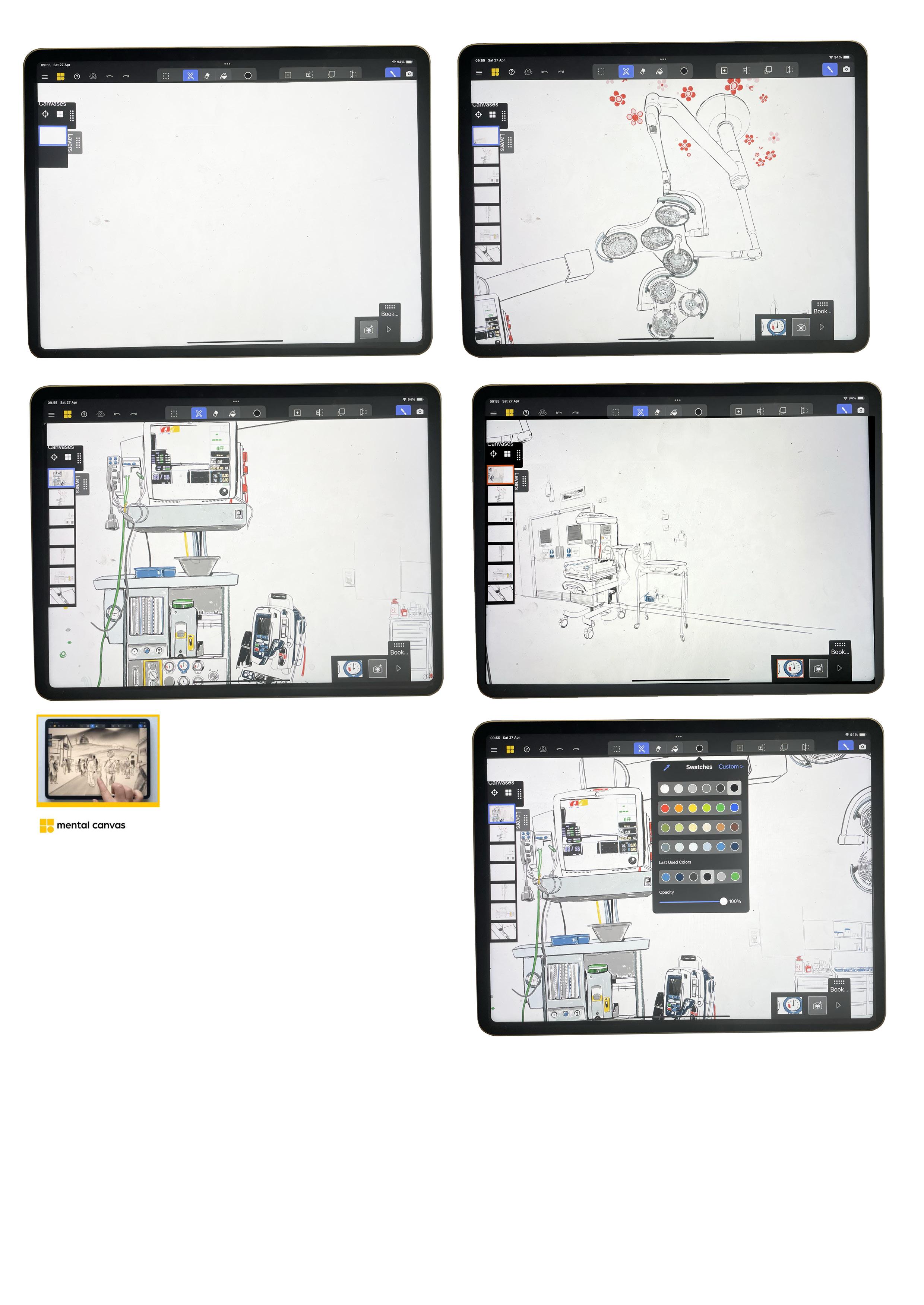
Where will any blood go?
As an illustrator, images and environments can be drawn straight into an iPad, or more traditional paper imagery can be scanned and imported into the software. My conversations with Emily McMorrow have brought up the complexities of the environments and equipment that are daunting to birth givers. This software has
much to offer in demystifying a space before you visit it. It would be ideal if one could click on the drawing of the equipment, and a pop-up description of what it is and what it does would be informative to the patients and their families. Other languages can be chosen for non-English speakers.
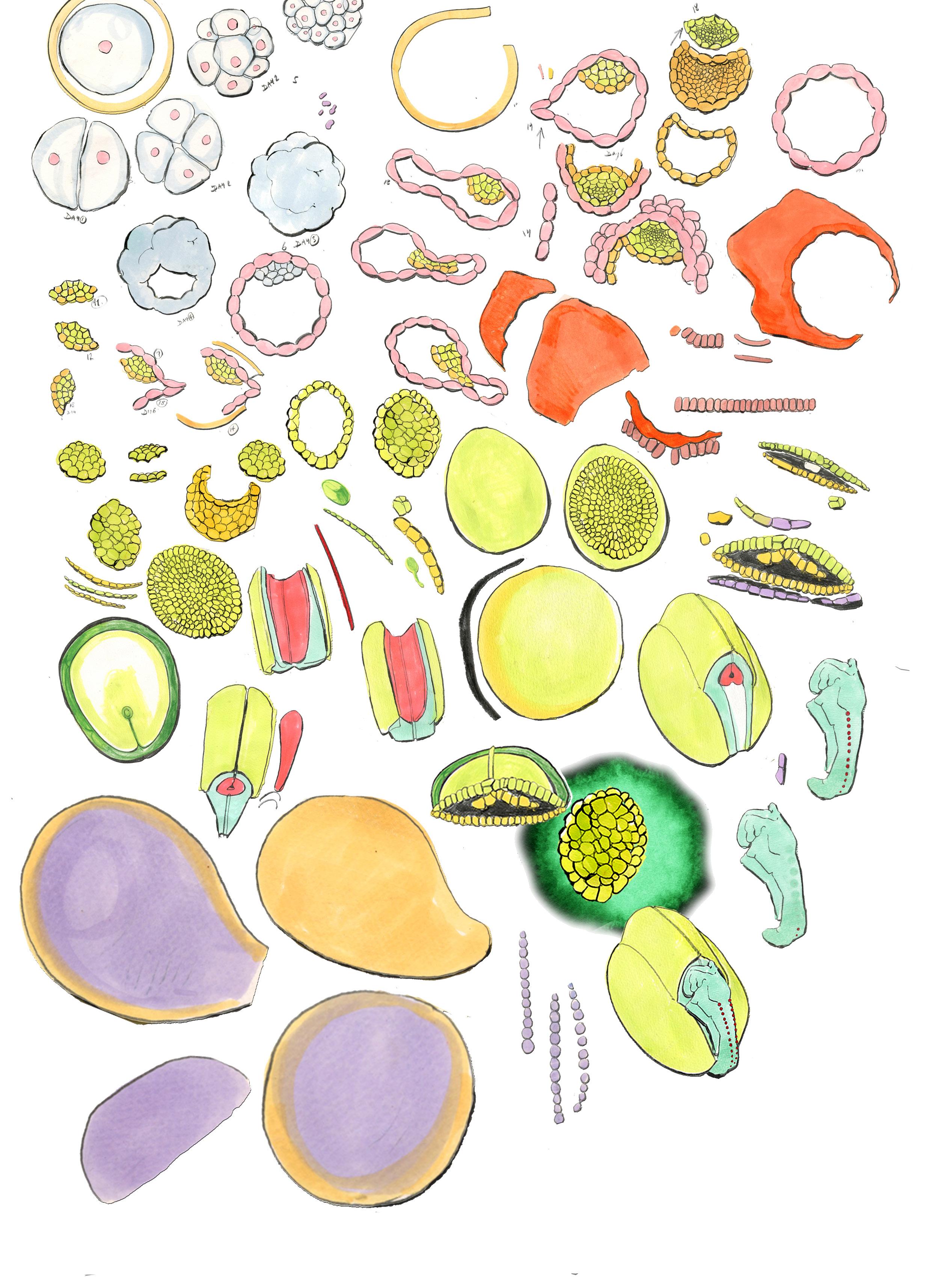
Drawn elements for a ‘library of parts’ to create animation frame layers.
Illustration practice
From many tutorial discussions within the last two part-time academic years working with the material for the Birth Stories project, the term WHY YOU/ WHY NOW has been brought to the table. These discussions, which have been a rich learning experience for me, cover the recurring themes of recording and presenting representations of birth. As a practising illustrator with representation in the U.K. and the U.S. since 2003, I have a wealth of experience explaining complex information in a visual form so that the audience can make sense of the complexities or the mundaneness of the information. Many
commercial illustration briefs can and are centred around making s**t sparkle. Illustration research practice provides a time and a space to talk, ask questions, test, challenge and reconsider the methods of making work as the rush of the deliverables of commercial work, where often you can be brought into a project as the ‘hand’ or visual voice, and not necessarily in the problem-solving aspects of the brief.
Within this project, I must reevaluate the practice of making images as I work with chemicals. My ‘watercolour’ images are not made with water; when working on
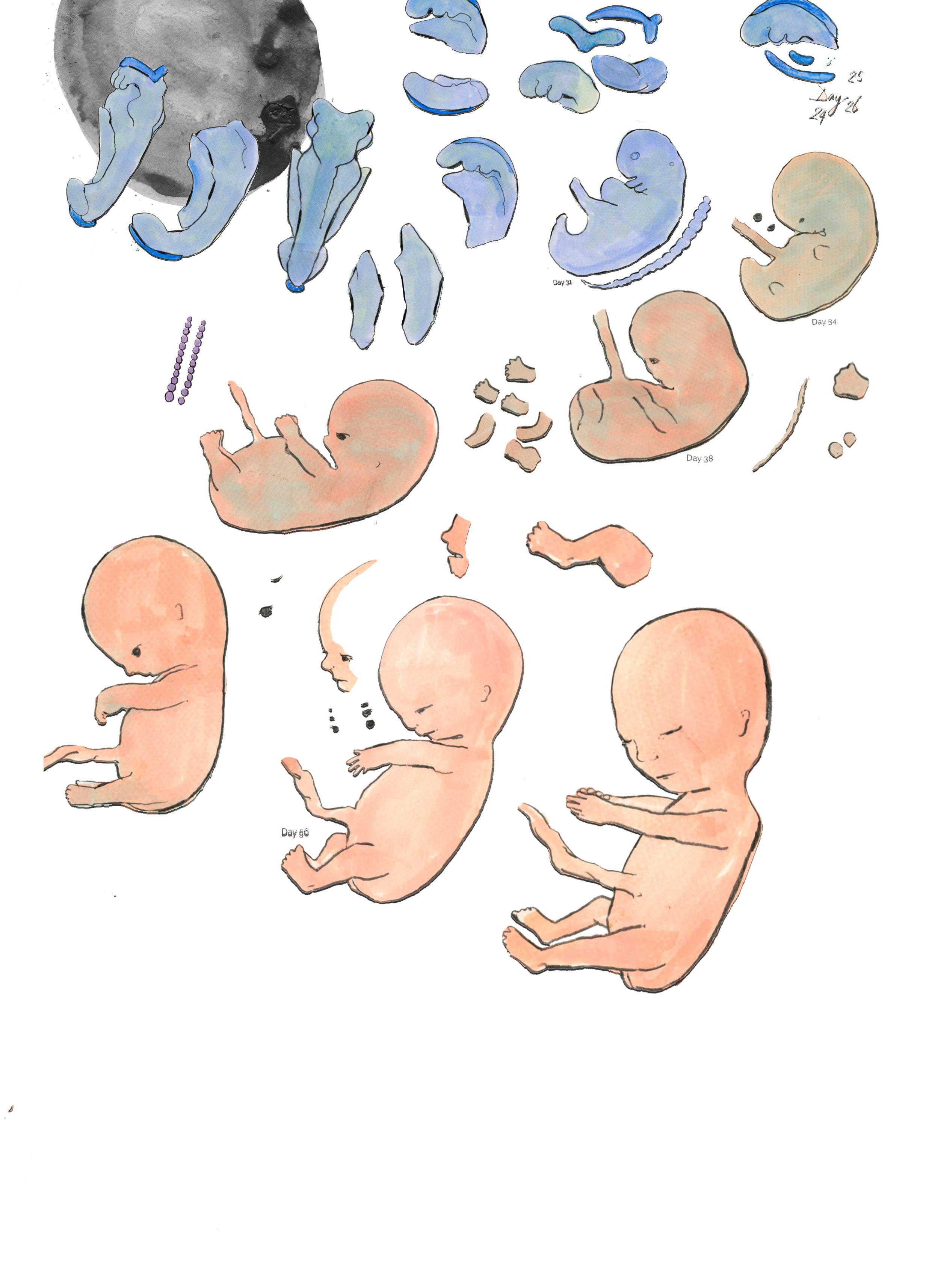
location with documentary work, there is no time to wait for pait to dry. Specific humidity and temperatures also affect drying times. My practice developed with the use of primed paper, ProMarkers- which are alcohol-based, graphite and coloured pencils and specific hairsprays which establish the ‘wateryess’ and the shine of an image. This drawing process allows a certain amount of line movement. It can push the colour back into the paper and dissipate the intensity of the colour, so it can be built up by repeating the process. Making illustrations in a clinical environment this way is inappropriate, so I have
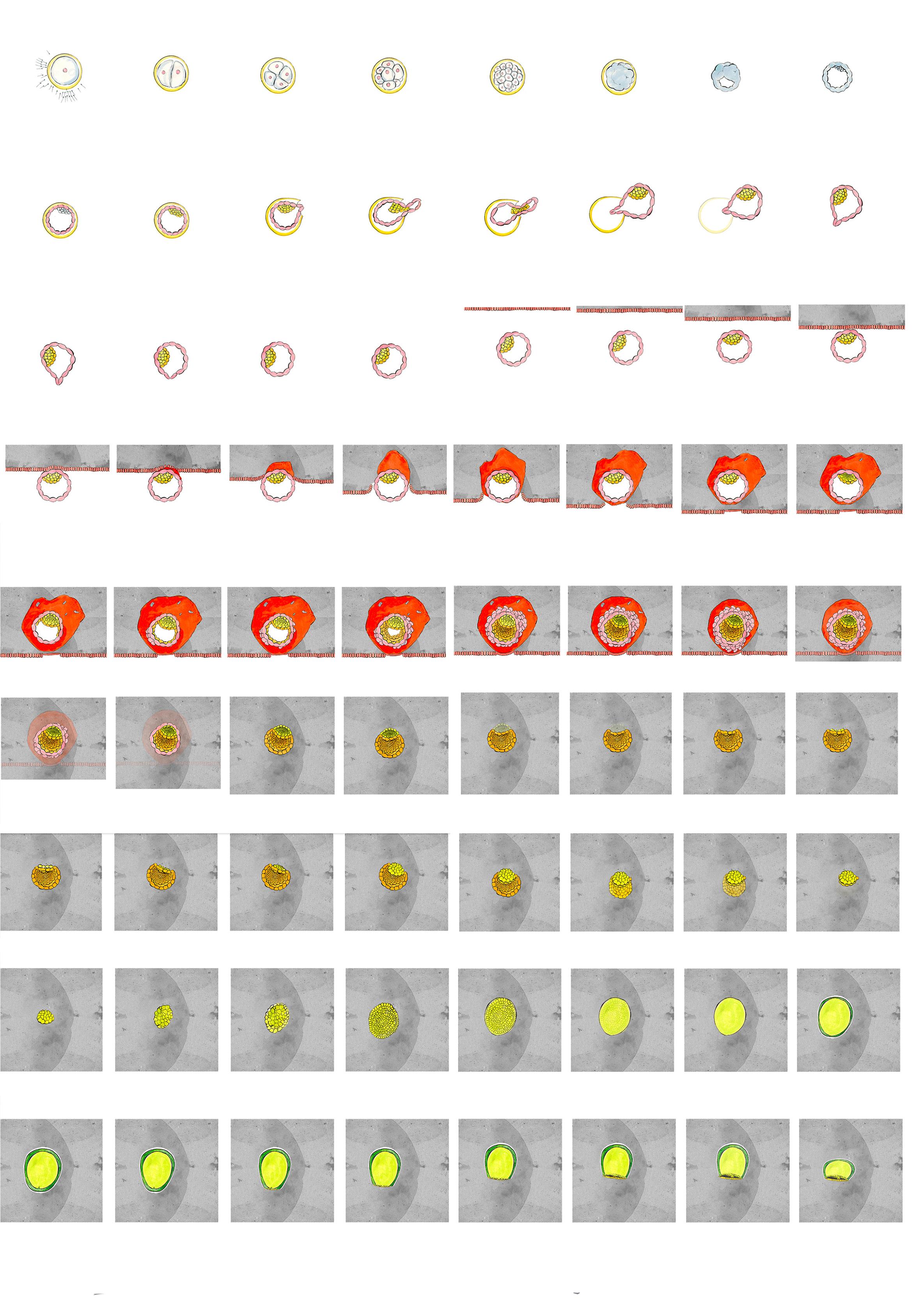
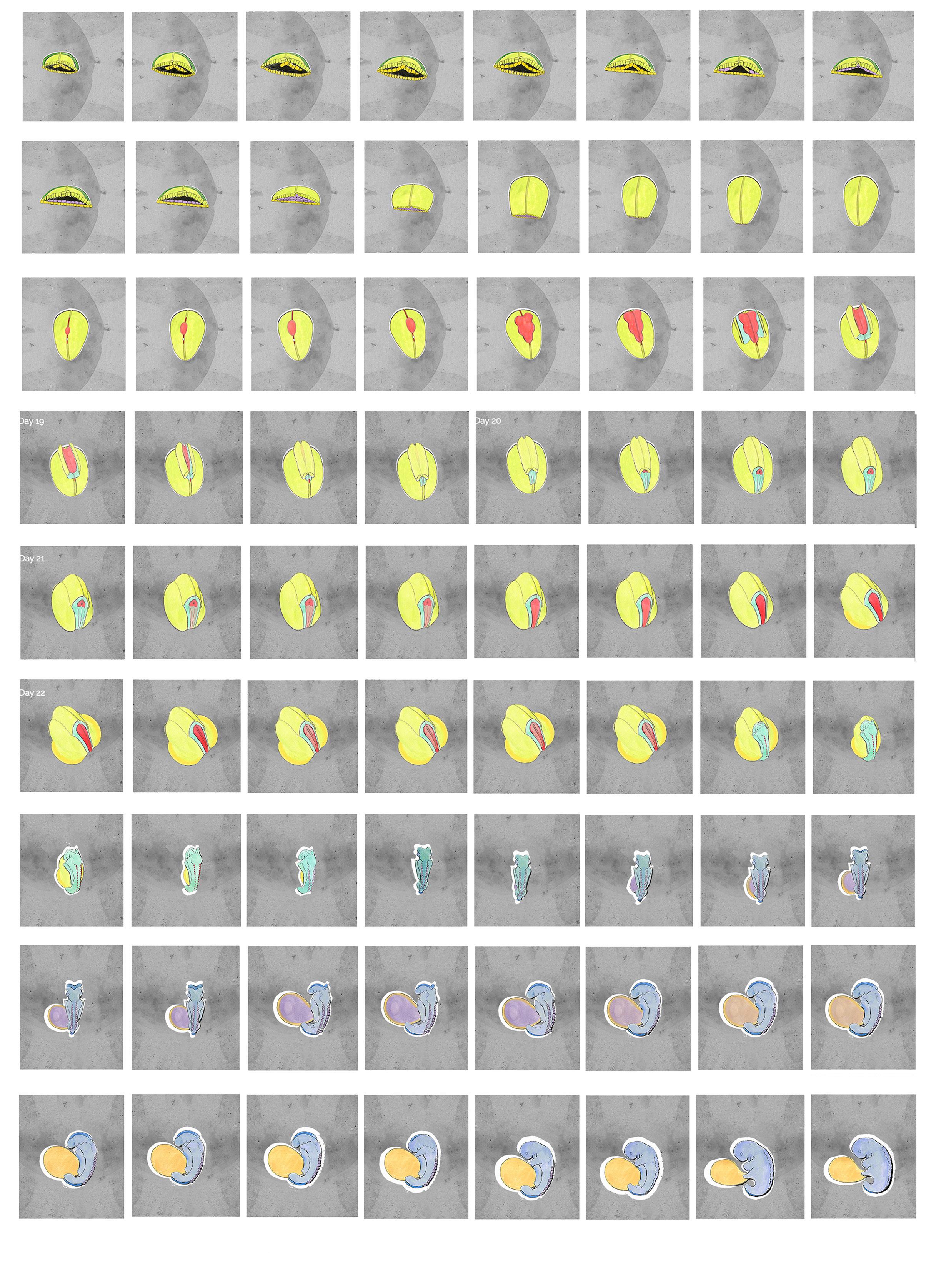
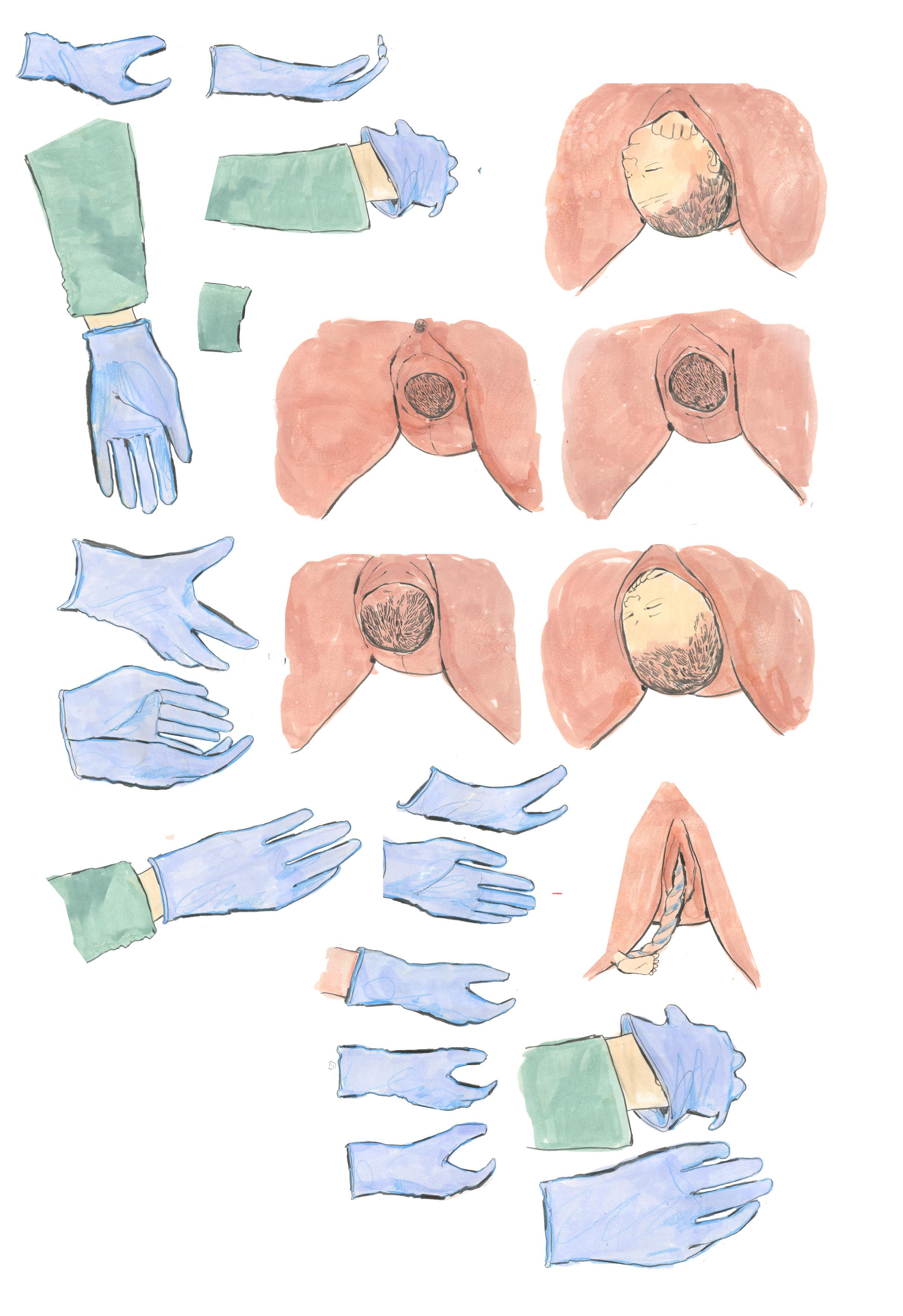
been developing other drawing practices. Using a Sennellier oil bar to prime the paper has a similar effect. White or translucent gives the paper a surface that can be ‘moved’ with either a pencil or another coloured oil bar. Many illustrators work with establishing and constructing an image using pencil, then possibly ink or applying colour after the line work. I have always worked the other way around, building an image with the colour first to build up the picture and applying the graphite last. Reflecting on why I work like this, I realised that it developed from needing to build confidence in practice during my B.A. and establishing a drawing structure with areas of collage, with the premise that it can be moved or removed. 54.
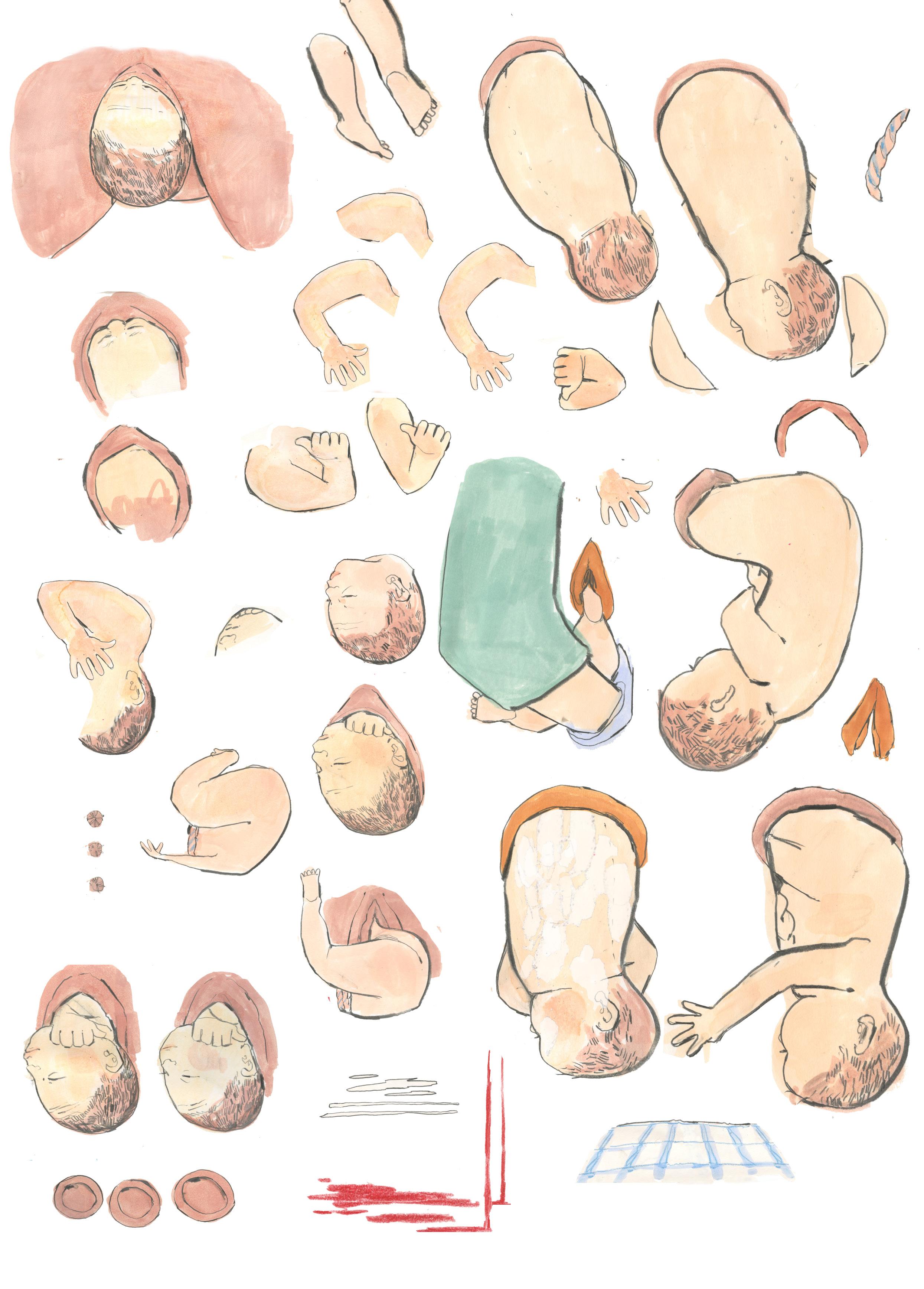
Drawn elements for a ‘library of parts’ to create animation frame layers.
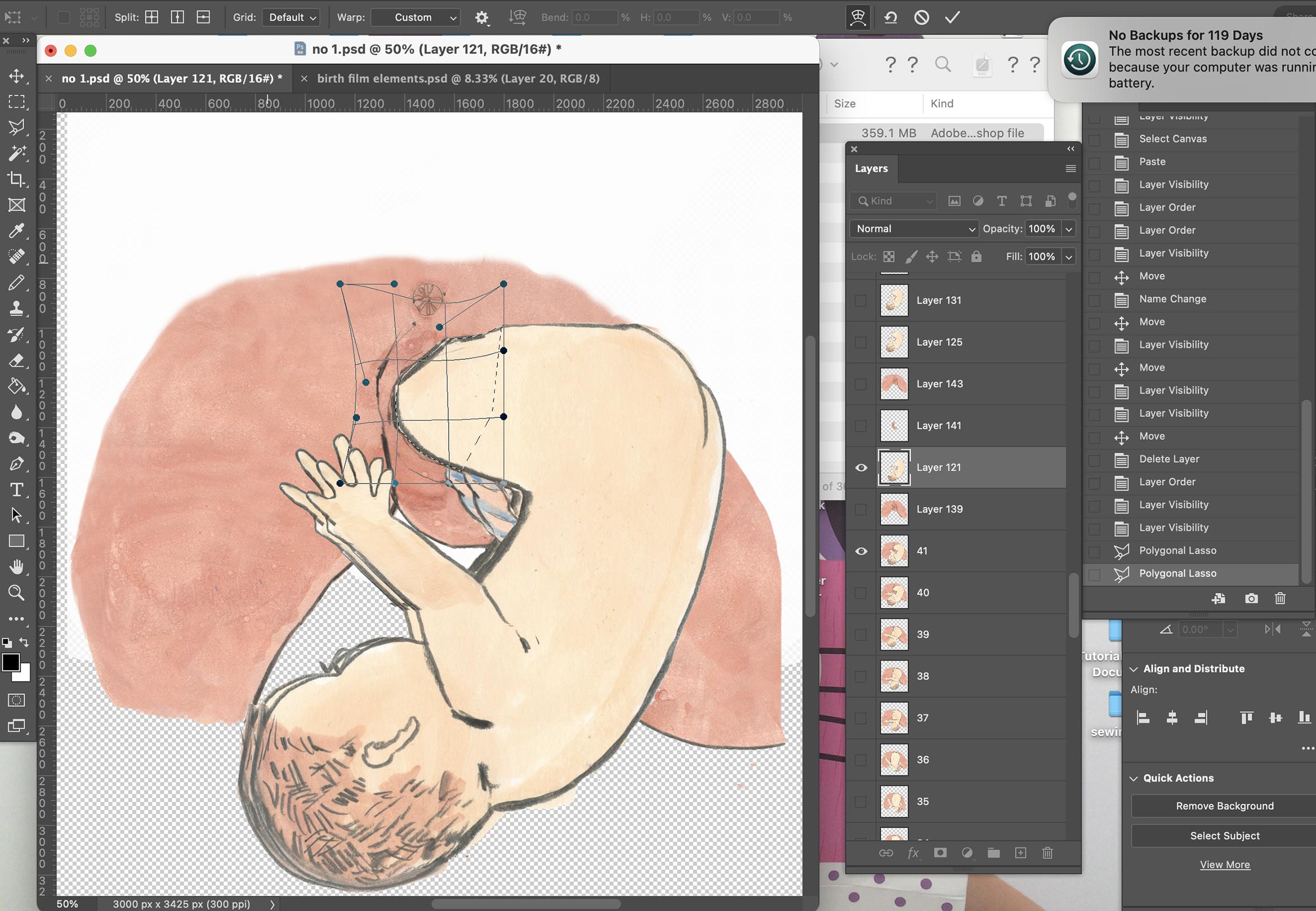
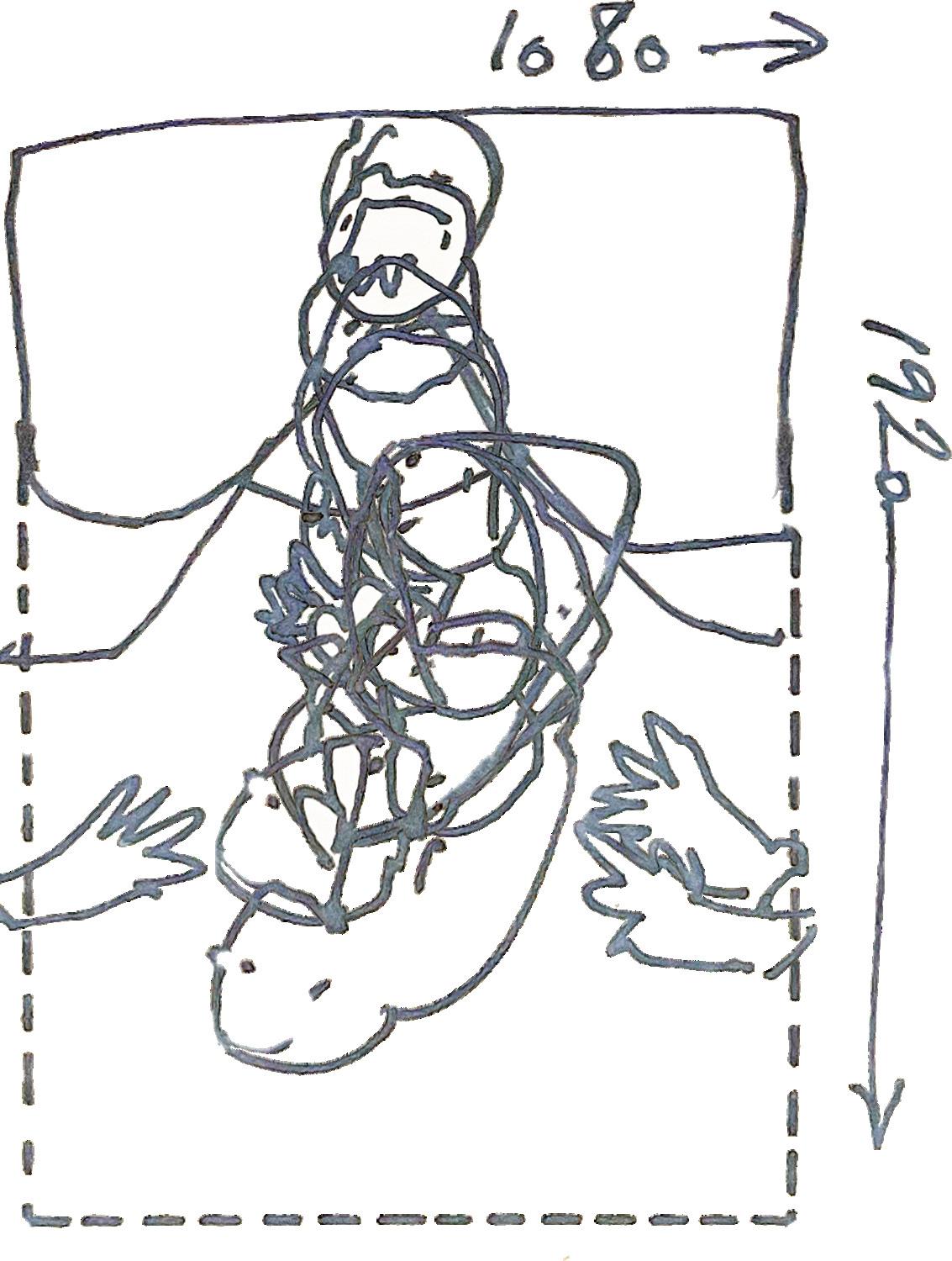
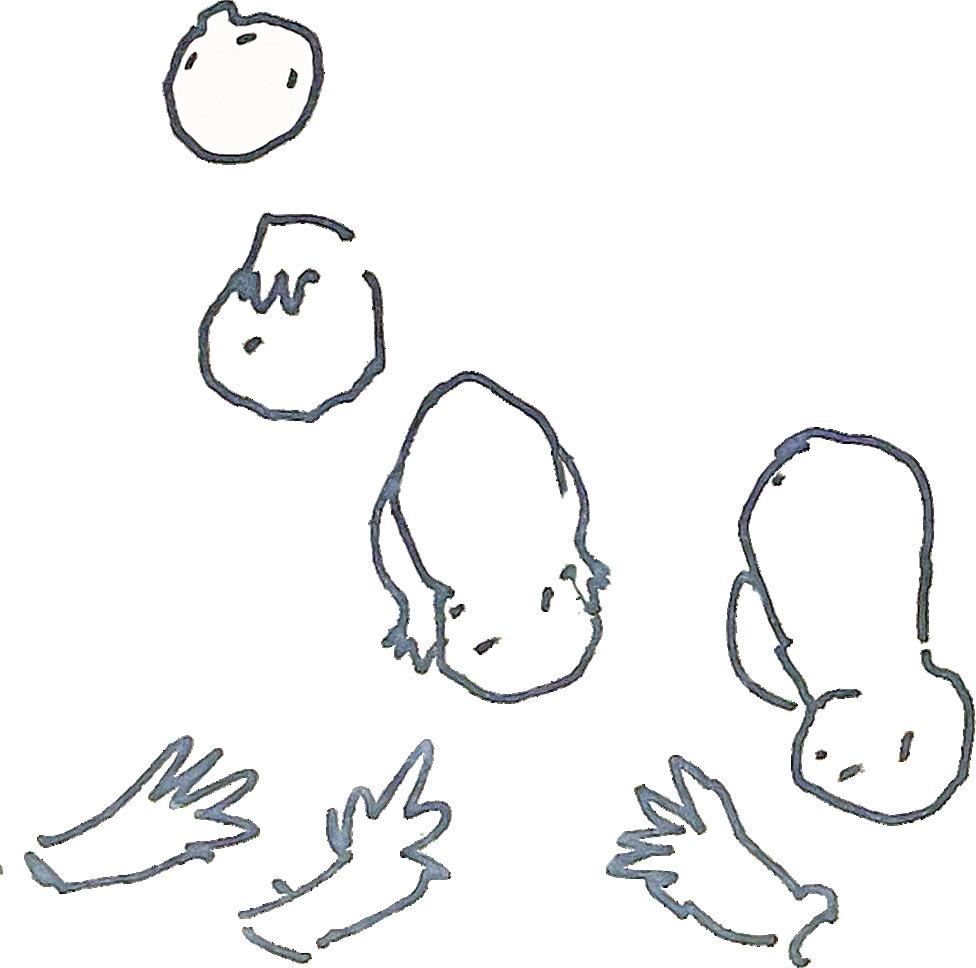
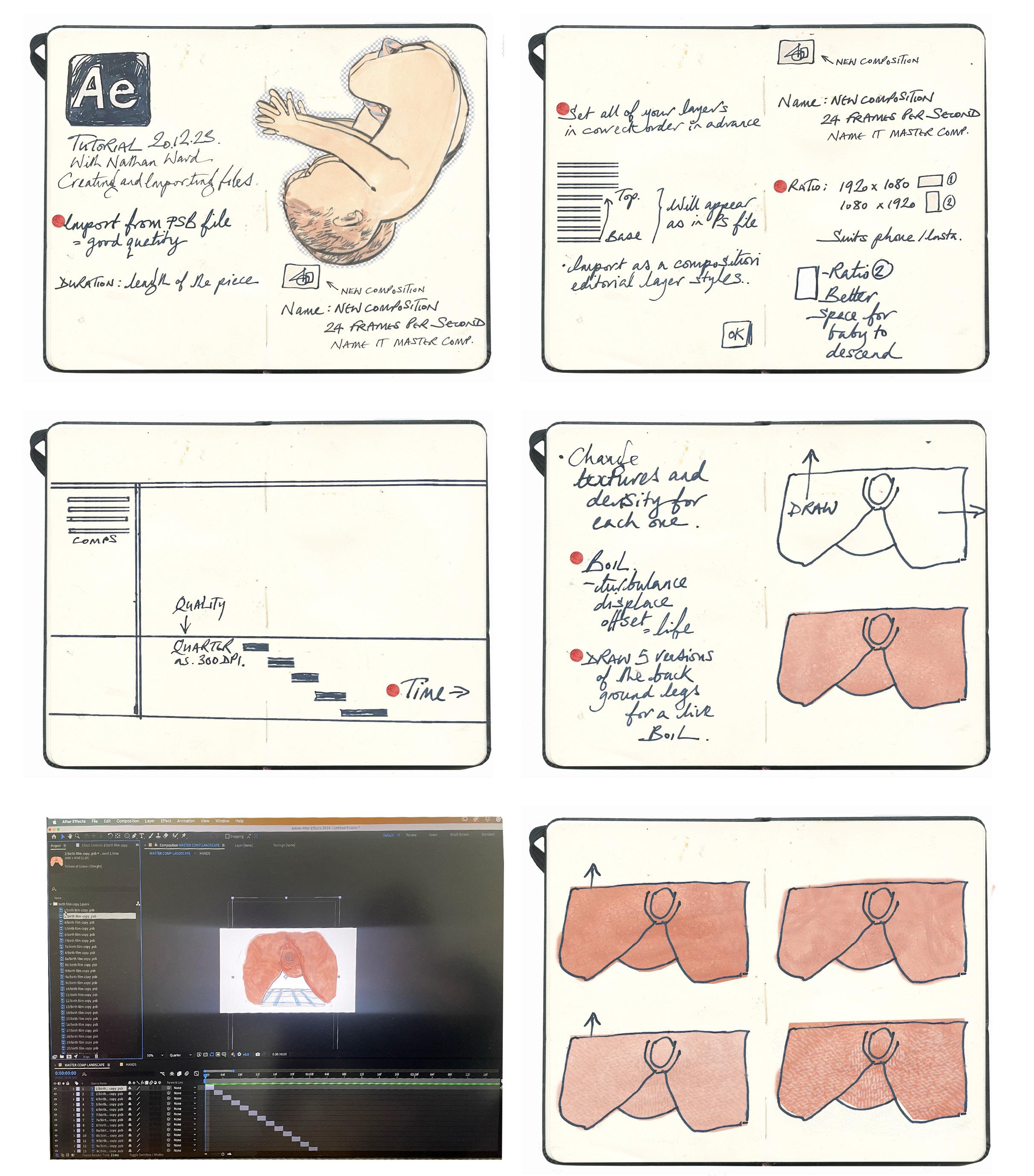
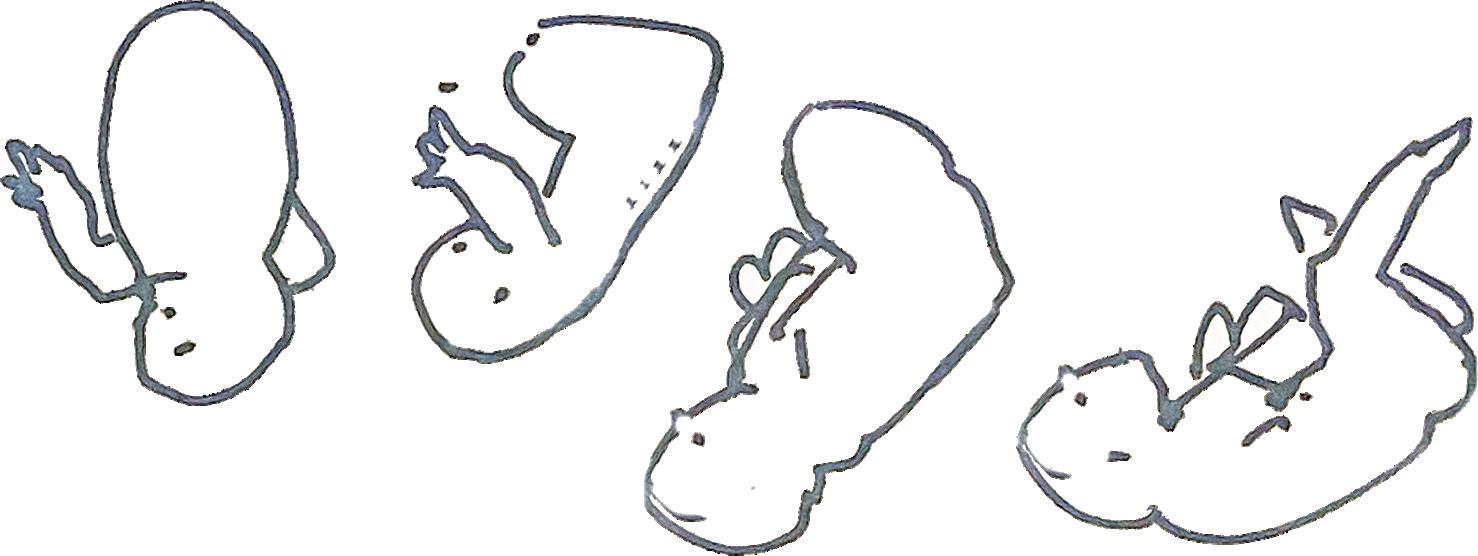
Moving Image or static image?
Note from Tutorial 15/01/24.
The boils and movement make the animation feel more like it’s not just flat or still. What you’re doing is you’re putting energy into time because traditionally you’ve drawn what’s in front of you, in a documentary sense of images, and that is then the communication, but have you got a strategy for why a moving image is going to be more helpful? GG
No, I don’t. I’m trying to determine whether it works better as a sequence of not moving or moving. JW
It’s worth documenting in your research because there’s a big difference between static and moving images. GG
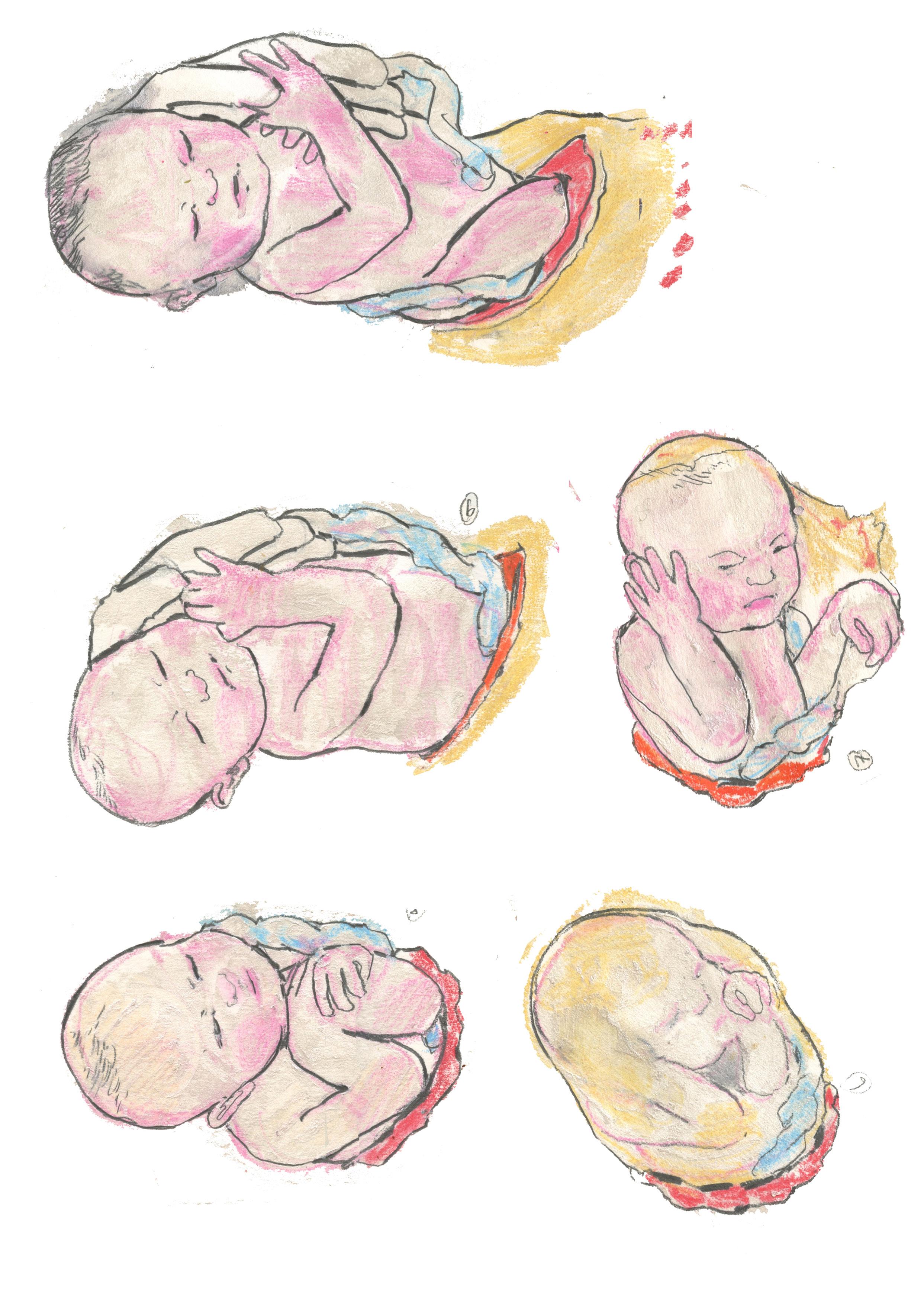
The oil bar process works, but it requires a drying time, and during that window, it can be messy as the material is transferable.
Drawing practices for animation processes.
Throughout my career, I have built a reputation as an efficient illustrator and a creative person who can turn around a job quickly. I have built up a library of surfaces that I return to as a ‘base’ for an image. These include organic coloured shapes, map grids, and ink splatters. Fifteen years ago, I created a wet in wet, grey organic form of about five centimetres across. Scanned at 2400 dots per inch, it has been
featured as a form in many commissioned illustrations. The organic nature of it feels appropriate to the project. It could represent a spongy womb lining, a placenta, or the middle of a cell. It has been digitally recoloured as a full palette (reader 2.) in Photoshop using the colour balancing tool. These colours can be easily slid or placed beneath a line drawing for animation frames, and sections of the colours can be aligned on each other to create a boil effect, making imagery feel alive. The key line drawing can be picked up and placed on top. Making the key line a more saturated colour and not black gives the form a softer and unthreatening feel. From my illustration practice, I avoid using
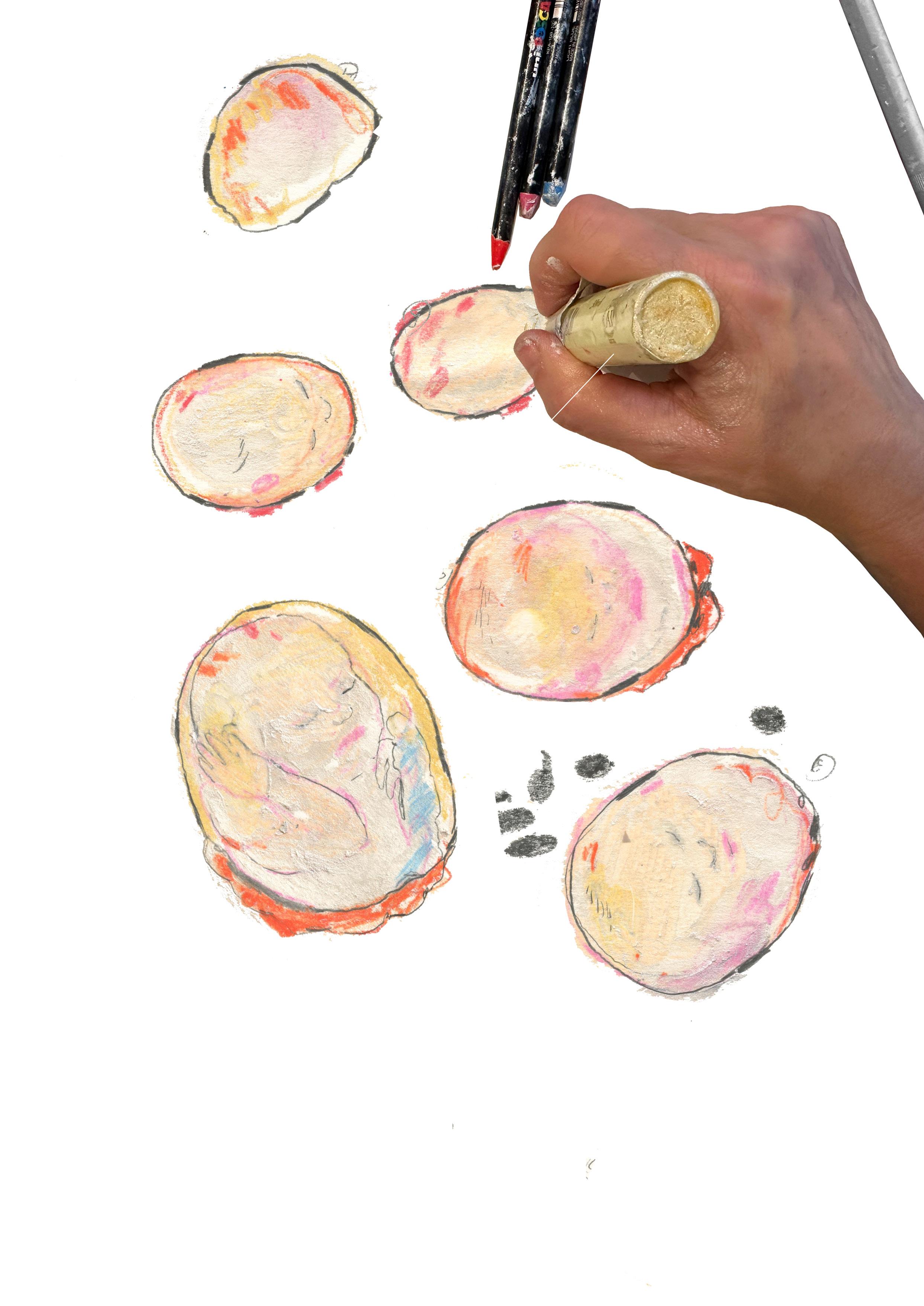
black, but utilising dark graphite grey prevents my drawings from appearing harsh and feeling organic. The test frames of the cells forming and developing in a foetus have been created in sections to be assembled digitally using tweening frames between the keyframes. Having many coloured sections that can be reused is similar to building a library of parts for the project. A consistent visual language will develop from this, and much time can be saved by not having to recolour every time. Next, I need to line-test the frames 59.
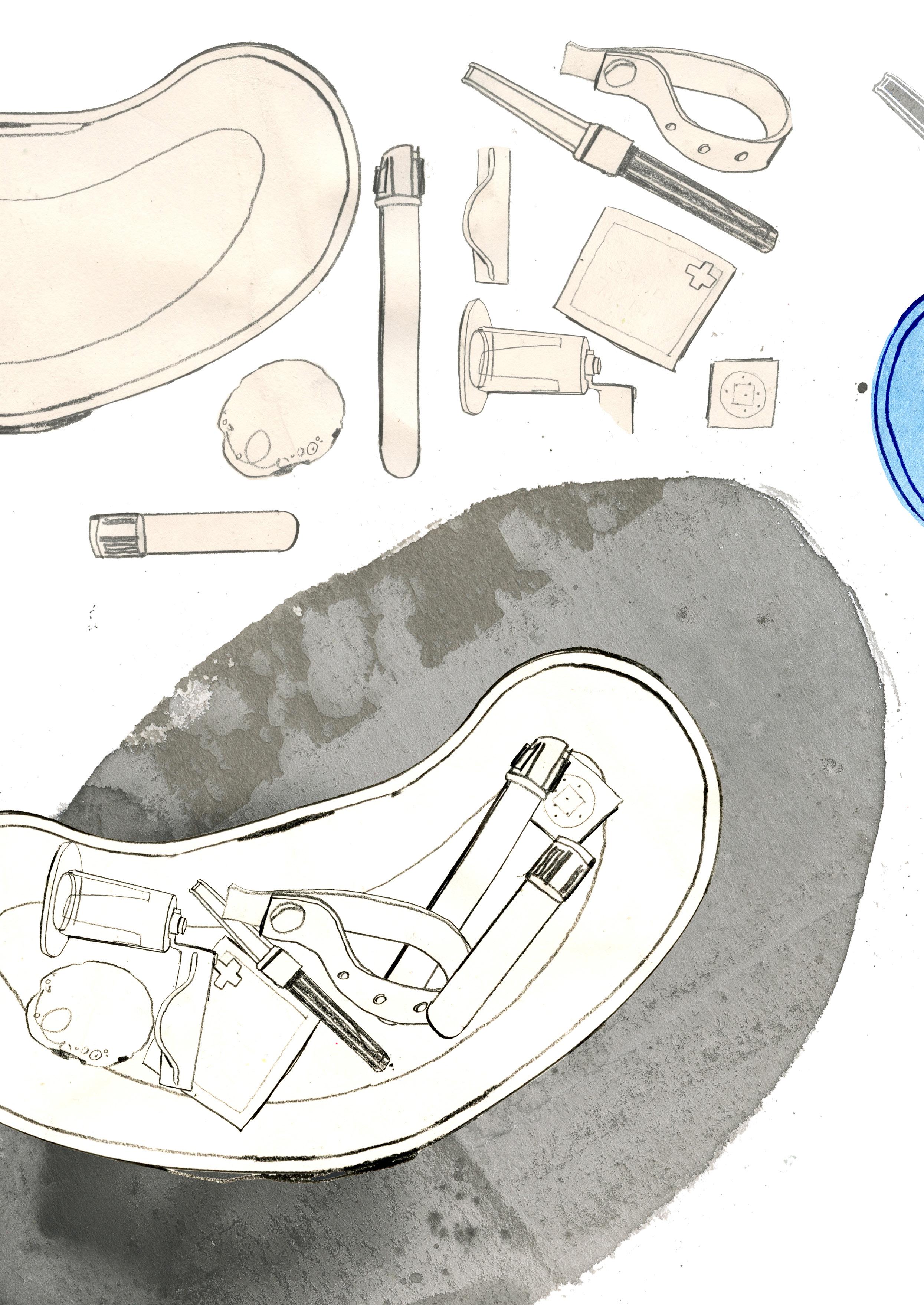
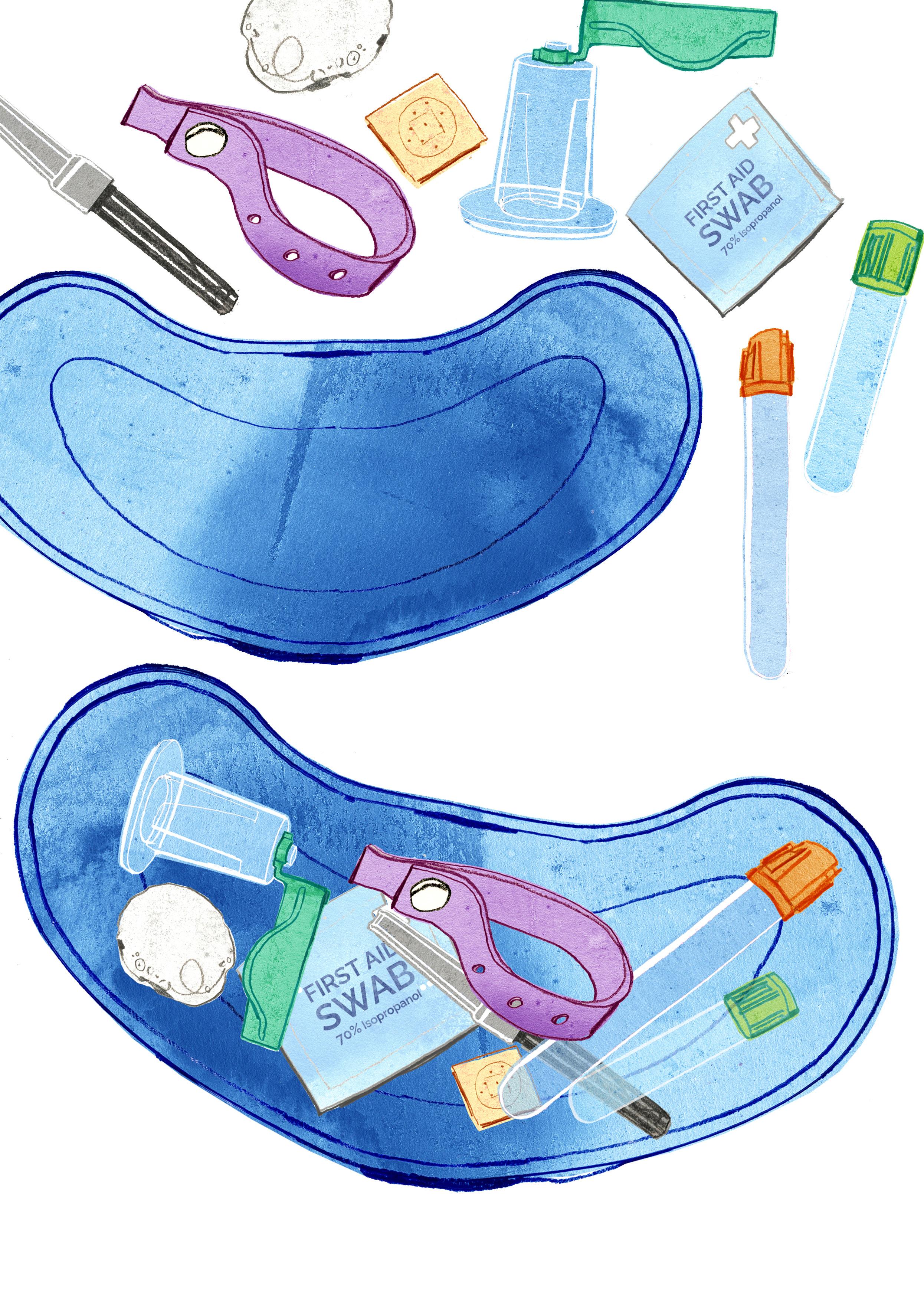
Illustration practice, key line drawings, coloured digitally and placed on coloured grounds as elements for animation frames
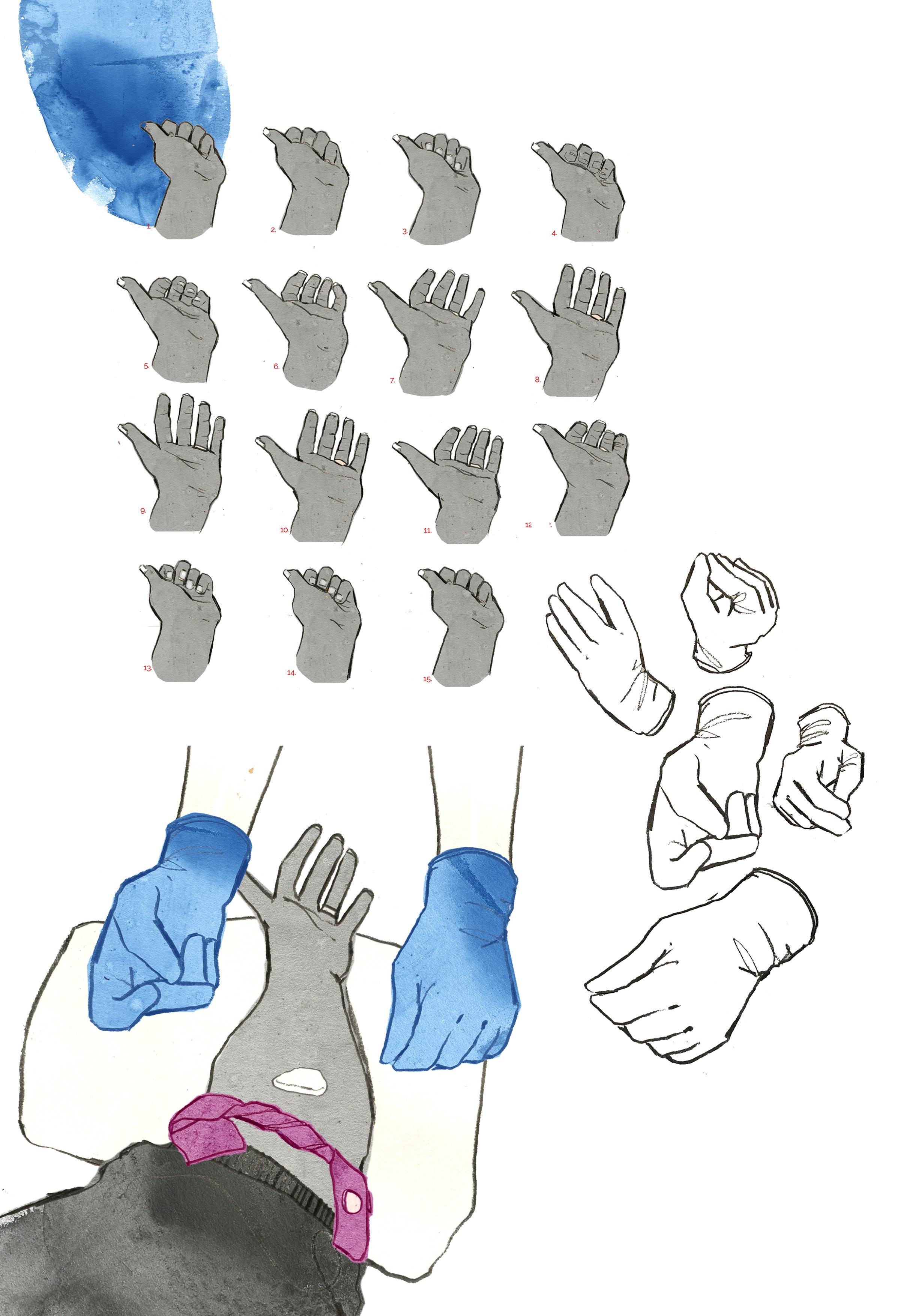
Selected drawings explaining the process of a blood test. The hand fist sequence and the perspective of the patient.
between the keyframes. Having many coloured sections that can be reused is similar to building a library of parts for the project. A consistent visual language will develop from this, and much time can be saved by not having to recolour every time. Next, I need to line-test these frames
and make some glaring colour-wise changes, with the blue foetus disappearing into the grey ground. As a tutor, I always encourage students to test their imagery while ‘suspending judgment’ as if you judge something whilst, in the process of making it, you stop. This practice allows the creative practitioner to create first versions and then reflect on the work’s successes and less successful aspects. I have made several starting points with the foetal development frames, the blood test and the beginning of the c-section stills—my experience as an animator and familiarity with After Effects is developing through the project. This first academic year has provided a testing space to see what feels natural and appropriate to the project, the communication of the process of a developing pregnancy, and where certain aspects can change and different outcomes may occur. The project’s premise being viewed on a phone screen- animation feels appropriate. A baby forming and a baby being delivered, whichever way, are all time-based activities. Pregnancy has three distinct semesters, each with widely different activities occurring. Much misinformation or misunderstanding is situated in the timing of things. How long a pregnancy lasts is debated in other countries. Spontaneous labour can slow down when the Oxytocin flow is interrupted by fear. An induction can take days. The process of a cervix shortening, softening and opening takes time, depending on the body it is happening to.
Your baby is in the neo-natal unit, they have equipment that is helping them, breath, feed and stay warm. This is what they may look like, and what it is doing
Your pregnancy is presenting in a certain way, this short film shows information about it, and the procedures and choices that could treat this.
We are going to move you to another room, which has more specialist equipment, that will look like this, here you can see what it and what it is doing to support you and your baby.
..It would be good for you to look at this visual information, about your upcoming test, and how you can prepare for it.
A cannula goes in like this short animation
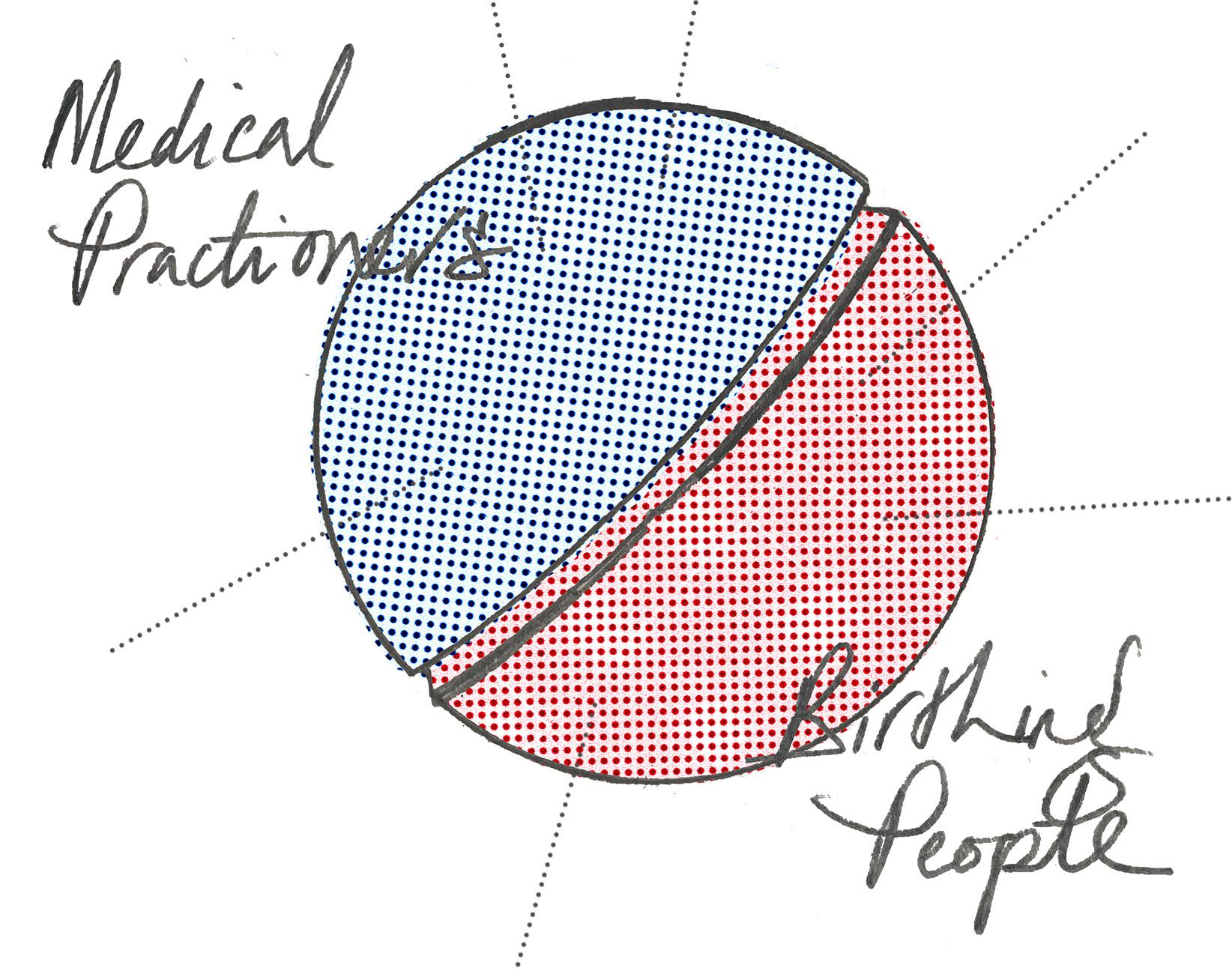
I don’t want a blood test, the needle is massive and don’t you take loads out?
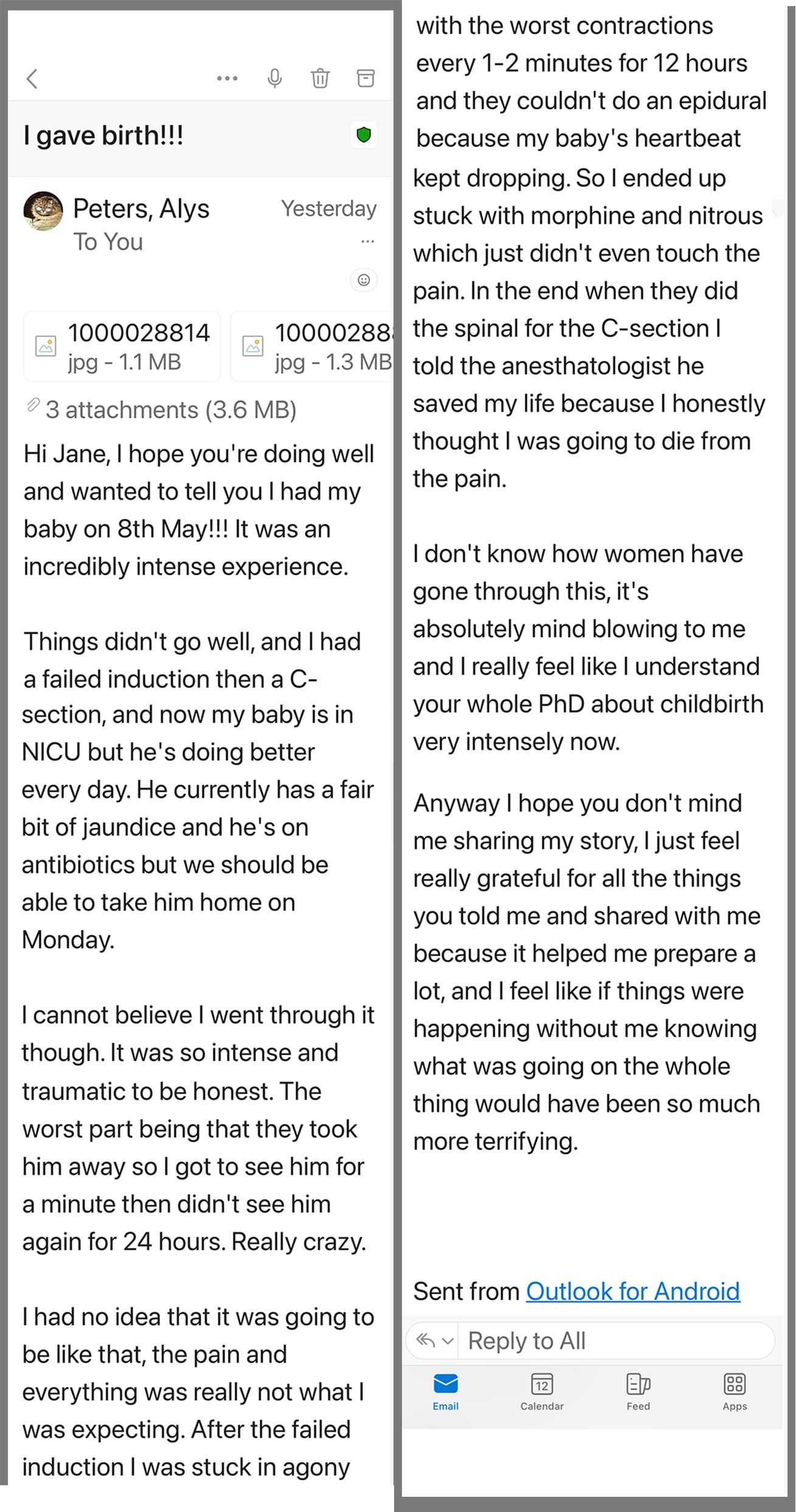
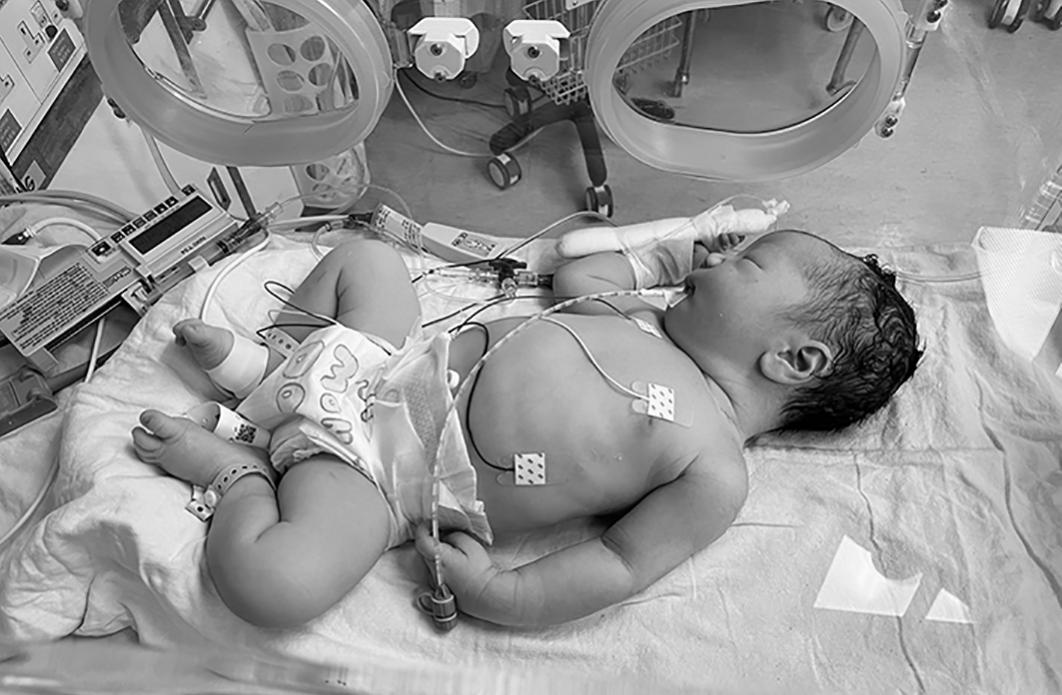
In assembling the information for the IMR, the exercise has been extremely helpful in establishing the ground that I have covered both in the literary review and through illustration animation practice. The original timeline stated that a diary would be an ongoing supporting part of the project. The diary has taken the form of the illustrated readers 1-6, whose linear form has provided a method to communicate the research route. The premise is that I can pass them over to my Mum to read, and she can access the journey and the project’s intention. The conversations I have documented have been with people I already know. The next stage is to apply for ethics clearance to listen to the narratives of people working in and accessing the services of the two South London hospitals with whom I have established relationships for the research to take place. Illustration practice centres around telling and experiencing stories, and visual storytelling encourages reflection, discussion, and various response projects in the writing or visual literature. With its thematic organisation, visual storytelling uses graphic narrative to identify intersections between visual and verbal language and the overarching themes of identity, history, politics, and the arts.
‘Narratives are not static, they are always in a state of development. Stories are context specific and their contents and meaning are apt to change depending on where, how and by whom they are encountered. Once a story is told, its meaning is apt to change and evolve, even if the visual signs that originally represented it are fixed, as is the example of a drawing or animation.’ 1.
I perceive this body of research to look like a two-sided ‘ball.’ On one side sits the perspective and stakeholding of the health professionals. What are the issues and information that are crucial and require communication? What information would they like to access or prefer they have correct and appropriate knowledge? What specialist knowledge- regarding health issues or birth complications would they like visual information to communicate to their patients? For example, midline abnormalities, hernias, and foetal heart issues. What specific demographics affect each South London Hospital- in the communities they serve and support
The other side of the ‘ball’ is the perspective of the patients accessing maternity services. From the pregnancy experience, what information do they want to know about the pregnancy, upcoming birth, and type of birth? What choices could be made more transparent during birth regarding location, type, and birth experience? After the birth experience, what do they wish they had known or felt the information was ‘gatekept’ from them? What do they wish they knew? What imagery could have enabled them to understand the experience more clearly? On the opposite page is Alys’ first birth reflection. I listened with Alys in Reader no 5.
1.
